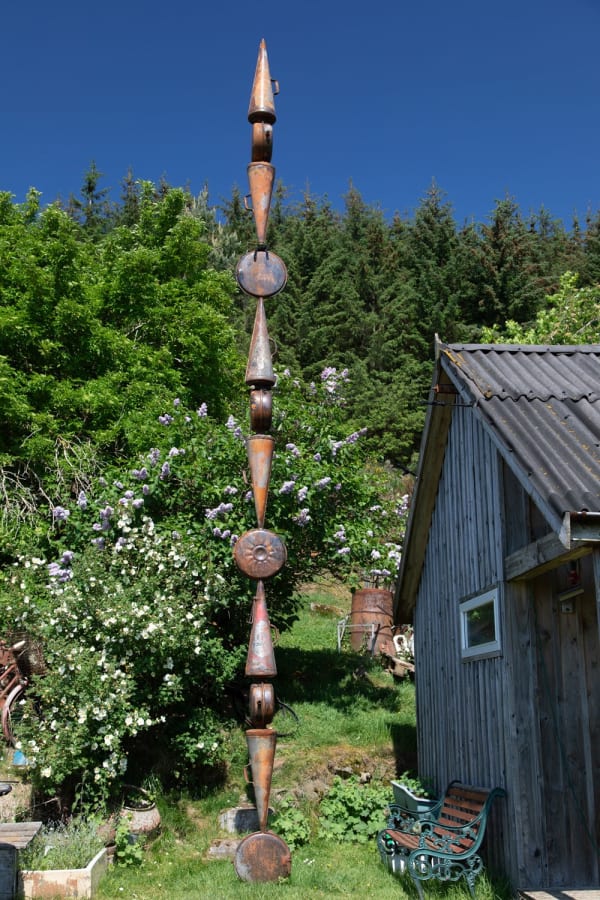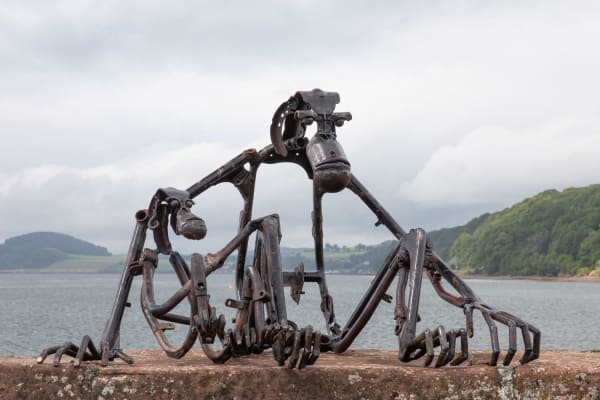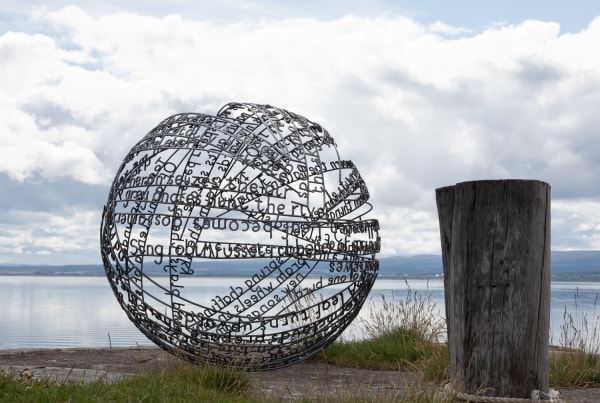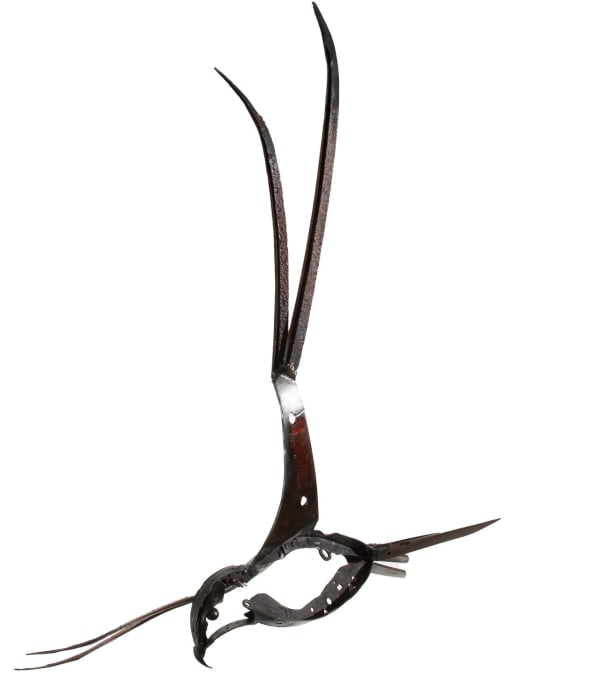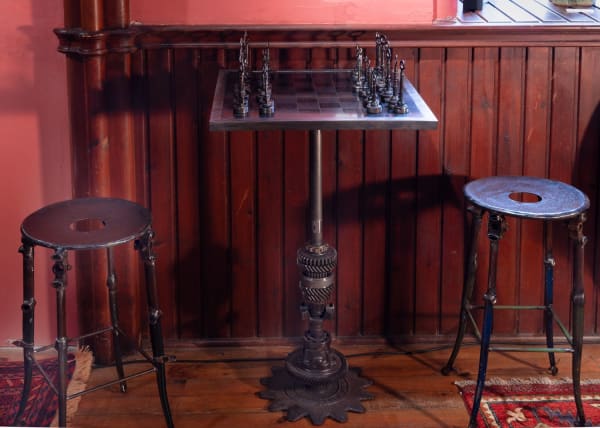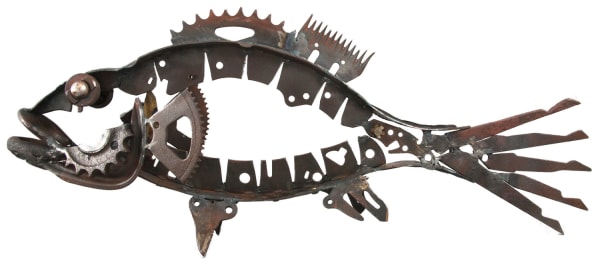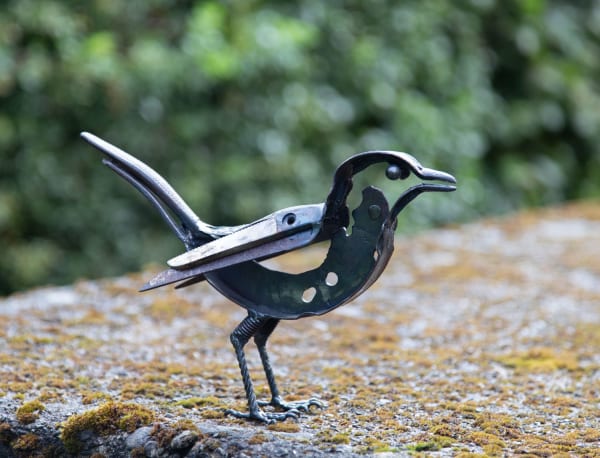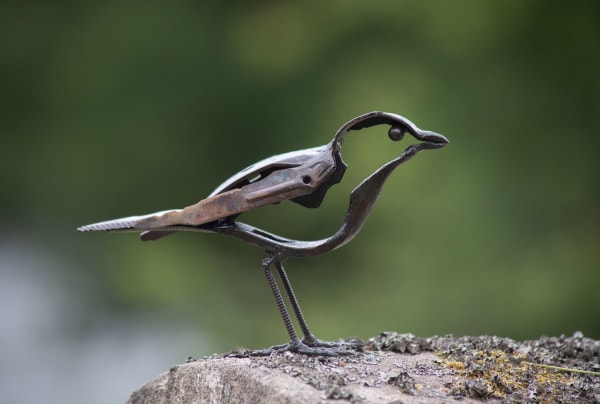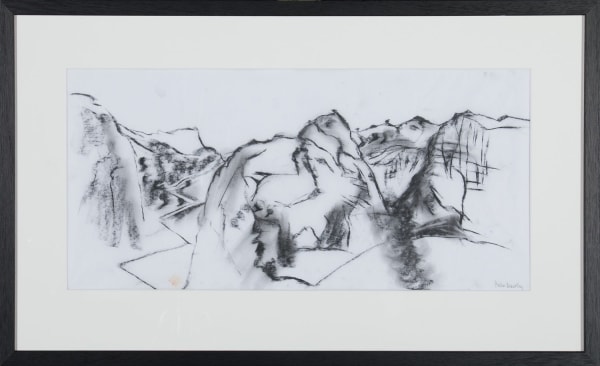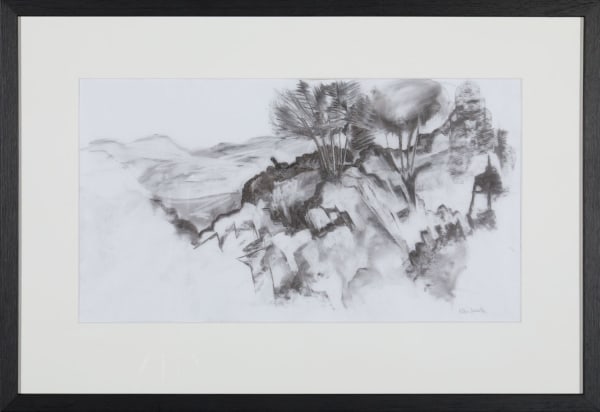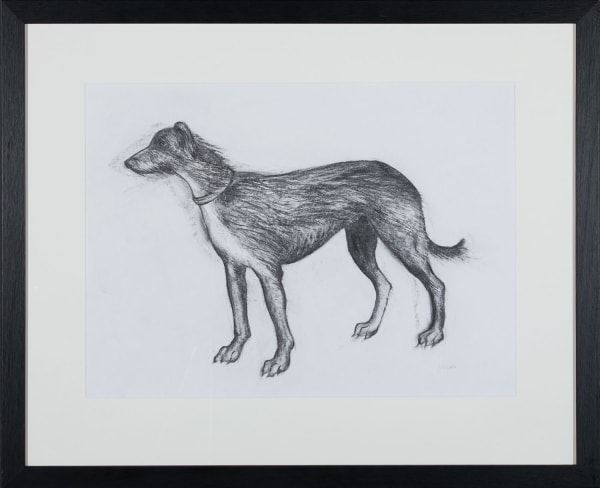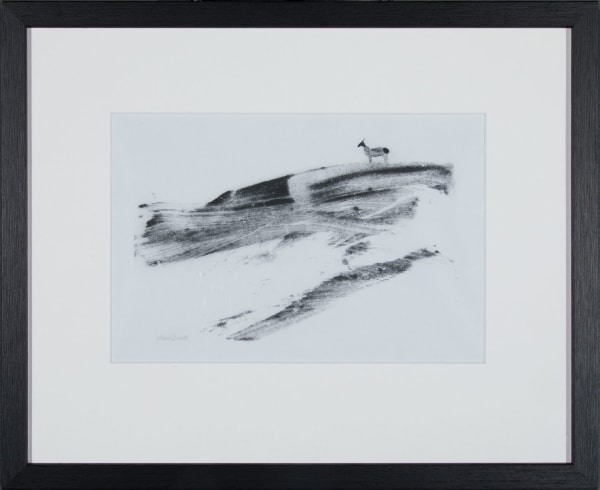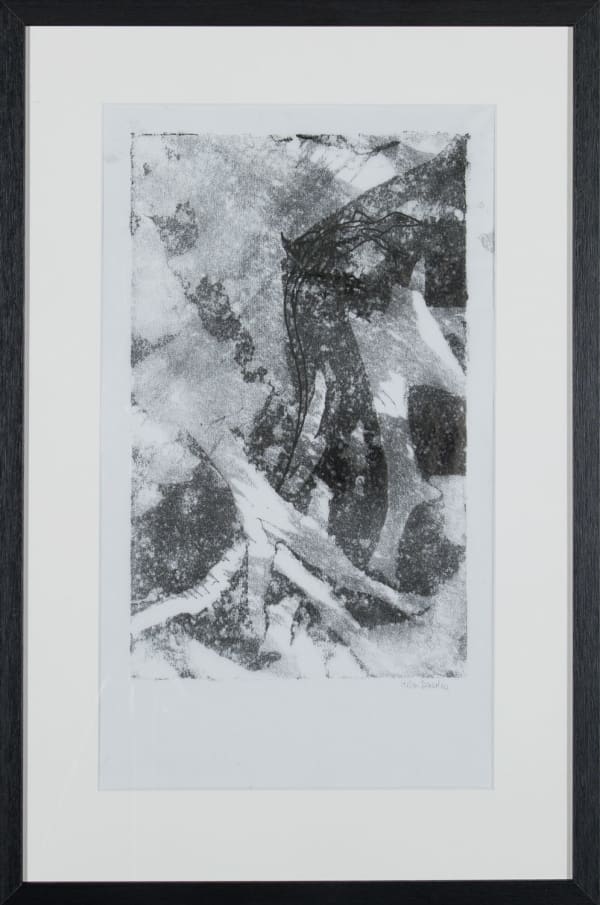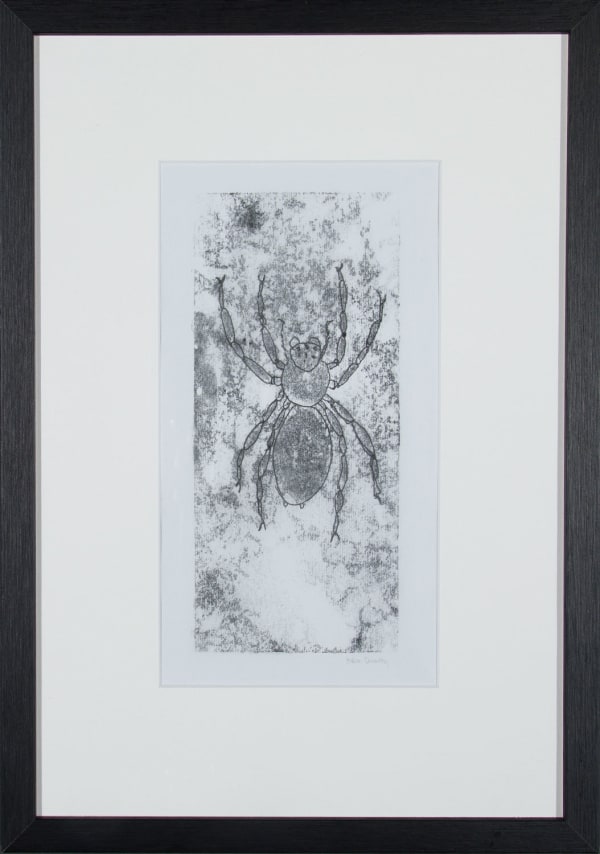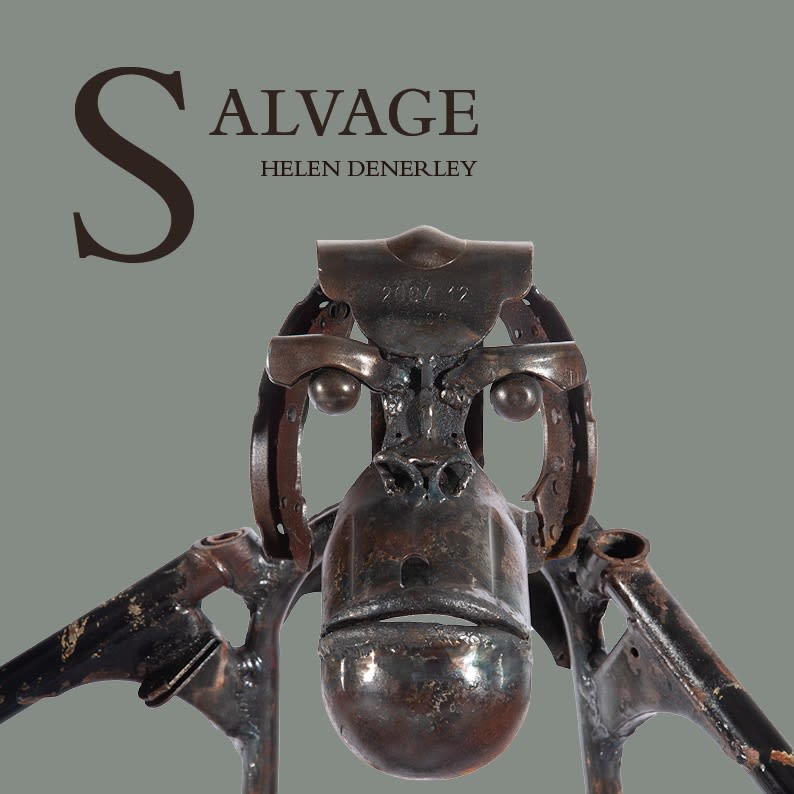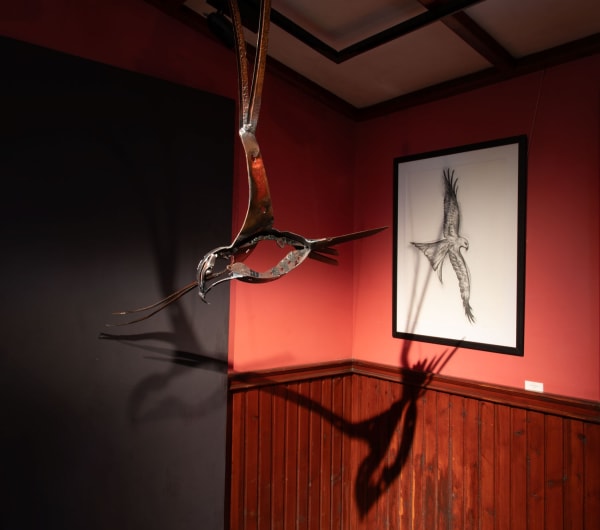HELEN DENERLEY | Salvage: a solo exhibition of new work by Helen Denerley
HELEN DENERLEY | Salvage: a solo exhibition of new work by Helen Denerley
- Works
- Overview
- Publications
- News
- Installation Views
-
Share
- X
- Tumblr
-
 Helen DenerleyInfinity Column, 2023fire extinguishers and boiler expansion tanks6.5m high%3Cdiv%20class%3D%22artist%22%3EHelen%20Denerley%3C/div%3E%3Cdiv%20class%3D%22title_and_year%22%3E%3Cspan%20class%3D%22title_and_year_title%22%3EInfinity%20Column%3C/span%3E%3Cspan%20class%3D%22comma%22%3E%2C%20%3C/span%3E%3Cspan%20class%3D%22title_and_year_year%22%3E2023%3C/span%3E%3C/div%3E%3Cdiv%20class%3D%22medium%22%3Efire%20extinguishers%20and%20boiler%20expansion%20tanks%3C/div%3E%3Cdiv%20class%3D%22dimensions%22%3E6.5m%20high%3C/div%3E
Helen DenerleyInfinity Column, 2023fire extinguishers and boiler expansion tanks6.5m high%3Cdiv%20class%3D%22artist%22%3EHelen%20Denerley%3C/div%3E%3Cdiv%20class%3D%22title_and_year%22%3E%3Cspan%20class%3D%22title_and_year_title%22%3EInfinity%20Column%3C/span%3E%3Cspan%20class%3D%22comma%22%3E%2C%20%3C/span%3E%3Cspan%20class%3D%22title_and_year_year%22%3E2023%3C/span%3E%3C/div%3E%3Cdiv%20class%3D%22medium%22%3Efire%20extinguishers%20and%20boiler%20expansion%20tanks%3C/div%3E%3Cdiv%20class%3D%22dimensions%22%3E6.5m%20high%3C/div%3E
-
 Helen DenerleyGiant spider, 2023combine harvester dividers, gas guns, tanks and barbeque lid3.3m high£ 33,000.00%3Cdiv%20class%3D%22artist%22%3EHelen%20Denerley%3C/div%3E%3Cdiv%20class%3D%22title_and_year%22%3E%3Cspan%20class%3D%22title_and_year_title%22%3EGiant%20spider%3C/span%3E%3Cspan%20class%3D%22comma%22%3E%2C%20%3C/span%3E%3Cspan%20class%3D%22title_and_year_year%22%3E2023%3C/span%3E%3C/div%3E%3Cdiv%20class%3D%22medium%22%3Ecombine%20harvester%20dividers%3Cspan%20class%3D%22comma%22%3E%2C%20%3C/span%3Egas%20guns%3Cspan%20class%3D%22comma%22%3E%2C%20%3C/span%3Etanks%20and%20barbeque%20lid%3C/div%3E%3Cdiv%20class%3D%22dimensions%22%3E3.3m%20high%3C/div%3E
Helen DenerleyGiant spider, 2023combine harvester dividers, gas guns, tanks and barbeque lid3.3m high£ 33,000.00%3Cdiv%20class%3D%22artist%22%3EHelen%20Denerley%3C/div%3E%3Cdiv%20class%3D%22title_and_year%22%3E%3Cspan%20class%3D%22title_and_year_title%22%3EGiant%20spider%3C/span%3E%3Cspan%20class%3D%22comma%22%3E%2C%20%3C/span%3E%3Cspan%20class%3D%22title_and_year_year%22%3E2023%3C/span%3E%3C/div%3E%3Cdiv%20class%3D%22medium%22%3Ecombine%20harvester%20dividers%3Cspan%20class%3D%22comma%22%3E%2C%20%3C/span%3Egas%20guns%3Cspan%20class%3D%22comma%22%3E%2C%20%3C/span%3Etanks%20and%20barbeque%20lid%3C/div%3E%3Cdiv%20class%3D%22dimensions%22%3E3.3m%20high%3C/div%3E
-
 Helen DenerleyMale orangutan, 2023120cm (h) x 90cm x 45cmold British motorbikes, tilly lamp and scaffold parts£ 16,000.00%3Cdiv%20class%3D%22artist%22%3EHelen%20Denerley%3C/div%3E%3Cdiv%20class%3D%22title_and_year%22%3E%3Cspan%20class%3D%22title_and_year_title%22%3EMale%20orangutan%3C/span%3E%3Cspan%20class%3D%22comma%22%3E%2C%20%3C/span%3E%3Cspan%20class%3D%22title_and_year_year%22%3E2023%3C/span%3E%3C/div%3E%3Cdiv%20class%3D%22medium%22%3E120cm%20%28h%29%20x%2090cm%20x%2045cm%3C/div%3E%3Cdiv%20class%3D%22dimensions%22%3Eold%20British%20motorbikes%3Cspan%20class%3D%22comma%22%3E%2C%20%3C/span%3Etilly%20lamp%20and%20scaffold%20parts%3C/div%3E
Helen DenerleyMale orangutan, 2023120cm (h) x 90cm x 45cmold British motorbikes, tilly lamp and scaffold parts£ 16,000.00%3Cdiv%20class%3D%22artist%22%3EHelen%20Denerley%3C/div%3E%3Cdiv%20class%3D%22title_and_year%22%3E%3Cspan%20class%3D%22title_and_year_title%22%3EMale%20orangutan%3C/span%3E%3Cspan%20class%3D%22comma%22%3E%2C%20%3C/span%3E%3Cspan%20class%3D%22title_and_year_year%22%3E2023%3C/span%3E%3C/div%3E%3Cdiv%20class%3D%22medium%22%3E120cm%20%28h%29%20x%2090cm%20x%2045cm%3C/div%3E%3Cdiv%20class%3D%22dimensions%22%3Eold%20British%20motorbikes%3Cspan%20class%3D%22comma%22%3E%2C%20%3C/span%3Etilly%20lamp%20and%20scaffold%20parts%3C/div%3E
-
 Helen DenerleyMother and baby orangutan, 2023old British motorbike frames, brake shoes, scaffolding parts, bolts, bells.66cm (h) x 114cm x 74cm£ 16,000.00%3Cdiv%20class%3D%22artist%22%3EHelen%20Denerley%3C/div%3E%3Cdiv%20class%3D%22title_and_year%22%3E%3Cspan%20class%3D%22title_and_year_title%22%3EMother%20and%20baby%20orangutan%3C/span%3E%3Cspan%20class%3D%22comma%22%3E%2C%20%3C/span%3E%3Cspan%20class%3D%22title_and_year_year%22%3E2023%3C/span%3E%3C/div%3E%3Cdiv%20class%3D%22medium%22%3Eold%20British%20motorbike%20frames%3Cspan%20class%3D%22comma%22%3E%2C%20%3C/span%3Ebrake%20shoes%3Cspan%20class%3D%22comma%22%3E%2C%20%3C/span%3Escaffolding%20parts%3Cspan%20class%3D%22comma%22%3E%2C%20%3C/span%3Ebolts%3Cspan%20class%3D%22comma%22%3E%2C%20%3C/span%3Ebells.%3C/div%3E%3Cdiv%20class%3D%22dimensions%22%3E66cm%20%28h%29%20x%20114cm%20x%2074cm%3C/div%3E
Helen DenerleyMother and baby orangutan, 2023old British motorbike frames, brake shoes, scaffolding parts, bolts, bells.66cm (h) x 114cm x 74cm£ 16,000.00%3Cdiv%20class%3D%22artist%22%3EHelen%20Denerley%3C/div%3E%3Cdiv%20class%3D%22title_and_year%22%3E%3Cspan%20class%3D%22title_and_year_title%22%3EMother%20and%20baby%20orangutan%3C/span%3E%3Cspan%20class%3D%22comma%22%3E%2C%20%3C/span%3E%3Cspan%20class%3D%22title_and_year_year%22%3E2023%3C/span%3E%3C/div%3E%3Cdiv%20class%3D%22medium%22%3Eold%20British%20motorbike%20frames%3Cspan%20class%3D%22comma%22%3E%2C%20%3C/span%3Ebrake%20shoes%3Cspan%20class%3D%22comma%22%3E%2C%20%3C/span%3Escaffolding%20parts%3Cspan%20class%3D%22comma%22%3E%2C%20%3C/span%3Ebolts%3Cspan%20class%3D%22comma%22%3E%2C%20%3C/span%3Ebells.%3C/div%3E%3Cdiv%20class%3D%22dimensions%22%3E66cm%20%28h%29%20x%20114cm%20x%2074cm%3C/div%3E
-
 Helen DenerleyHaiku sphere, 2023mild-steel rod100cm x 100cm x 100cm%3Cdiv%20class%3D%22artist%22%3EHelen%20Denerley%3C/div%3E%3Cdiv%20class%3D%22title_and_year%22%3E%3Cspan%20class%3D%22title_and_year_title%22%3EHaiku%20sphere%3C/span%3E%3Cspan%20class%3D%22comma%22%3E%2C%20%3C/span%3E%3Cspan%20class%3D%22title_and_year_year%22%3E2023%3C/span%3E%3C/div%3E%3Cdiv%20class%3D%22medium%22%3Emild-steel%20rod%3C/div%3E%3Cdiv%20class%3D%22dimensions%22%3E100cm%20x%20100cm%20x%20100cm%3C/div%3E
Helen DenerleyHaiku sphere, 2023mild-steel rod100cm x 100cm x 100cm%3Cdiv%20class%3D%22artist%22%3EHelen%20Denerley%3C/div%3E%3Cdiv%20class%3D%22title_and_year%22%3E%3Cspan%20class%3D%22title_and_year_title%22%3EHaiku%20sphere%3C/span%3E%3Cspan%20class%3D%22comma%22%3E%2C%20%3C/span%3E%3Cspan%20class%3D%22title_and_year_year%22%3E2023%3C/span%3E%3C/div%3E%3Cdiv%20class%3D%22medium%22%3Emild-steel%20rod%3C/div%3E%3Cdiv%20class%3D%22dimensions%22%3E100cm%20x%20100cm%20x%20100cm%3C/div%3E
-
 Helen DenerleyGoat i, 2023agricultural scrap, bicycle and scaffolding parts, hammers73cm (h) x 103cm x 32cm%3Cdiv%20class%3D%22artist%22%3EHelen%20Denerley%3C/div%3E%3Cdiv%20class%3D%22title_and_year%22%3E%3Cspan%20class%3D%22title_and_year_title%22%3EGoat%20i%3C/span%3E%3Cspan%20class%3D%22comma%22%3E%2C%20%3C/span%3E%3Cspan%20class%3D%22title_and_year_year%22%3E2023%3C/span%3E%3C/div%3E%3Cdiv%20class%3D%22medium%22%3Eagricultural%20scrap%3Cspan%20class%3D%22comma%22%3E%2C%20%3C/span%3Ebicycle%20and%20scaffolding%20parts%3Cspan%20class%3D%22comma%22%3E%2C%20%3C/span%3Ehammers%3C/div%3E%3Cdiv%20class%3D%22dimensions%22%3E73cm%20%28h%29%20x%20103cm%20x%2032cm%3C/div%3E
Helen DenerleyGoat i, 2023agricultural scrap, bicycle and scaffolding parts, hammers73cm (h) x 103cm x 32cm%3Cdiv%20class%3D%22artist%22%3EHelen%20Denerley%3C/div%3E%3Cdiv%20class%3D%22title_and_year%22%3E%3Cspan%20class%3D%22title_and_year_title%22%3EGoat%20i%3C/span%3E%3Cspan%20class%3D%22comma%22%3E%2C%20%3C/span%3E%3Cspan%20class%3D%22title_and_year_year%22%3E2023%3C/span%3E%3C/div%3E%3Cdiv%20class%3D%22medium%22%3Eagricultural%20scrap%3Cspan%20class%3D%22comma%22%3E%2C%20%3C/span%3Ebicycle%20and%20scaffolding%20parts%3Cspan%20class%3D%22comma%22%3E%2C%20%3C/span%3Ehammers%3C/div%3E%3Cdiv%20class%3D%22dimensions%22%3E73cm%20%28h%29%20x%20103cm%20x%2032cm%3C/div%3E
-
 Helen DenerleyGoat ii, 2023agricultural scrap, bicycle and scaffolding parts, hammers72cm (h) x 111cm x 38cm%3Cdiv%20class%3D%22artist%22%3EHelen%20Denerley%3C/div%3E%3Cdiv%20class%3D%22title_and_year%22%3E%3Cspan%20class%3D%22title_and_year_title%22%3EGoat%20ii%3C/span%3E%3Cspan%20class%3D%22comma%22%3E%2C%20%3C/span%3E%3Cspan%20class%3D%22title_and_year_year%22%3E2023%3C/span%3E%3C/div%3E%3Cdiv%20class%3D%22medium%22%3Eagricultural%20scrap%3Cspan%20class%3D%22comma%22%3E%2C%20%3C/span%3Ebicycle%20and%20scaffolding%20parts%3Cspan%20class%3D%22comma%22%3E%2C%20%3C/span%3Ehammers%3C/div%3E%3Cdiv%20class%3D%22dimensions%22%3E72cm%20%28h%29%20x%20111cm%20x%2038cm%3C/div%3E
Helen DenerleyGoat ii, 2023agricultural scrap, bicycle and scaffolding parts, hammers72cm (h) x 111cm x 38cm%3Cdiv%20class%3D%22artist%22%3EHelen%20Denerley%3C/div%3E%3Cdiv%20class%3D%22title_and_year%22%3E%3Cspan%20class%3D%22title_and_year_title%22%3EGoat%20ii%3C/span%3E%3Cspan%20class%3D%22comma%22%3E%2C%20%3C/span%3E%3Cspan%20class%3D%22title_and_year_year%22%3E2023%3C/span%3E%3C/div%3E%3Cdiv%20class%3D%22medium%22%3Eagricultural%20scrap%3Cspan%20class%3D%22comma%22%3E%2C%20%3C/span%3Ebicycle%20and%20scaffolding%20parts%3Cspan%20class%3D%22comma%22%3E%2C%20%3C/span%3Ehammers%3C/div%3E%3Cdiv%20class%3D%22dimensions%22%3E72cm%20%28h%29%20x%20111cm%20x%2038cm%3C/div%3E
-
 Helen DenerleyFound object chess set, table and chairs, 2023drills, meat-grinders and agricultural scrapKing 47cm high, board 120cm x 120cm£ 15,000.00%3Cdiv%20class%3D%22artist%22%3EHelen%20Denerley%3C/div%3E%3Cdiv%20class%3D%22title_and_year%22%3E%3Cspan%20class%3D%22title_and_year_title%22%3EFound%20object%20chess%20set%3Cspan%20class%3D%22comma%22%3E%2C%20%3C/span%3Etable%20and%20chairs%3C/span%3E%3Cspan%20class%3D%22comma%22%3E%2C%20%3C/span%3E%3Cspan%20class%3D%22title_and_year_year%22%3E2023%3C/span%3E%3C/div%3E%3Cdiv%20class%3D%22medium%22%3Edrills%3Cspan%20class%3D%22comma%22%3E%2C%20%3C/span%3Emeat-grinders%20and%20agricultural%20scrap%3C/div%3E%3Cdiv%20class%3D%22dimensions%22%3EKing%2047cm%20high%3Cspan%20class%3D%22comma%22%3E%2C%20%3C/span%3Eboard%20120cm%20x%20120cm%3C/div%3E
Helen DenerleyFound object chess set, table and chairs, 2023drills, meat-grinders and agricultural scrapKing 47cm high, board 120cm x 120cm£ 15,000.00%3Cdiv%20class%3D%22artist%22%3EHelen%20Denerley%3C/div%3E%3Cdiv%20class%3D%22title_and_year%22%3E%3Cspan%20class%3D%22title_and_year_title%22%3EFound%20object%20chess%20set%3Cspan%20class%3D%22comma%22%3E%2C%20%3C/span%3Etable%20and%20chairs%3C/span%3E%3Cspan%20class%3D%22comma%22%3E%2C%20%3C/span%3E%3Cspan%20class%3D%22title_and_year_year%22%3E2023%3C/span%3E%3C/div%3E%3Cdiv%20class%3D%22medium%22%3Edrills%3Cspan%20class%3D%22comma%22%3E%2C%20%3C/span%3Emeat-grinders%20and%20agricultural%20scrap%3C/div%3E%3Cdiv%20class%3D%22dimensions%22%3EKing%2047cm%20high%3Cspan%20class%3D%22comma%22%3E%2C%20%3C/span%3Eboard%20120cm%20x%20120cm%3C/div%3E
-
 Helen DenerleyLurcher ii, 2019scrap metal133cm x 72cm (h) x 25cmSold%3Cdiv%20class%3D%22artist%22%3EHelen%20Denerley%3C/div%3E%3Cdiv%20class%3D%22title_and_year%22%3E%3Cspan%20class%3D%22title_and_year_title%22%3ELurcher%20ii%3C/span%3E%3Cspan%20class%3D%22comma%22%3E%2C%20%3C/span%3E%3Cspan%20class%3D%22title_and_year_year%22%3E2019%3C/span%3E%3C/div%3E%3Cdiv%20class%3D%22medium%22%3Escrap%20metal%3C/div%3E%3Cdiv%20class%3D%22dimensions%22%3E133cm%20x%2072cm%20%28h%29%20x%2025cm%3C/div%3E
Helen DenerleyLurcher ii, 2019scrap metal133cm x 72cm (h) x 25cmSold%3Cdiv%20class%3D%22artist%22%3EHelen%20Denerley%3C/div%3E%3Cdiv%20class%3D%22title_and_year%22%3E%3Cspan%20class%3D%22title_and_year_title%22%3ELurcher%20ii%3C/span%3E%3Cspan%20class%3D%22comma%22%3E%2C%20%3C/span%3E%3Cspan%20class%3D%22title_and_year_year%22%3E2019%3C/span%3E%3C/div%3E%3Cdiv%20class%3D%22medium%22%3Escrap%20metal%3C/div%3E%3Cdiv%20class%3D%22dimensions%22%3E133cm%20x%2072cm%20%28h%29%20x%2025cm%3C/div%3E
-
 Helen DenerleyRed Kite, 2023agricultural parts, brake shoes and scythes110cm (h) x 143cm x 69cmSold%3Cdiv%20class%3D%22artist%22%3EHelen%20Denerley%3C/div%3E%3Cdiv%20class%3D%22title_and_year%22%3E%3Cspan%20class%3D%22title_and_year_title%22%3ERed%20Kite%3C/span%3E%3Cspan%20class%3D%22comma%22%3E%2C%20%3C/span%3E%3Cspan%20class%3D%22title_and_year_year%22%3E2023%3C/span%3E%3C/div%3E%3Cdiv%20class%3D%22medium%22%3Eagricultural%20parts%3Cspan%20class%3D%22comma%22%3E%2C%20%3C/span%3Ebrake%20shoes%20and%20scythes%3C/div%3E%3Cdiv%20class%3D%22dimensions%22%3E110cm%20%28h%29%20x%20143cm%20x%2069cm%3C/div%3E
Helen DenerleyRed Kite, 2023agricultural parts, brake shoes and scythes110cm (h) x 143cm x 69cmSold%3Cdiv%20class%3D%22artist%22%3EHelen%20Denerley%3C/div%3E%3Cdiv%20class%3D%22title_and_year%22%3E%3Cspan%20class%3D%22title_and_year_title%22%3ERed%20Kite%3C/span%3E%3Cspan%20class%3D%22comma%22%3E%2C%20%3C/span%3E%3Cspan%20class%3D%22title_and_year_year%22%3E2023%3C/span%3E%3C/div%3E%3Cdiv%20class%3D%22medium%22%3Eagricultural%20parts%3Cspan%20class%3D%22comma%22%3E%2C%20%3C/span%3Ebrake%20shoes%20and%20scythes%3C/div%3E%3Cdiv%20class%3D%22dimensions%22%3E110cm%20%28h%29%20x%20143cm%20x%2069cm%3C/div%3E
-
 Helen DenerleyCaliper Moth, 2023calipers, brake discs, clutch plates and silencer113cm (h) x 248cm%3Cdiv%20class%3D%22artist%22%3EHelen%20Denerley%3C/div%3E%3Cdiv%20class%3D%22title_and_year%22%3E%3Cspan%20class%3D%22title_and_year_title%22%3ECaliper%20Moth%3C/span%3E%3Cspan%20class%3D%22comma%22%3E%2C%20%3C/span%3E%3Cspan%20class%3D%22title_and_year_year%22%3E2023%3C/span%3E%3C/div%3E%3Cdiv%20class%3D%22medium%22%3Ecalipers%3Cspan%20class%3D%22comma%22%3E%2C%20%3C/span%3Ebrake%20discs%3Cspan%20class%3D%22comma%22%3E%2C%20%3C/span%3Eclutch%20plates%20and%20silencer%3C/div%3E%3Cdiv%20class%3D%22dimensions%22%3E113cm%20%28h%29%20x%20248cm%3C/div%3E
Helen DenerleyCaliper Moth, 2023calipers, brake discs, clutch plates and silencer113cm (h) x 248cm%3Cdiv%20class%3D%22artist%22%3EHelen%20Denerley%3C/div%3E%3Cdiv%20class%3D%22title_and_year%22%3E%3Cspan%20class%3D%22title_and_year_title%22%3ECaliper%20Moth%3C/span%3E%3Cspan%20class%3D%22comma%22%3E%2C%20%3C/span%3E%3Cspan%20class%3D%22title_and_year_year%22%3E2023%3C/span%3E%3C/div%3E%3Cdiv%20class%3D%22medium%22%3Ecalipers%3Cspan%20class%3D%22comma%22%3E%2C%20%3C/span%3Ebrake%20discs%3Cspan%20class%3D%22comma%22%3E%2C%20%3C/span%3Eclutch%20plates%20and%20silencer%3C/div%3E%3Cdiv%20class%3D%22dimensions%22%3E113cm%20%28h%29%20x%20248cm%3C/div%3E
-
 Helen DenerleyPlier Pollinator, 2023pliers, bike parts, motorbike spring, agricultral springs and brakeshoes107cm (h) x 104cm%3Cdiv%20class%3D%22artist%22%3EHelen%20Denerley%3C/div%3E%3Cdiv%20class%3D%22title_and_year%22%3E%3Cspan%20class%3D%22title_and_year_title%22%3EPlier%20Pollinator%3C/span%3E%3Cspan%20class%3D%22comma%22%3E%2C%20%3C/span%3E%3Cspan%20class%3D%22title_and_year_year%22%3E2023%3C/span%3E%3C/div%3E%3Cdiv%20class%3D%22medium%22%3Epliers%3Cspan%20class%3D%22comma%22%3E%2C%20%3C/span%3Ebike%20parts%3Cspan%20class%3D%22comma%22%3E%2C%20%3C/span%3Emotorbike%20spring%3Cspan%20class%3D%22comma%22%3E%2C%20%3C/span%3Eagricultral%20springs%20and%20brakeshoes%3C/div%3E%3Cdiv%20class%3D%22dimensions%22%3E107cm%20%28h%29%20x%20104cm%3C/div%3E
Helen DenerleyPlier Pollinator, 2023pliers, bike parts, motorbike spring, agricultral springs and brakeshoes107cm (h) x 104cm%3Cdiv%20class%3D%22artist%22%3EHelen%20Denerley%3C/div%3E%3Cdiv%20class%3D%22title_and_year%22%3E%3Cspan%20class%3D%22title_and_year_title%22%3EPlier%20Pollinator%3C/span%3E%3Cspan%20class%3D%22comma%22%3E%2C%20%3C/span%3E%3Cspan%20class%3D%22title_and_year_year%22%3E2023%3C/span%3E%3C/div%3E%3Cdiv%20class%3D%22medium%22%3Epliers%3Cspan%20class%3D%22comma%22%3E%2C%20%3C/span%3Ebike%20parts%3Cspan%20class%3D%22comma%22%3E%2C%20%3C/span%3Emotorbike%20spring%3Cspan%20class%3D%22comma%22%3E%2C%20%3C/span%3Eagricultral%20springs%20and%20brakeshoes%3C/div%3E%3Cdiv%20class%3D%22dimensions%22%3E107cm%20%28h%29%20x%20104cm%3C/div%3E
-
 Helen DenerleyBicycle Butterfly, 2022scrap metal120cm (h) x 137cmSold%3Cdiv%20class%3D%22artist%22%3EHelen%20Denerley%3C/div%3E%3Cdiv%20class%3D%22title_and_year%22%3E%3Cspan%20class%3D%22title_and_year_title%22%3EBicycle%20Butterfly%3C/span%3E%3Cspan%20class%3D%22comma%22%3E%2C%20%3C/span%3E%3Cspan%20class%3D%22title_and_year_year%22%3E2022%3C/span%3E%3C/div%3E%3Cdiv%20class%3D%22medium%22%3Escrap%20metal%3C/div%3E%3Cdiv%20class%3D%22dimensions%22%3E120cm%20%28h%29%20x%20137cm%3C/div%3E
Helen DenerleyBicycle Butterfly, 2022scrap metal120cm (h) x 137cmSold%3Cdiv%20class%3D%22artist%22%3EHelen%20Denerley%3C/div%3E%3Cdiv%20class%3D%22title_and_year%22%3E%3Cspan%20class%3D%22title_and_year_title%22%3EBicycle%20Butterfly%3C/span%3E%3Cspan%20class%3D%22comma%22%3E%2C%20%3C/span%3E%3Cspan%20class%3D%22title_and_year_year%22%3E2022%3C/span%3E%3C/div%3E%3Cdiv%20class%3D%22medium%22%3Escrap%20metal%3C/div%3E%3Cdiv%20class%3D%22dimensions%22%3E120cm%20%28h%29%20x%20137cm%3C/div%3E
-
 Helen DenerleySilent Moth, 2023silencer, dairy equipment, paraffin lamp and filter138cm x 74cm x 20cm%3Cdiv%20class%3D%22artist%22%3EHelen%20Denerley%3C/div%3E%3Cdiv%20class%3D%22title_and_year%22%3E%3Cspan%20class%3D%22title_and_year_title%22%3ESilent%20Moth%3C/span%3E%3Cspan%20class%3D%22comma%22%3E%2C%20%3C/span%3E%3Cspan%20class%3D%22title_and_year_year%22%3E2023%3C/span%3E%3C/div%3E%3Cdiv%20class%3D%22medium%22%3Esilencer%3Cspan%20class%3D%22comma%22%3E%2C%20%3C/span%3Edairy%20equipment%3Cspan%20class%3D%22comma%22%3E%2C%20%3C/span%3Eparaffin%20lamp%20and%20filter%3C/div%3E%3Cdiv%20class%3D%22dimensions%22%3E138cm%20x%2074cm%20x%2020cm%3C/div%3E
Helen DenerleySilent Moth, 2023silencer, dairy equipment, paraffin lamp and filter138cm x 74cm x 20cm%3Cdiv%20class%3D%22artist%22%3EHelen%20Denerley%3C/div%3E%3Cdiv%20class%3D%22title_and_year%22%3E%3Cspan%20class%3D%22title_and_year_title%22%3ESilent%20Moth%3C/span%3E%3Cspan%20class%3D%22comma%22%3E%2C%20%3C/span%3E%3Cspan%20class%3D%22title_and_year_year%22%3E2023%3C/span%3E%3C/div%3E%3Cdiv%20class%3D%22medium%22%3Esilencer%3Cspan%20class%3D%22comma%22%3E%2C%20%3C/span%3Edairy%20equipment%3Cspan%20class%3D%22comma%22%3E%2C%20%3C/span%3Eparaffin%20lamp%20and%20filter%3C/div%3E%3Cdiv%20class%3D%22dimensions%22%3E138cm%20x%2074cm%20x%2020cm%3C/div%3E
-
 Helen DenerleySpider 1, 2023bicycle forks and headlights70cm (h) x 180cm x 150cm£ 5,000.00%3Cdiv%20class%3D%22artist%22%3EHelen%20Denerley%3C/div%3E%3Cdiv%20class%3D%22title_and_year%22%3E%3Cspan%20class%3D%22title_and_year_title%22%3ESpider%201%3C/span%3E%3Cspan%20class%3D%22comma%22%3E%2C%20%3C/span%3E%3Cspan%20class%3D%22title_and_year_year%22%3E2023%3C/span%3E%3C/div%3E%3Cdiv%20class%3D%22medium%22%3Ebicycle%20forks%20and%20headlights%3C/div%3E%3Cdiv%20class%3D%22dimensions%22%3E70cm%20%28h%29%20x%20180cm%20x%20150cm%3C/div%3E
Helen DenerleySpider 1, 2023bicycle forks and headlights70cm (h) x 180cm x 150cm£ 5,000.00%3Cdiv%20class%3D%22artist%22%3EHelen%20Denerley%3C/div%3E%3Cdiv%20class%3D%22title_and_year%22%3E%3Cspan%20class%3D%22title_and_year_title%22%3ESpider%201%3C/span%3E%3Cspan%20class%3D%22comma%22%3E%2C%20%3C/span%3E%3Cspan%20class%3D%22title_and_year_year%22%3E2023%3C/span%3E%3C/div%3E%3Cdiv%20class%3D%22medium%22%3Ebicycle%20forks%20and%20headlights%3C/div%3E%3Cdiv%20class%3D%22dimensions%22%3E70cm%20%28h%29%20x%20180cm%20x%20150cm%3C/div%3E
-
 Helen DenerleyKestrel i, 2023brake shoes, scaffold parts, trowels and garden shears27cm (h) x 43cm x 11cmSold%3Cdiv%20class%3D%22artist%22%3EHelen%20Denerley%3C/div%3E%3Cdiv%20class%3D%22title_and_year%22%3E%3Cspan%20class%3D%22title_and_year_title%22%3EKestrel%20i%3C/span%3E%3Cspan%20class%3D%22comma%22%3E%2C%20%3C/span%3E%3Cspan%20class%3D%22title_and_year_year%22%3E2023%3C/span%3E%3C/div%3E%3Cdiv%20class%3D%22medium%22%3Ebrake%20shoes%3Cspan%20class%3D%22comma%22%3E%2C%20%3C/span%3Escaffold%20parts%3Cspan%20class%3D%22comma%22%3E%2C%20%3C/span%3Etrowels%20and%20garden%20shears%3C/div%3E%3Cdiv%20class%3D%22dimensions%22%3E27cm%20%28h%29%20x%2043cm%20x%2011cm%3C/div%3E
Helen DenerleyKestrel i, 2023brake shoes, scaffold parts, trowels and garden shears27cm (h) x 43cm x 11cmSold%3Cdiv%20class%3D%22artist%22%3EHelen%20Denerley%3C/div%3E%3Cdiv%20class%3D%22title_and_year%22%3E%3Cspan%20class%3D%22title_and_year_title%22%3EKestrel%20i%3C/span%3E%3Cspan%20class%3D%22comma%22%3E%2C%20%3C/span%3E%3Cspan%20class%3D%22title_and_year_year%22%3E2023%3C/span%3E%3C/div%3E%3Cdiv%20class%3D%22medium%22%3Ebrake%20shoes%3Cspan%20class%3D%22comma%22%3E%2C%20%3C/span%3Escaffold%20parts%3Cspan%20class%3D%22comma%22%3E%2C%20%3C/span%3Etrowels%20and%20garden%20shears%3C/div%3E%3Cdiv%20class%3D%22dimensions%22%3E27cm%20%28h%29%20x%2043cm%20x%2011cm%3C/div%3E
-
 Helen DenerleyKestrel ii, 2023brake shoes, scaffold parts, trowels and garden shears27cm (h) x 42cm x 11cmSold%3Cdiv%20class%3D%22artist%22%3EHelen%20Denerley%3C/div%3E%3Cdiv%20class%3D%22title_and_year%22%3E%3Cspan%20class%3D%22title_and_year_title%22%3EKestrel%20ii%3C/span%3E%3Cspan%20class%3D%22comma%22%3E%2C%20%3C/span%3E%3Cspan%20class%3D%22title_and_year_year%22%3E2023%3C/span%3E%3C/div%3E%3Cdiv%20class%3D%22medium%22%3Ebrake%20shoes%3Cspan%20class%3D%22comma%22%3E%2C%20%3C/span%3Escaffold%20parts%3Cspan%20class%3D%22comma%22%3E%2C%20%3C/span%3Etrowels%20and%20garden%20shears%3C/div%3E%3Cdiv%20class%3D%22dimensions%22%3E27cm%20%28h%29%20x%2042cm%20x%2011cm%3C/div%3E
Helen DenerleyKestrel ii, 2023brake shoes, scaffold parts, trowels and garden shears27cm (h) x 42cm x 11cmSold%3Cdiv%20class%3D%22artist%22%3EHelen%20Denerley%3C/div%3E%3Cdiv%20class%3D%22title_and_year%22%3E%3Cspan%20class%3D%22title_and_year_title%22%3EKestrel%20ii%3C/span%3E%3Cspan%20class%3D%22comma%22%3E%2C%20%3C/span%3E%3Cspan%20class%3D%22title_and_year_year%22%3E2023%3C/span%3E%3C/div%3E%3Cdiv%20class%3D%22medium%22%3Ebrake%20shoes%3Cspan%20class%3D%22comma%22%3E%2C%20%3C/span%3Escaffold%20parts%3Cspan%20class%3D%22comma%22%3E%2C%20%3C/span%3Etrowels%20and%20garden%20shears%3C/div%3E%3Cdiv%20class%3D%22dimensions%22%3E27cm%20%28h%29%20x%2042cm%20x%2011cm%3C/div%3E
-
 Helen DenerleyChess Set - sparkplugs - with table and chairs, 2023spark plugsboard 46cm x 46cm
Helen DenerleyChess Set - sparkplugs - with table and chairs, 2023spark plugsboard 46cm x 46cm
king 10.5cm high£ 8,000.00%3Cdiv%20class%3D%22artist%22%3EHelen%20Denerley%3C/div%3E%3Cdiv%20class%3D%22title_and_year%22%3E%3Cspan%20class%3D%22title_and_year_title%22%3EChess%20Set%20-%20sparkplugs%20-%20with%20table%20and%20chairs%3C/span%3E%3Cspan%20class%3D%22comma%22%3E%2C%20%3C/span%3E%3Cspan%20class%3D%22title_and_year_year%22%3E2023%3C/span%3E%3C/div%3E%3Cdiv%20class%3D%22medium%22%3Espark%20plugs%3C/div%3E%3Cdiv%20class%3D%22dimensions%22%3Eboard%2046cm%20x%2046cm%3Cbr/%3E%0Aking%2010.5cm%20high%3C/div%3E
-
 Helen DenerleyChess Set - keys with table and chairs, 2023old keysboard 46cm x 46cm
Helen DenerleyChess Set - keys with table and chairs, 2023old keysboard 46cm x 46cm
king 16cm high£ 8,000.00%3Cdiv%20class%3D%22artist%22%3EHelen%20Denerley%3C/div%3E%3Cdiv%20class%3D%22title_and_year%22%3E%3Cspan%20class%3D%22title_and_year_title%22%3EChess%20Set%20-%20keys%20with%20table%20and%20chairs%3C/span%3E%3Cspan%20class%3D%22comma%22%3E%2C%20%3C/span%3E%3Cspan%20class%3D%22title_and_year_year%22%3E2023%3C/span%3E%3C/div%3E%3Cdiv%20class%3D%22medium%22%3Eold%20keys%3C/div%3E%3Cdiv%20class%3D%22dimensions%22%3Eboard%2046cm%20x%2046cm%3Cbr/%3E%0Aking%2016cm%20high%3C/div%3E
-
 Helen DenerleyTypewriter Moth, 2023typewriter keys and springs54cm (h) x 55cm%3Cdiv%20class%3D%22artist%22%3EHelen%20Denerley%3C/div%3E%3Cdiv%20class%3D%22title_and_year%22%3E%3Cspan%20class%3D%22title_and_year_title%22%3ETypewriter%20Moth%3C/span%3E%3Cspan%20class%3D%22comma%22%3E%2C%20%3C/span%3E%3Cspan%20class%3D%22title_and_year_year%22%3E2023%3C/span%3E%3C/div%3E%3Cdiv%20class%3D%22medium%22%3Etypewriter%20keys%20and%20springs%3C/div%3E%3Cdiv%20class%3D%22dimensions%22%3E54cm%20%28h%29%20x%2055cm%3C/div%3E
Helen DenerleyTypewriter Moth, 2023typewriter keys and springs54cm (h) x 55cm%3Cdiv%20class%3D%22artist%22%3EHelen%20Denerley%3C/div%3E%3Cdiv%20class%3D%22title_and_year%22%3E%3Cspan%20class%3D%22title_and_year_title%22%3ETypewriter%20Moth%3C/span%3E%3Cspan%20class%3D%22comma%22%3E%2C%20%3C/span%3E%3Cspan%20class%3D%22title_and_year_year%22%3E2023%3C/span%3E%3C/div%3E%3Cdiv%20class%3D%22medium%22%3Etypewriter%20keys%20and%20springs%3C/div%3E%3Cdiv%20class%3D%22dimensions%22%3E54cm%20%28h%29%20x%2055cm%3C/div%3E
-
 Helen DenerleySnake, 2023steel pipe and scaffold clip10cm x 56cm x 34cmSold%3Cdiv%20class%3D%22artist%22%3EHelen%20Denerley%3C/div%3E%3Cdiv%20class%3D%22title_and_year%22%3E%3Cspan%20class%3D%22title_and_year_title%22%3ESnake%3C/span%3E%3Cspan%20class%3D%22comma%22%3E%2C%20%3C/span%3E%3Cspan%20class%3D%22title_and_year_year%22%3E2023%3C/span%3E%3C/div%3E%3Cdiv%20class%3D%22medium%22%3Esteel%20pipe%20and%20scaffold%20clip%3C/div%3E%3Cdiv%20class%3D%22dimensions%22%3E10cm%20x%2056cm%20x%2034cm%3C/div%3E
Helen DenerleySnake, 2023steel pipe and scaffold clip10cm x 56cm x 34cmSold%3Cdiv%20class%3D%22artist%22%3EHelen%20Denerley%3C/div%3E%3Cdiv%20class%3D%22title_and_year%22%3E%3Cspan%20class%3D%22title_and_year_title%22%3ESnake%3C/span%3E%3Cspan%20class%3D%22comma%22%3E%2C%20%3C/span%3E%3Cspan%20class%3D%22title_and_year_year%22%3E2023%3C/span%3E%3C/div%3E%3Cdiv%20class%3D%22medium%22%3Esteel%20pipe%20and%20scaffold%20clip%3C/div%3E%3Cdiv%20class%3D%22dimensions%22%3E10cm%20x%2056cm%20x%2034cm%3C/div%3E
-
 Helen DenerleyRockfish26.5cm (h) x 16cm x 67cm£ 2,700.00%3Cdiv%20class%3D%22artist%22%3EHelen%20Denerley%3C/div%3E%3Cdiv%20class%3D%22title_and_year%22%3E%3Cspan%20class%3D%22title_and_year_title%22%3ERockfish%3C/span%3E%3C/div%3E%3Cdiv%20class%3D%22dimensions%22%3E26.5cm%20%28h%29%20x%2016cm%20x%2067cm%3C/div%3E
Helen DenerleyRockfish26.5cm (h) x 16cm x 67cm£ 2,700.00%3Cdiv%20class%3D%22artist%22%3EHelen%20Denerley%3C/div%3E%3Cdiv%20class%3D%22title_and_year%22%3E%3Cspan%20class%3D%22title_and_year_title%22%3ERockfish%3C/span%3E%3C/div%3E%3Cdiv%20class%3D%22dimensions%22%3E26.5cm%20%28h%29%20x%2016cm%20x%2067cm%3C/div%3E
-
 Helen DenerleyStoatscrap metal45cm x 21cm x 7cmSold%3Cdiv%20class%3D%22artist%22%3EHelen%20Denerley%3C/div%3E%3Cdiv%20class%3D%22title_and_year%22%3E%3Cspan%20class%3D%22title_and_year_title%22%3EStoat%3C/span%3E%3C/div%3E%3Cdiv%20class%3D%22medium%22%3Escrap%20metal%3C/div%3E%3Cdiv%20class%3D%22dimensions%22%3E45cm%20x%2021cm%20x%207cm%3C/div%3E
Helen DenerleyStoatscrap metal45cm x 21cm x 7cmSold%3Cdiv%20class%3D%22artist%22%3EHelen%20Denerley%3C/div%3E%3Cdiv%20class%3D%22title_and_year%22%3E%3Cspan%20class%3D%22title_and_year_title%22%3EStoat%3C/span%3E%3C/div%3E%3Cdiv%20class%3D%22medium%22%3Escrap%20metal%3C/div%3E%3Cdiv%20class%3D%22dimensions%22%3E45cm%20x%2021cm%20x%207cm%3C/div%3E
-
 Helen DenerleyGolden Spider, 2023brass and spoons14cm (h) 33cm diameterSold%3Cdiv%20class%3D%22artist%22%3EHelen%20Denerley%3C/div%3E%3Cdiv%20class%3D%22title_and_year%22%3E%3Cspan%20class%3D%22title_and_year_title%22%3EGolden%20Spider%3C/span%3E%3Cspan%20class%3D%22comma%22%3E%2C%20%3C/span%3E%3Cspan%20class%3D%22title_and_year_year%22%3E2023%3C/span%3E%3C/div%3E%3Cdiv%20class%3D%22medium%22%3Ebrass%20and%20spoons%3C/div%3E%3Cdiv%20class%3D%22dimensions%22%3E14cm%20%28h%29%2033cm%20diameter%3C/div%3E
Helen DenerleyGolden Spider, 2023brass and spoons14cm (h) 33cm diameterSold%3Cdiv%20class%3D%22artist%22%3EHelen%20Denerley%3C/div%3E%3Cdiv%20class%3D%22title_and_year%22%3E%3Cspan%20class%3D%22title_and_year_title%22%3EGolden%20Spider%3C/span%3E%3Cspan%20class%3D%22comma%22%3E%2C%20%3C/span%3E%3Cspan%20class%3D%22title_and_year_year%22%3E2023%3C/span%3E%3C/div%3E%3Cdiv%20class%3D%22medium%22%3Ebrass%20and%20spoons%3C/div%3E%3Cdiv%20class%3D%22dimensions%22%3E14cm%20%28h%29%2033cm%20diameter%3C/div%3E
-
 Helen DenerleySpring Moth, 2023agricultural and motorbike springs55cm (h) x 65cmSold%3Cdiv%20class%3D%22artist%22%3EHelen%20Denerley%3C/div%3E%3Cdiv%20class%3D%22title_and_year%22%3E%3Cspan%20class%3D%22title_and_year_title%22%3ESpring%20Moth%3C/span%3E%3Cspan%20class%3D%22comma%22%3E%2C%20%3C/span%3E%3Cspan%20class%3D%22title_and_year_year%22%3E2023%3C/span%3E%3C/div%3E%3Cdiv%20class%3D%22medium%22%3Eagricultural%20and%20motorbike%20springs%3C/div%3E%3Cdiv%20class%3D%22dimensions%22%3E55cm%20%28h%29%20x%2065cm%20%3C/div%3E
Helen DenerleySpring Moth, 2023agricultural and motorbike springs55cm (h) x 65cmSold%3Cdiv%20class%3D%22artist%22%3EHelen%20Denerley%3C/div%3E%3Cdiv%20class%3D%22title_and_year%22%3E%3Cspan%20class%3D%22title_and_year_title%22%3ESpring%20Moth%3C/span%3E%3Cspan%20class%3D%22comma%22%3E%2C%20%3C/span%3E%3Cspan%20class%3D%22title_and_year_year%22%3E2023%3C/span%3E%3C/div%3E%3Cdiv%20class%3D%22medium%22%3Eagricultural%20and%20motorbike%20springs%3C/div%3E%3Cdiv%20class%3D%22dimensions%22%3E55cm%20%28h%29%20x%2065cm%20%3C/div%3E
-
 Helen DenerleySwallows, 2023pliers, scaffold clips, scissors and brakeshoes22cm x 15cm x 54cmSold%3Cdiv%20class%3D%22artist%22%3EHelen%20Denerley%3C/div%3E%3Cdiv%20class%3D%22title_and_year%22%3E%3Cspan%20class%3D%22title_and_year_title%22%3ESwallows%3C/span%3E%3Cspan%20class%3D%22comma%22%3E%2C%20%3C/span%3E%3Cspan%20class%3D%22title_and_year_year%22%3E2023%3C/span%3E%3C/div%3E%3Cdiv%20class%3D%22medium%22%3Epliers%3Cspan%20class%3D%22comma%22%3E%2C%20%3C/span%3Escaffold%20clips%3Cspan%20class%3D%22comma%22%3E%2C%20%3C/span%3Escissors%20and%20brakeshoes%3C/div%3E%3Cdiv%20class%3D%22dimensions%22%3E22cm%20x%2015cm%20x%2054cm%3C/div%3E
Helen DenerleySwallows, 2023pliers, scaffold clips, scissors and brakeshoes22cm x 15cm x 54cmSold%3Cdiv%20class%3D%22artist%22%3EHelen%20Denerley%3C/div%3E%3Cdiv%20class%3D%22title_and_year%22%3E%3Cspan%20class%3D%22title_and_year_title%22%3ESwallows%3C/span%3E%3Cspan%20class%3D%22comma%22%3E%2C%20%3C/span%3E%3Cspan%20class%3D%22title_and_year_year%22%3E2023%3C/span%3E%3C/div%3E%3Cdiv%20class%3D%22medium%22%3Epliers%3Cspan%20class%3D%22comma%22%3E%2C%20%3C/span%3Escaffold%20clips%3Cspan%20class%3D%22comma%22%3E%2C%20%3C/span%3Escissors%20and%20brakeshoes%3C/div%3E%3Cdiv%20class%3D%22dimensions%22%3E22cm%20x%2015cm%20x%2054cm%3C/div%3E
-
 Helen DenerleyBeetle Specimen Box, 2023teaspoons30cm x 22cm x 4.5cmSold%3Cdiv%20class%3D%22artist%22%3EHelen%20Denerley%3C/div%3E%3Cdiv%20class%3D%22title_and_year%22%3E%3Cspan%20class%3D%22title_and_year_title%22%3EBeetle%20Specimen%20Box%3C/span%3E%3Cspan%20class%3D%22comma%22%3E%2C%20%3C/span%3E%3Cspan%20class%3D%22title_and_year_year%22%3E2023%3C/span%3E%3C/div%3E%3Cdiv%20class%3D%22medium%22%3Eteaspoons%3C/div%3E%3Cdiv%20class%3D%22dimensions%22%3E30cm%20x%2022cm%20x%204.5cm%3C/div%3E
Helen DenerleyBeetle Specimen Box, 2023teaspoons30cm x 22cm x 4.5cmSold%3Cdiv%20class%3D%22artist%22%3EHelen%20Denerley%3C/div%3E%3Cdiv%20class%3D%22title_and_year%22%3E%3Cspan%20class%3D%22title_and_year_title%22%3EBeetle%20Specimen%20Box%3C/span%3E%3Cspan%20class%3D%22comma%22%3E%2C%20%3C/span%3E%3Cspan%20class%3D%22title_and_year_year%22%3E2023%3C/span%3E%3C/div%3E%3Cdiv%20class%3D%22medium%22%3Eteaspoons%3C/div%3E%3Cdiv%20class%3D%22dimensions%22%3E30cm%20x%2022cm%20x%204.5cm%3C/div%3E
-
 Helen DenerleyButterfly specimen box, 202345cm (h) x 31.5cm x 6cmSold%3Cdiv%20class%3D%22artist%22%3EHelen%20Denerley%3C/div%3E%3Cdiv%20class%3D%22title_and_year%22%3E%3Cspan%20class%3D%22title_and_year_title%22%3EButterfly%20specimen%20box%3C/span%3E%3Cspan%20class%3D%22comma%22%3E%2C%20%3C/span%3E%3Cspan%20class%3D%22title_and_year_year%22%3E2023%3C/span%3E%3C/div%3E%3Cdiv%20class%3D%22dimensions%22%3E45cm%20%28h%29%20x%2031.5cm%20x%206cm%3C/div%3E
Helen DenerleyButterfly specimen box, 202345cm (h) x 31.5cm x 6cmSold%3Cdiv%20class%3D%22artist%22%3EHelen%20Denerley%3C/div%3E%3Cdiv%20class%3D%22title_and_year%22%3E%3Cspan%20class%3D%22title_and_year_title%22%3EButterfly%20specimen%20box%3C/span%3E%3Cspan%20class%3D%22comma%22%3E%2C%20%3C/span%3E%3Cspan%20class%3D%22title_and_year_year%22%3E2023%3C/span%3E%3C/div%3E%3Cdiv%20class%3D%22dimensions%22%3E45cm%20%28h%29%20x%2031.5cm%20x%206cm%3C/div%3E
-
 Helen DenerleyMagnetic Chess Set, 20237cm high king, 27cm x 27cm boardSold%3Cdiv%20class%3D%22artist%22%3EHelen%20Denerley%3C/div%3E%3Cdiv%20class%3D%22title_and_year%22%3E%3Cspan%20class%3D%22title_and_year_title%22%3EMagnetic%20Chess%20Set%3C/span%3E%3Cspan%20class%3D%22comma%22%3E%2C%20%3C/span%3E%3Cspan%20class%3D%22title_and_year_year%22%3E2023%3C/span%3E%3C/div%3E%3Cdiv%20class%3D%22dimensions%22%3E7cm%20high%20king%3Cspan%20class%3D%22comma%22%3E%2C%20%3C/span%3E27cm%20x%2027cm%20board%3C/div%3E
Helen DenerleyMagnetic Chess Set, 20237cm high king, 27cm x 27cm boardSold%3Cdiv%20class%3D%22artist%22%3EHelen%20Denerley%3C/div%3E%3Cdiv%20class%3D%22title_and_year%22%3E%3Cspan%20class%3D%22title_and_year_title%22%3EMagnetic%20Chess%20Set%3C/span%3E%3Cspan%20class%3D%22comma%22%3E%2C%20%3C/span%3E%3Cspan%20class%3D%22title_and_year_year%22%3E2023%3C/span%3E%3C/div%3E%3Cdiv%20class%3D%22dimensions%22%3E7cm%20high%20king%3Cspan%20class%3D%22comma%22%3E%2C%20%3C/span%3E27cm%20x%2027cm%20board%3C/div%3E
-
 Helen DenerleyLizard i, 2023steel and brass34cm x 18cm x 5cmSold%3Cdiv%20class%3D%22artist%22%3EHelen%20Denerley%3C/div%3E%3Cdiv%20class%3D%22title_and_year%22%3E%3Cspan%20class%3D%22title_and_year_title%22%3ELizard%20i%3C/span%3E%3Cspan%20class%3D%22comma%22%3E%2C%20%3C/span%3E%3Cspan%20class%3D%22title_and_year_year%22%3E2023%3C/span%3E%3C/div%3E%3Cdiv%20class%3D%22medium%22%3Esteel%20and%20brass%3C/div%3E%3Cdiv%20class%3D%22dimensions%22%3E34cm%20x%2018cm%20x%205cm%3C/div%3E
Helen DenerleyLizard i, 2023steel and brass34cm x 18cm x 5cmSold%3Cdiv%20class%3D%22artist%22%3EHelen%20Denerley%3C/div%3E%3Cdiv%20class%3D%22title_and_year%22%3E%3Cspan%20class%3D%22title_and_year_title%22%3ELizard%20i%3C/span%3E%3Cspan%20class%3D%22comma%22%3E%2C%20%3C/span%3E%3Cspan%20class%3D%22title_and_year_year%22%3E2023%3C/span%3E%3C/div%3E%3Cdiv%20class%3D%22medium%22%3Esteel%20and%20brass%3C/div%3E%3Cdiv%20class%3D%22dimensions%22%3E34cm%20x%2018cm%20x%205cm%3C/div%3E
-
 Helen DenerleyLizard ii, 2023steel and brass34cm x 18cm x 5cmSold%3Cdiv%20class%3D%22artist%22%3EHelen%20Denerley%3C/div%3E%3Cdiv%20class%3D%22title_and_year%22%3E%3Cspan%20class%3D%22title_and_year_title%22%3ELizard%20ii%3C/span%3E%3Cspan%20class%3D%22comma%22%3E%2C%20%3C/span%3E%3Cspan%20class%3D%22title_and_year_year%22%3E2023%3C/span%3E%3C/div%3E%3Cdiv%20class%3D%22medium%22%3Esteel%20and%20brass%3C/div%3E%3Cdiv%20class%3D%22dimensions%22%3E34cm%20x%2018cm%20x%205cm%3C/div%3E
Helen DenerleyLizard ii, 2023steel and brass34cm x 18cm x 5cmSold%3Cdiv%20class%3D%22artist%22%3EHelen%20Denerley%3C/div%3E%3Cdiv%20class%3D%22title_and_year%22%3E%3Cspan%20class%3D%22title_and_year_title%22%3ELizard%20ii%3C/span%3E%3Cspan%20class%3D%22comma%22%3E%2C%20%3C/span%3E%3Cspan%20class%3D%22title_and_year_year%22%3E2023%3C/span%3E%3C/div%3E%3Cdiv%20class%3D%22medium%22%3Esteel%20and%20brass%3C/div%3E%3Cdiv%20class%3D%22dimensions%22%3E34cm%20x%2018cm%20x%205cm%3C/div%3E
-
 Helen DenerleyStarling ii, 2023Sold%3Cdiv%20class%3D%22artist%22%3EHelen%20Denerley%3C/div%3E%3Cdiv%20class%3D%22title_and_year%22%3E%3Cspan%20class%3D%22title_and_year_title%22%3EStarling%20ii%3C/span%3E%3Cspan%20class%3D%22comma%22%3E%2C%20%3C/span%3E%3Cspan%20class%3D%22title_and_year_year%22%3E2023%3C/span%3E%3C/div%3E
Helen DenerleyStarling ii, 2023Sold%3Cdiv%20class%3D%22artist%22%3EHelen%20Denerley%3C/div%3E%3Cdiv%20class%3D%22title_and_year%22%3E%3Cspan%20class%3D%22title_and_year_title%22%3EStarling%20ii%3C/span%3E%3Cspan%20class%3D%22comma%22%3E%2C%20%3C/span%3E%3Cspan%20class%3D%22title_and_year_year%22%3E2023%3C/span%3E%3C/div%3E
-
 Helen DenerleySongthrush, 2023brake shoes, scissors, nails and shelf bracket22cm (h) x 30cm x 9cmSold%3Cdiv%20class%3D%22artist%22%3EHelen%20Denerley%3C/div%3E%3Cdiv%20class%3D%22title_and_year%22%3E%3Cspan%20class%3D%22title_and_year_title%22%3ESongthrush%3C/span%3E%3Cspan%20class%3D%22comma%22%3E%2C%20%3C/span%3E%3Cspan%20class%3D%22title_and_year_year%22%3E2023%3C/span%3E%3C/div%3E%3Cdiv%20class%3D%22medium%22%3Ebrake%20shoes%3Cspan%20class%3D%22comma%22%3E%2C%20%3C/span%3Escissors%3Cspan%20class%3D%22comma%22%3E%2C%20%3C/span%3Enails%20and%20shelf%20bracket%3C/div%3E%3Cdiv%20class%3D%22dimensions%22%3E22cm%20%28h%29%20x%2030cm%20x%209cm%3C/div%3E
Helen DenerleySongthrush, 2023brake shoes, scissors, nails and shelf bracket22cm (h) x 30cm x 9cmSold%3Cdiv%20class%3D%22artist%22%3EHelen%20Denerley%3C/div%3E%3Cdiv%20class%3D%22title_and_year%22%3E%3Cspan%20class%3D%22title_and_year_title%22%3ESongthrush%3C/span%3E%3Cspan%20class%3D%22comma%22%3E%2C%20%3C/span%3E%3Cspan%20class%3D%22title_and_year_year%22%3E2023%3C/span%3E%3C/div%3E%3Cdiv%20class%3D%22medium%22%3Ebrake%20shoes%3Cspan%20class%3D%22comma%22%3E%2C%20%3C/span%3Escissors%3Cspan%20class%3D%22comma%22%3E%2C%20%3C/span%3Enails%20and%20shelf%20bracket%3C/div%3E%3Cdiv%20class%3D%22dimensions%22%3E22cm%20%28h%29%20x%2030cm%20x%209cm%3C/div%3E
-
 Helen DenerleyBlackbird, 2023scissors, gear handles, brake shoes and scaffold clip.18cm (h) x 27cm x 8cmSold%3Cdiv%20class%3D%22artist%22%3EHelen%20Denerley%3C/div%3E%3Cdiv%20class%3D%22title_and_year%22%3E%3Cspan%20class%3D%22title_and_year_title%22%3EBlackbird%3C/span%3E%3Cspan%20class%3D%22comma%22%3E%2C%20%3C/span%3E%3Cspan%20class%3D%22title_and_year_year%22%3E2023%3C/span%3E%3C/div%3E%3Cdiv%20class%3D%22medium%22%3Escissors%3Cspan%20class%3D%22comma%22%3E%2C%20%3C/span%3Egear%20handles%3Cspan%20class%3D%22comma%22%3E%2C%20%3C/span%3Ebrake%20shoes%20and%20scaffold%20clip.%3C/div%3E%3Cdiv%20class%3D%22dimensions%22%3E18cm%20%28h%29%20x%2027cm%20x%208cm%3C/div%3E
Helen DenerleyBlackbird, 2023scissors, gear handles, brake shoes and scaffold clip.18cm (h) x 27cm x 8cmSold%3Cdiv%20class%3D%22artist%22%3EHelen%20Denerley%3C/div%3E%3Cdiv%20class%3D%22title_and_year%22%3E%3Cspan%20class%3D%22title_and_year_title%22%3EBlackbird%3C/span%3E%3Cspan%20class%3D%22comma%22%3E%2C%20%3C/span%3E%3Cspan%20class%3D%22title_and_year_year%22%3E2023%3C/span%3E%3C/div%3E%3Cdiv%20class%3D%22medium%22%3Escissors%3Cspan%20class%3D%22comma%22%3E%2C%20%3C/span%3Egear%20handles%3Cspan%20class%3D%22comma%22%3E%2C%20%3C/span%3Ebrake%20shoes%20and%20scaffold%20clip.%3C/div%3E%3Cdiv%20class%3D%22dimensions%22%3E18cm%20%28h%29%20x%2027cm%20x%208cm%3C/div%3E
-
 Helen DenerleySalvage, 2022scrap metal19cm (h) 28cm x 8cmSold%3Cdiv%20class%3D%22artist%22%3EHelen%20Denerley%3C/div%3E%3Cdiv%20class%3D%22title_and_year%22%3E%3Cspan%20class%3D%22title_and_year_title%22%3ESalvage%3C/span%3E%3Cspan%20class%3D%22comma%22%3E%2C%20%3C/span%3E%3Cspan%20class%3D%22title_and_year_year%22%3E2022%3C/span%3E%3C/div%3E%3Cdiv%20class%3D%22medium%22%3Escrap%20metal%3C/div%3E%3Cdiv%20class%3D%22dimensions%22%3E19cm%20%28h%29%2028cm%20x%208cm%3C/div%3E
Helen DenerleySalvage, 2022scrap metal19cm (h) 28cm x 8cmSold%3Cdiv%20class%3D%22artist%22%3EHelen%20Denerley%3C/div%3E%3Cdiv%20class%3D%22title_and_year%22%3E%3Cspan%20class%3D%22title_and_year_title%22%3ESalvage%3C/span%3E%3Cspan%20class%3D%22comma%22%3E%2C%20%3C/span%3E%3Cspan%20class%3D%22title_and_year_year%22%3E2022%3C/span%3E%3C/div%3E%3Cdiv%20class%3D%22medium%22%3Escrap%20metal%3C/div%3E%3Cdiv%20class%3D%22dimensions%22%3E19cm%20%28h%29%2028cm%20x%208cm%3C/div%3E
-
 Helen DenerleyWee bird i, 202312cm (h) x 20cm x 6cmSold%3Cdiv%20class%3D%22artist%22%3EHelen%20Denerley%3C/div%3E%3Cdiv%20class%3D%22title_and_year%22%3E%3Cspan%20class%3D%22title_and_year_title%22%3EWee%20bird%20i%3C/span%3E%3Cspan%20class%3D%22comma%22%3E%2C%20%3C/span%3E%3Cspan%20class%3D%22title_and_year_year%22%3E2023%3C/span%3E%3C/div%3E%3Cdiv%20class%3D%22dimensions%22%3E12cm%20%28h%29%20x%2020cm%20x%206cm%3C/div%3E
Helen DenerleyWee bird i, 202312cm (h) x 20cm x 6cmSold%3Cdiv%20class%3D%22artist%22%3EHelen%20Denerley%3C/div%3E%3Cdiv%20class%3D%22title_and_year%22%3E%3Cspan%20class%3D%22title_and_year_title%22%3EWee%20bird%20i%3C/span%3E%3Cspan%20class%3D%22comma%22%3E%2C%20%3C/span%3E%3Cspan%20class%3D%22title_and_year_year%22%3E2023%3C/span%3E%3C/div%3E%3Cdiv%20class%3D%22dimensions%22%3E12cm%20%28h%29%20x%2020cm%20x%206cm%3C/div%3E
-
 Helen DenerleyWee bird ii, 202312cm (h) x 20cm x 6cmSold%3Cdiv%20class%3D%22artist%22%3EHelen%20Denerley%3C/div%3E%3Cdiv%20class%3D%22title_and_year%22%3E%3Cspan%20class%3D%22title_and_year_title%22%3EWee%20bird%20ii%3C/span%3E%3Cspan%20class%3D%22comma%22%3E%2C%20%3C/span%3E%3Cspan%20class%3D%22title_and_year_year%22%3E2023%3C/span%3E%3C/div%3E%3Cdiv%20class%3D%22dimensions%22%3E12cm%20%28h%29%20x%2020cm%20x%206cm%3C/div%3E
Helen DenerleyWee bird ii, 202312cm (h) x 20cm x 6cmSold%3Cdiv%20class%3D%22artist%22%3EHelen%20Denerley%3C/div%3E%3Cdiv%20class%3D%22title_and_year%22%3E%3Cspan%20class%3D%22title_and_year_title%22%3EWee%20bird%20ii%3C/span%3E%3Cspan%20class%3D%22comma%22%3E%2C%20%3C/span%3E%3Cspan%20class%3D%22title_and_year_year%22%3E2023%3C/span%3E%3C/div%3E%3Cdiv%20class%3D%22dimensions%22%3E12cm%20%28h%29%20x%2020cm%20x%206cm%3C/div%3E
-
 Helen DenerleyWee bird iii, 202312cm (h) x 20cm x 6cmSold%3Cdiv%20class%3D%22artist%22%3EHelen%20Denerley%3C/div%3E%3Cdiv%20class%3D%22title_and_year%22%3E%3Cspan%20class%3D%22title_and_year_title%22%3EWee%20bird%20iii%3C/span%3E%3Cspan%20class%3D%22comma%22%3E%2C%20%3C/span%3E%3Cspan%20class%3D%22title_and_year_year%22%3E2023%3C/span%3E%3C/div%3E%3Cdiv%20class%3D%22dimensions%22%3E12cm%20%28h%29%20x%2020cm%20x%206cm%3C/div%3E
Helen DenerleyWee bird iii, 202312cm (h) x 20cm x 6cmSold%3Cdiv%20class%3D%22artist%22%3EHelen%20Denerley%3C/div%3E%3Cdiv%20class%3D%22title_and_year%22%3E%3Cspan%20class%3D%22title_and_year_title%22%3EWee%20bird%20iii%3C/span%3E%3Cspan%20class%3D%22comma%22%3E%2C%20%3C/span%3E%3Cspan%20class%3D%22title_and_year_year%22%3E2023%3C/span%3E%3C/div%3E%3Cdiv%20class%3D%22dimensions%22%3E12cm%20%28h%29%20x%2020cm%20x%206cm%3C/div%3E
-
 Helen DenerleySpoon Bird - Imp, 2023spoons and scrap8cm (h) x 15cm x 4cmSold%3Cdiv%20class%3D%22artist%22%3EHelen%20Denerley%3C/div%3E%3Cdiv%20class%3D%22title_and_year%22%3E%3Cspan%20class%3D%22title_and_year_title%22%3ESpoon%20Bird%20-%20Imp%3C/span%3E%3Cspan%20class%3D%22comma%22%3E%2C%20%3C/span%3E%3Cspan%20class%3D%22title_and_year_year%22%3E2023%3C/span%3E%3C/div%3E%3Cdiv%20class%3D%22medium%22%3Espoons%20and%20scrap%3C/div%3E%3Cdiv%20class%3D%22dimensions%22%3E8cm%20%28h%29%20x%2015cm%20x%204cm%3C/div%3E
Helen DenerleySpoon Bird - Imp, 2023spoons and scrap8cm (h) x 15cm x 4cmSold%3Cdiv%20class%3D%22artist%22%3EHelen%20Denerley%3C/div%3E%3Cdiv%20class%3D%22title_and_year%22%3E%3Cspan%20class%3D%22title_and_year_title%22%3ESpoon%20Bird%20-%20Imp%3C/span%3E%3Cspan%20class%3D%22comma%22%3E%2C%20%3C/span%3E%3Cspan%20class%3D%22title_and_year_year%22%3E2023%3C/span%3E%3C/div%3E%3Cdiv%20class%3D%22medium%22%3Espoons%20and%20scrap%3C/div%3E%3Cdiv%20class%3D%22dimensions%22%3E8cm%20%28h%29%20x%2015cm%20x%204cm%3C/div%3E
-
 Helen DenerleySpoon Bird - Pacific Steamboat Navigation Company, 2023spoons and scrap8cm (h) x 15cm x 4cmSold%3Cdiv%20class%3D%22artist%22%3EHelen%20Denerley%3C/div%3E%3Cdiv%20class%3D%22title_and_year%22%3E%3Cspan%20class%3D%22title_and_year_title%22%3ESpoon%20Bird%20-%20Pacific%20Steamboat%20Navigation%20Company%3C/span%3E%3Cspan%20class%3D%22comma%22%3E%2C%20%3C/span%3E%3Cspan%20class%3D%22title_and_year_year%22%3E2023%3C/span%3E%3C/div%3E%3Cdiv%20class%3D%22medium%22%3Espoons%20and%20scrap%3C/div%3E%3Cdiv%20class%3D%22dimensions%22%3E8cm%20%28h%29%20x%2015cm%20x%204cm%3C/div%3E
Helen DenerleySpoon Bird - Pacific Steamboat Navigation Company, 2023spoons and scrap8cm (h) x 15cm x 4cmSold%3Cdiv%20class%3D%22artist%22%3EHelen%20Denerley%3C/div%3E%3Cdiv%20class%3D%22title_and_year%22%3E%3Cspan%20class%3D%22title_and_year_title%22%3ESpoon%20Bird%20-%20Pacific%20Steamboat%20Navigation%20Company%3C/span%3E%3Cspan%20class%3D%22comma%22%3E%2C%20%3C/span%3E%3Cspan%20class%3D%22title_and_year_year%22%3E2023%3C/span%3E%3C/div%3E%3Cdiv%20class%3D%22medium%22%3Espoons%20and%20scrap%3C/div%3E%3Cdiv%20class%3D%22dimensions%22%3E8cm%20%28h%29%20x%2015cm%20x%204cm%3C/div%3E
-
 Helen DenerleySpoon Bird - Rolex, 2023spoons and scrap8cm (h) x 15cm x 4cmSold%3Cdiv%20class%3D%22artist%22%3EHelen%20Denerley%3C/div%3E%3Cdiv%20class%3D%22title_and_year%22%3E%3Cspan%20class%3D%22title_and_year_title%22%3ESpoon%20Bird%20-%20Rolex%3C/span%3E%3Cspan%20class%3D%22comma%22%3E%2C%20%3C/span%3E%3Cspan%20class%3D%22title_and_year_year%22%3E2023%3C/span%3E%3C/div%3E%3Cdiv%20class%3D%22medium%22%3Espoons%20and%20scrap%3C/div%3E%3Cdiv%20class%3D%22dimensions%22%3E8cm%20%28h%29%20x%2015cm%20x%204cm%3C/div%3E
Helen DenerleySpoon Bird - Rolex, 2023spoons and scrap8cm (h) x 15cm x 4cmSold%3Cdiv%20class%3D%22artist%22%3EHelen%20Denerley%3C/div%3E%3Cdiv%20class%3D%22title_and_year%22%3E%3Cspan%20class%3D%22title_and_year_title%22%3ESpoon%20Bird%20-%20Rolex%3C/span%3E%3Cspan%20class%3D%22comma%22%3E%2C%20%3C/span%3E%3Cspan%20class%3D%22title_and_year_year%22%3E2023%3C/span%3E%3C/div%3E%3Cdiv%20class%3D%22medium%22%3Espoons%20and%20scrap%3C/div%3E%3Cdiv%20class%3D%22dimensions%22%3E8cm%20%28h%29%20x%2015cm%20x%204cm%3C/div%3E
-
 Helen DenerleyBee i, 2023steel nuts and brass3.5cm (h) x 4cm x 3.5cmSold%3Cdiv%20class%3D%22artist%22%3EHelen%20Denerley%3C/div%3E%3Cdiv%20class%3D%22title_and_year%22%3E%3Cspan%20class%3D%22title_and_year_title%22%3EBee%20i%3C/span%3E%3Cspan%20class%3D%22comma%22%3E%2C%20%3C/span%3E%3Cspan%20class%3D%22title_and_year_year%22%3E2023%3C/span%3E%3C/div%3E%3Cdiv%20class%3D%22medium%22%3Esteel%20nuts%20and%20brass%3C/div%3E%3Cdiv%20class%3D%22dimensions%22%3E3.5cm%20%28h%29%20x%204cm%20x%203.5cm%3C/div%3E
Helen DenerleyBee i, 2023steel nuts and brass3.5cm (h) x 4cm x 3.5cmSold%3Cdiv%20class%3D%22artist%22%3EHelen%20Denerley%3C/div%3E%3Cdiv%20class%3D%22title_and_year%22%3E%3Cspan%20class%3D%22title_and_year_title%22%3EBee%20i%3C/span%3E%3Cspan%20class%3D%22comma%22%3E%2C%20%3C/span%3E%3Cspan%20class%3D%22title_and_year_year%22%3E2023%3C/span%3E%3C/div%3E%3Cdiv%20class%3D%22medium%22%3Esteel%20nuts%20and%20brass%3C/div%3E%3Cdiv%20class%3D%22dimensions%22%3E3.5cm%20%28h%29%20x%204cm%20x%203.5cm%3C/div%3E
-
 Helen DenerleyBee ii, 2023steel nuts and brass3.5cm (h) x 4cm x 3.5cmSold%3Cdiv%20class%3D%22artist%22%3EHelen%20Denerley%3C/div%3E%3Cdiv%20class%3D%22title_and_year%22%3E%3Cspan%20class%3D%22title_and_year_title%22%3EBee%20ii%3C/span%3E%3Cspan%20class%3D%22comma%22%3E%2C%20%3C/span%3E%3Cspan%20class%3D%22title_and_year_year%22%3E2023%3C/span%3E%3C/div%3E%3Cdiv%20class%3D%22medium%22%3Esteel%20nuts%20and%20brass%3C/div%3E%3Cdiv%20class%3D%22dimensions%22%3E3.5cm%20%28h%29%20x%204cm%20x%203.5cm%3C/div%3E
Helen DenerleyBee ii, 2023steel nuts and brass3.5cm (h) x 4cm x 3.5cmSold%3Cdiv%20class%3D%22artist%22%3EHelen%20Denerley%3C/div%3E%3Cdiv%20class%3D%22title_and_year%22%3E%3Cspan%20class%3D%22title_and_year_title%22%3EBee%20ii%3C/span%3E%3Cspan%20class%3D%22comma%22%3E%2C%20%3C/span%3E%3Cspan%20class%3D%22title_and_year_year%22%3E2023%3C/span%3E%3C/div%3E%3Cdiv%20class%3D%22medium%22%3Esteel%20nuts%20and%20brass%3C/div%3E%3Cdiv%20class%3D%22dimensions%22%3E3.5cm%20%28h%29%20x%204cm%20x%203.5cm%3C/div%3E
-
 Helen DenerleyBee iii, 2023steel nuts and brass3.5cm (h) x 4cm x 3.5cmSold%3Cdiv%20class%3D%22artist%22%3EHelen%20Denerley%3C/div%3E%3Cdiv%20class%3D%22title_and_year%22%3E%3Cspan%20class%3D%22title_and_year_title%22%3EBee%20iii%3C/span%3E%3Cspan%20class%3D%22comma%22%3E%2C%20%3C/span%3E%3Cspan%20class%3D%22title_and_year_year%22%3E2023%3C/span%3E%3C/div%3E%3Cdiv%20class%3D%22medium%22%3Esteel%20nuts%20and%20brass%3C/div%3E%3Cdiv%20class%3D%22dimensions%22%3E3.5cm%20%28h%29%20x%204cm%20x%203.5cm%3C/div%3E
Helen DenerleyBee iii, 2023steel nuts and brass3.5cm (h) x 4cm x 3.5cmSold%3Cdiv%20class%3D%22artist%22%3EHelen%20Denerley%3C/div%3E%3Cdiv%20class%3D%22title_and_year%22%3E%3Cspan%20class%3D%22title_and_year_title%22%3EBee%20iii%3C/span%3E%3Cspan%20class%3D%22comma%22%3E%2C%20%3C/span%3E%3Cspan%20class%3D%22title_and_year_year%22%3E2023%3C/span%3E%3C/div%3E%3Cdiv%20class%3D%22medium%22%3Esteel%20nuts%20and%20brass%3C/div%3E%3Cdiv%20class%3D%22dimensions%22%3E3.5cm%20%28h%29%20x%204cm%20x%203.5cm%3C/div%3E
-
 Helen DenerleyView from El Hacho i, 2023charcoal34cm x 54cm
Helen DenerleyView from El Hacho i, 2023charcoal34cm x 54cm
(45cm x 75cm framed)%3Cdiv%20class%3D%22artist%22%3EHelen%20Denerley%3C/div%3E%3Cdiv%20class%3D%22title_and_year%22%3E%3Cspan%20class%3D%22title_and_year_title%22%3EView%20from%20El%20Hacho%20i%3C/span%3E%3Cspan%20class%3D%22comma%22%3E%2C%20%3C/span%3E%3Cspan%20class%3D%22title_and_year_year%22%3E2023%3C/span%3E%3C/div%3E%3Cdiv%20class%3D%22medium%22%3Echarcoal%3C/div%3E%3Cdiv%20class%3D%22dimensions%22%3E34cm%20x%2054cm%3Cbr/%3E%0A%2845cm%20x%2075cm%20framed%29%3C/div%3E
-
 Helen DenerleyView from El Hacho ii, 2023Charcoal30cm x 60cm
Helen DenerleyView from El Hacho ii, 2023Charcoal30cm x 60cm
(44cm x 65cm framed)Sold%3Cdiv%20class%3D%22artist%22%3EHelen%20Denerley%3C/div%3E%3Cdiv%20class%3D%22title_and_year%22%3E%3Cspan%20class%3D%22title_and_year_title%22%3EView%20from%20El%20Hacho%20ii%3C/span%3E%3Cspan%20class%3D%22comma%22%3E%2C%20%3C/span%3E%3Cspan%20class%3D%22title_and_year_year%22%3E2023%3C/span%3E%3C/div%3E%3Cdiv%20class%3D%22medium%22%3ECharcoal%3C/div%3E%3Cdiv%20class%3D%22dimensions%22%3E30cm%20x%2060cm%3Cbr/%3E%0A%2844cm%20x%2065cm%20framed%29%3C/div%3E
-
 Helen DenerleyRed Kite, 2023charcoal73cm x 55cm
Helen DenerleyRed Kite, 2023charcoal73cm x 55cm
(91cm x 72cm framed)%3Cdiv%20class%3D%22artist%22%3EHelen%20Denerley%3C/div%3E%3Cdiv%20class%3D%22title_and_year%22%3E%3Cspan%20class%3D%22title_and_year_title%22%3ERed%20Kite%3C/span%3E%3Cspan%20class%3D%22comma%22%3E%2C%20%3C/span%3E%3Cspan%20class%3D%22title_and_year_year%22%3E2023%3C/span%3E%3C/div%3E%3Cdiv%20class%3D%22medium%22%3Echarcoal%3C/div%3E%3Cdiv%20class%3D%22dimensions%22%3E73cm%20x%2055cm%3Cbr/%3E%0A%2891cm%20x%2072cm%20framed%29%3C/div%3E
-
 Helen DenerleyLurchercharcoal40cm x 54cm
Helen DenerleyLurchercharcoal40cm x 54cm
(76cm x 62cm framed)%3Cdiv%20class%3D%22artist%22%3EHelen%20Denerley%3C/div%3E%3Cdiv%20class%3D%22title_and_year%22%3E%3Cspan%20class%3D%22title_and_year_title%22%3ELurcher%3C/span%3E%3C/div%3E%3Cdiv%20class%3D%22medium%22%3Echarcoal%3C/div%3E%3Cdiv%20class%3D%22dimensions%22%3E40cm%20x%2054cm%3Cbr/%3E%0A%2876cm%20x%2062cm%20framed%29%3C/div%3E
-
 Helen DenerleyOld Road to Ronda, 2023oil pastel and ink44cm x 40cm framedSold%3Cdiv%20class%3D%22artist%22%3EHelen%20Denerley%3C/div%3E%3Cdiv%20class%3D%22title_and_year%22%3E%3Cspan%20class%3D%22title_and_year_title%22%3EOld%20Road%20to%20Ronda%3C/span%3E%3Cspan%20class%3D%22comma%22%3E%2C%20%3C/span%3E%3Cspan%20class%3D%22title_and_year_year%22%3E2023%3C/span%3E%3C/div%3E%3Cdiv%20class%3D%22medium%22%3Eoil%20pastel%20and%20ink%3C/div%3E%3Cdiv%20class%3D%22dimensions%22%3E44cm%20x%2040cm%20framed%3C/div%3E
Helen DenerleyOld Road to Ronda, 2023oil pastel and ink44cm x 40cm framedSold%3Cdiv%20class%3D%22artist%22%3EHelen%20Denerley%3C/div%3E%3Cdiv%20class%3D%22title_and_year%22%3E%3Cspan%20class%3D%22title_and_year_title%22%3EOld%20Road%20to%20Ronda%3C/span%3E%3Cspan%20class%3D%22comma%22%3E%2C%20%3C/span%3E%3Cspan%20class%3D%22title_and_year_year%22%3E2023%3C/span%3E%3C/div%3E%3Cdiv%20class%3D%22medium%22%3Eoil%20pastel%20and%20ink%3C/div%3E%3Cdiv%20class%3D%22dimensions%22%3E44cm%20x%2040cm%20framed%3C/div%3E
-
 Helen DenerleyBeast on Hillside, 2023monoprint19cm x 29cm
Helen DenerleyBeast on Hillside, 2023monoprint19cm x 29cm
(37cm x 46cm framed)%3Cdiv%20class%3D%22artist%22%3EHelen%20Denerley%3C/div%3E%3Cdiv%20class%3D%22title_and_year%22%3E%3Cspan%20class%3D%22title_and_year_title%22%3EBeast%20on%20Hillside%3C/span%3E%3Cspan%20class%3D%22comma%22%3E%2C%20%3C/span%3E%3Cspan%20class%3D%22title_and_year_year%22%3E2023%3C/span%3E%3C/div%3E%3Cdiv%20class%3D%22medium%22%3Emonoprint%3C/div%3E%3Cdiv%20class%3D%22dimensions%22%3E19cm%20x%2029cm%3Cbr/%3E%0A%2837cm%20x%2046cm%20framed%29%3C/div%3E
-
 Helen DenerleyRed Kite, 2023ink40cm x 24cm
Helen DenerleyRed Kite, 2023ink40cm x 24cm
(58cm x 41cm framed)Sold%3Cdiv%20class%3D%22artist%22%3EHelen%20Denerley%3C/div%3E%3Cdiv%20class%3D%22title_and_year%22%3E%3Cspan%20class%3D%22title_and_year_title%22%3ERed%20Kite%3C/span%3E%3Cspan%20class%3D%22comma%22%3E%2C%20%3C/span%3E%3Cspan%20class%3D%22title_and_year_year%22%3E2023%3C/span%3E%3C/div%3E%3Cdiv%20class%3D%22medium%22%3Eink%3C/div%3E%3Cdiv%20class%3D%22dimensions%22%3E40cm%20x%2024cm%3Cbr/%3E%0A%2858cm%20x%2041cm%20framed%29%3C/div%3E
-
 Helen DenerleySongthrush, 2023monoprint30cm x 15cm
Helen DenerleySongthrush, 2023monoprint30cm x 15cm
(48cm x 34cm framed)Sold%3Cdiv%20class%3D%22artist%22%3EHelen%20Denerley%3C/div%3E%3Cdiv%20class%3D%22title_and_year%22%3E%3Cspan%20class%3D%22title_and_year_title%22%3ESongthrush%3C/span%3E%3Cspan%20class%3D%22comma%22%3E%2C%20%3C/span%3E%3Cspan%20class%3D%22title_and_year_year%22%3E2023%3C/span%3E%3C/div%3E%3Cdiv%20class%3D%22medium%22%3Emonoprint%3C/div%3E%3Cdiv%20class%3D%22dimensions%22%3E30cm%20x%2015cm%3Cbr/%3E%0A%2848cm%20x%2034cm%20framed%29%3C/div%3E
-
 Helen DenerleySongthrush, 2023monoprint39cm x 24cm
Helen DenerleySongthrush, 2023monoprint39cm x 24cm
85cn x 43cm framedSold%3Cdiv%20class%3D%22artist%22%3EHelen%20Denerley%3C/div%3E%3Cdiv%20class%3D%22title_and_year%22%3E%3Cspan%20class%3D%22title_and_year_title%22%3ESongthrush%3C/span%3E%3Cspan%20class%3D%22comma%22%3E%2C%20%3C/span%3E%3Cspan%20class%3D%22title_and_year_year%22%3E2023%3C/span%3E%3C/div%3E%3Cdiv%20class%3D%22medium%22%3Emonoprint%3C/div%3E%3Cdiv%20class%3D%22dimensions%22%3E39cm%20x%2024cm%3Cbr/%3E%0A85cn%20x%2043cm%20framed%3C/div%3E
-
 Helen DenerleyChurch, Andalucia, 2023monoprint43cm x 30cm
Helen DenerleyChurch, Andalucia, 2023monoprint43cm x 30cm
(65cm x 43cm framed)%3Cdiv%20class%3D%22artist%22%3EHelen%20Denerley%3C/div%3E%3Cdiv%20class%3D%22title_and_year%22%3E%3Cspan%20class%3D%22title_and_year_title%22%3EChurch%3Cspan%20class%3D%22comma%22%3E%2C%20%3C/span%3EAndalucia%3C/span%3E%3Cspan%20class%3D%22comma%22%3E%2C%20%3C/span%3E%3Cspan%20class%3D%22title_and_year_year%22%3E2023%3C/span%3E%3C/div%3E%3Cdiv%20class%3D%22medium%22%3Emonoprint%3C/div%3E%3Cdiv%20class%3D%22dimensions%22%3E43cm%20x%2030cm%3Cbr/%3E%0A%2865cm%20x%2043cm%20framed%29%3C/div%3E
-
 Helen DenerleyLizard on a Rock, 2023monoprint20cm x 25cm
Helen DenerleyLizard on a Rock, 2023monoprint20cm x 25cm
42cm x 46cm framed%3Cdiv%20class%3D%22artist%22%3EHelen%20Denerley%3C/div%3E%3Cdiv%20class%3D%22title_and_year%22%3E%3Cspan%20class%3D%22title_and_year_title%22%3ELizard%20on%20a%20Rock%3C/span%3E%3Cspan%20class%3D%22comma%22%3E%2C%20%3C/span%3E%3Cspan%20class%3D%22title_and_year_year%22%3E2023%3C/span%3E%3C/div%3E%3Cdiv%20class%3D%22medium%22%3Emonoprint%3C/div%3E%3Cdiv%20class%3D%22dimensions%22%3E20cm%20x%2025cm%3Cbr/%3E%0A42cm%20x%2046cm%20framed%3C/div%3E
-
 Helen DenerleyGoat on a Hill, 2023monoprint19cm x 29cm
Helen DenerleyGoat on a Hill, 2023monoprint19cm x 29cm
(37cm x 46cm framed)Sold%3Cdiv%20class%3D%22artist%22%3EHelen%20Denerley%3C/div%3E%3Cdiv%20class%3D%22title_and_year%22%3E%3Cspan%20class%3D%22title_and_year_title%22%3EGoat%20on%20a%20Hill%3C/span%3E%3Cspan%20class%3D%22comma%22%3E%2C%20%3C/span%3E%3Cspan%20class%3D%22title_and_year_year%22%3E2023%3C/span%3E%3C/div%3E%3Cdiv%20class%3D%22medium%22%3Emonoprint%3C/div%3E%3Cdiv%20class%3D%22dimensions%22%3E19cm%20x%2029cm%3Cbr/%3E%0A%2837cm%20x%2046cm%20framed%29%3C/div%3E
-
 Helen DenerleyGhost Spider, 2023monoprint30cm x 15cm
Helen DenerleyGhost Spider, 2023monoprint30cm x 15cm
(48cm x 34cm framed)%3Cdiv%20class%3D%22artist%22%3EHelen%20Denerley%3C/div%3E%3Cdiv%20class%3D%22title_and_year%22%3E%3Cspan%20class%3D%22title_and_year_title%22%3EGhost%20Spider%3C/span%3E%3Cspan%20class%3D%22comma%22%3E%2C%20%3C/span%3E%3Cspan%20class%3D%22title_and_year_year%22%3E2023%3C/span%3E%3C/div%3E%3Cdiv%20class%3D%22medium%22%3Emonoprint%3C/div%3E%3Cdiv%20class%3D%22dimensions%22%3E30cm%20x%2015cm%3Cbr/%3E%0A%2848cm%20x%2034cm%20framed%29%3C/div%3E
-
 Helen DenerleyKestrel, 2023monoprint48cm x 34cm framedSold%3Cdiv%20class%3D%22artist%22%3EHelen%20Denerley%3C/div%3E%3Cdiv%20class%3D%22title_and_year%22%3E%3Cspan%20class%3D%22title_and_year_title%22%3EKestrel%3C/span%3E%3Cspan%20class%3D%22comma%22%3E%2C%20%3C/span%3E%3Cspan%20class%3D%22title_and_year_year%22%3E2023%3C/span%3E%3C/div%3E%3Cdiv%20class%3D%22medium%22%3Emonoprint%3C/div%3E%3Cdiv%20class%3D%22dimensions%22%3E48cm%20x%2034cm%20framed%3C/div%3E
Helen DenerleyKestrel, 2023monoprint48cm x 34cm framedSold%3Cdiv%20class%3D%22artist%22%3EHelen%20Denerley%3C/div%3E%3Cdiv%20class%3D%22title_and_year%22%3E%3Cspan%20class%3D%22title_and_year_title%22%3EKestrel%3C/span%3E%3Cspan%20class%3D%22comma%22%3E%2C%20%3C/span%3E%3Cspan%20class%3D%22title_and_year_year%22%3E2023%3C/span%3E%3C/div%3E%3Cdiv%20class%3D%22medium%22%3Emonoprint%3C/div%3E%3Cdiv%20class%3D%22dimensions%22%3E48cm%20x%2034cm%20framed%3C/div%3E
-
 Helen DenerleyRed Kite, 2023monoprint30cm x 15cm
Helen DenerleyRed Kite, 2023monoprint30cm x 15cm
(48cm x 34cm framed)Sold%3Cdiv%20class%3D%22artist%22%3EHelen%20Denerley%3C/div%3E%3Cdiv%20class%3D%22title_and_year%22%3E%3Cspan%20class%3D%22title_and_year_title%22%3ERed%20Kite%3C/span%3E%3Cspan%20class%3D%22comma%22%3E%2C%20%3C/span%3E%3Cspan%20class%3D%22title_and_year_year%22%3E2023%3C/span%3E%3C/div%3E%3Cdiv%20class%3D%22medium%22%3Emonoprint%3C/div%3E%3Cdiv%20class%3D%22dimensions%22%3E30cm%20x%2015cm%3Cbr/%3E%0A%2848cm%20x%2034cm%20framed%29%3C/div%3E
-
 Helen DenerleySongthrush, 2023monoprint30cm x 15cm
Helen DenerleySongthrush, 2023monoprint30cm x 15cm
(48cm x 34cm framed)Sold%3Cdiv%20class%3D%22artist%22%3EHelen%20Denerley%3C/div%3E%3Cdiv%20class%3D%22title_and_year%22%3E%3Cspan%20class%3D%22title_and_year_title%22%3ESongthrush%3C/span%3E%3Cspan%20class%3D%22comma%22%3E%2C%20%3C/span%3E%3Cspan%20class%3D%22title_and_year_year%22%3E2023%3C/span%3E%3C/div%3E%3Cdiv%20class%3D%22medium%22%3Emonoprint%3C/div%3E%3Cdiv%20class%3D%22dimensions%22%3E30cm%20x%2015cm%3Cbr/%3E%0A%2848cm%20x%2034cm%20framed%29%3C/div%3E
-
 Helen DenerleyBlackbird 1, 2023monoprint30cm x 15cm
Helen DenerleyBlackbird 1, 2023monoprint30cm x 15cm
(48cm x 34cm framed)Sold%3Cdiv%20class%3D%22artist%22%3EHelen%20Denerley%3C/div%3E%3Cdiv%20class%3D%22title_and_year%22%3E%3Cspan%20class%3D%22title_and_year_title%22%3EBlackbird%201%3C/span%3E%3Cspan%20class%3D%22comma%22%3E%2C%20%3C/span%3E%3Cspan%20class%3D%22title_and_year_year%22%3E2023%3C/span%3E%3C/div%3E%3Cdiv%20class%3D%22medium%22%3Emonoprint%3C/div%3E%3Cdiv%20class%3D%22dimensions%22%3E30cm%20x%2015cm%3Cbr/%3E%0A%2848cm%20x%2034cm%20framed%29%3C/div%3E
-
 Helen DenerleyBlackbird 2, 2023monoprint30cm x 15cm
Helen DenerleyBlackbird 2, 2023monoprint30cm x 15cm
(48cm x 34cm framed)%3Cdiv%20class%3D%22artist%22%3EHelen%20Denerley%3C/div%3E%3Cdiv%20class%3D%22title_and_year%22%3E%3Cspan%20class%3D%22title_and_year_title%22%3EBlackbird%202%3C/span%3E%3Cspan%20class%3D%22comma%22%3E%2C%20%3C/span%3E%3Cspan%20class%3D%22title_and_year_year%22%3E2023%3C/span%3E%3C/div%3E%3Cdiv%20class%3D%22medium%22%3Emonoprint%3C/div%3E%3Cdiv%20class%3D%22dimensions%22%3E30cm%20x%2015cm%3Cbr/%3E%0A%2848cm%20x%2034cm%20framed%29%3C/div%3E
-
 Helen DenerleyGhost Kestrel, 2023monoprint30cm x 15cm
Helen DenerleyGhost Kestrel, 2023monoprint30cm x 15cm
(48cm x 34cm framed)Sold%3Cdiv%20class%3D%22artist%22%3EHelen%20Denerley%3C/div%3E%3Cdiv%20class%3D%22title_and_year%22%3E%3Cspan%20class%3D%22title_and_year_title%22%3EGhost%20Kestrel%3C/span%3E%3Cspan%20class%3D%22comma%22%3E%2C%20%3C/span%3E%3Cspan%20class%3D%22title_and_year_year%22%3E2023%3C/span%3E%3C/div%3E%3Cdiv%20class%3D%22medium%22%3Emonoprint%3C/div%3E%3Cdiv%20class%3D%22dimensions%22%3E30cm%20x%2015cm%3Cbr/%3E%0A%2848cm%20x%2034cm%20framed%29%3C/div%3E
-
 Helen DenerleyBeetles, 2023monoprint30cm x 15cm
Helen DenerleyBeetles, 2023monoprint30cm x 15cm
(48cm x 34cm framed)%3Cdiv%20class%3D%22artist%22%3EHelen%20Denerley%3C/div%3E%3Cdiv%20class%3D%22title_and_year%22%3E%3Cspan%20class%3D%22title_and_year_title%22%3EBeetles%3C/span%3E%3Cspan%20class%3D%22comma%22%3E%2C%20%3C/span%3E%3Cspan%20class%3D%22title_and_year_year%22%3E2023%3C/span%3E%3C/div%3E%3Cdiv%20class%3D%22medium%22%3Emonoprint%3C/div%3E%3Cdiv%20class%3D%22dimensions%22%3E30cm%20x%2015cm%3Cbr/%3E%0A%2848cm%20x%2034cm%20framed%29%3C/div%3E
-
 Helen DenerleyStarlings, 2023monoprint30cm x 15cm
Helen DenerleyStarlings, 2023monoprint30cm x 15cm
(48cm x 34cm framed)%3Cdiv%20class%3D%22artist%22%3EHelen%20Denerley%3C/div%3E%3Cdiv%20class%3D%22title_and_year%22%3E%3Cspan%20class%3D%22title_and_year_title%22%3EStarlings%3C/span%3E%3Cspan%20class%3D%22comma%22%3E%2C%20%3C/span%3E%3Cspan%20class%3D%22title_and_year_year%22%3E2023%3C/span%3E%3C/div%3E%3Cdiv%20class%3D%22medium%22%3Emonoprint%3C/div%3E%3Cdiv%20class%3D%22dimensions%22%3E30cm%20x%2015cm%3Cbr/%3E%0A%2848cm%20x%2034cm%20framed%29%3C/div%3E
-
 Helen DenerleyGhost Church in Andalucia, 2023monoprint19cm x 22cm
Helen DenerleyGhost Church in Andalucia, 2023monoprint19cm x 22cm
37cm x 38cm framed%3Cdiv%20class%3D%22artist%22%3EHelen%20Denerley%3C/div%3E%3Cdiv%20class%3D%22title_and_year%22%3E%3Cspan%20class%3D%22title_and_year_title%22%3EGhost%20Church%20in%20Andalucia%3C/span%3E%3Cspan%20class%3D%22comma%22%3E%2C%20%3C/span%3E%3Cspan%20class%3D%22title_and_year_year%22%3E2023%3C/span%3E%3C/div%3E%3Cdiv%20class%3D%22medium%22%3Emonoprint%3C/div%3E%3Cdiv%20class%3D%22dimensions%22%3E19cm%20x%2022cm%3Cbr/%3E%0A37cm%20x%2038cm%20framed%3C/div%3E
-
 Helen DenerleyGhost Church in Andalucia ii, 2023monoprint40cm x 25cm
Helen DenerleyGhost Church in Andalucia ii, 2023monoprint40cm x 25cm
(65cm x 43cm framed)%3Cdiv%20class%3D%22artist%22%3EHelen%20Denerley%3C/div%3E%3Cdiv%20class%3D%22title_and_year%22%3E%3Cspan%20class%3D%22title_and_year_title%22%3EGhost%20Church%20in%20Andalucia%20ii%3C/span%3E%3Cspan%20class%3D%22comma%22%3E%2C%20%3C/span%3E%3Cspan%20class%3D%22title_and_year_year%22%3E2023%3C/span%3E%3C/div%3E%3Cdiv%20class%3D%22medium%22%3Emonoprint%3C/div%3E%3Cdiv%20class%3D%22dimensions%22%3E40cm%20x%2025cm%3Cbr/%3E%0A%2865cm%20x%2043cm%20framed%29%3C/div%3E
-
 Helen DenerleyLizard on rock i, 2023monoprint39cm x 24cm
Helen DenerleyLizard on rock i, 2023monoprint39cm x 24cm
(85cm x 43cm framed)%3Cdiv%20class%3D%22artist%22%3EHelen%20Denerley%3C/div%3E%3Cdiv%20class%3D%22title_and_year%22%3E%3Cspan%20class%3D%22title_and_year_title%22%3ELizard%20on%20rock%20i%3C/span%3E%3Cspan%20class%3D%22comma%22%3E%2C%20%3C/span%3E%3Cspan%20class%3D%22title_and_year_year%22%3E2023%3C/span%3E%3C/div%3E%3Cdiv%20class%3D%22medium%22%3Emonoprint%3C/div%3E%3Cdiv%20class%3D%22dimensions%22%3E39cm%20x%2024cm%3Cbr/%3E%0A%2885cm%20x%2043cm%20framed%29%3C/div%3E
-
 Helen DenerleyLizard on rock ii, 2023monoprint40cm x 24.5cm
Helen DenerleyLizard on rock ii, 2023monoprint40cm x 24.5cm
(62cm x 45cm framed)%3Cdiv%20class%3D%22artist%22%3EHelen%20Denerley%3C/div%3E%3Cdiv%20class%3D%22title_and_year%22%3E%3Cspan%20class%3D%22title_and_year_title%22%3ELizard%20on%20rock%20ii%3C/span%3E%3Cspan%20class%3D%22comma%22%3E%2C%20%3C/span%3E%3Cspan%20class%3D%22title_and_year_year%22%3E2023%3C/span%3E%3C/div%3E%3Cdiv%20class%3D%22medium%22%3Emonoprint%3C/div%3E%3Cdiv%20class%3D%22dimensions%22%3E40cm%20x%2024.5cm%3Cbr/%3E%0A%2862cm%20x%2045cm%20framed%29%3C/div%3E
-
 Helen DenerleyGhost Church in Andalucia ii, 2023monoprint37cm x 39cm framed%3Cdiv%20class%3D%22artist%22%3EHelen%20Denerley%3C/div%3E%3Cdiv%20class%3D%22title_and_year%22%3E%3Cspan%20class%3D%22title_and_year_title%22%3EGhost%20Church%20in%20Andalucia%20ii%3C/span%3E%3Cspan%20class%3D%22comma%22%3E%2C%20%3C/span%3E%3Cspan%20class%3D%22title_and_year_year%22%3E2023%3C/span%3E%3C/div%3E%3Cdiv%20class%3D%22medium%22%3Emonoprint%3C/div%3E%3Cdiv%20class%3D%22dimensions%22%3E37cm%20x%2039cm%20framed%3C/div%3E
Helen DenerleyGhost Church in Andalucia ii, 2023monoprint37cm x 39cm framed%3Cdiv%20class%3D%22artist%22%3EHelen%20Denerley%3C/div%3E%3Cdiv%20class%3D%22title_and_year%22%3E%3Cspan%20class%3D%22title_and_year_title%22%3EGhost%20Church%20in%20Andalucia%20ii%3C/span%3E%3Cspan%20class%3D%22comma%22%3E%2C%20%3C/span%3E%3Cspan%20class%3D%22title_and_year_year%22%3E2023%3C/span%3E%3C/div%3E%3Cdiv%20class%3D%22medium%22%3Emonoprint%3C/div%3E%3Cdiv%20class%3D%22dimensions%22%3E37cm%20x%2039cm%20framed%3C/div%3E
-
 Helen DenerleySpider, 2023monoprint30cm x 15cm
Helen DenerleySpider, 2023monoprint30cm x 15cm
(48cm x 34cm framed)%3Cdiv%20class%3D%22artist%22%3EHelen%20Denerley%3C/div%3E%3Cdiv%20class%3D%22title_and_year%22%3E%3Cspan%20class%3D%22title_and_year_title%22%3ESpider%3C/span%3E%3Cspan%20class%3D%22comma%22%3E%2C%20%3C/span%3E%3Cspan%20class%3D%22title_and_year_year%22%3E2023%3C/span%3E%3C/div%3E%3Cdiv%20class%3D%22medium%22%3Emonoprint%3C/div%3E%3Cdiv%20class%3D%22dimensions%22%3E30cm%20x%2015cm%3Cbr/%3E%0A%2848cm%20x%2034cm%20framed%29%3C/div%3E
-
 Helen DenerleyInfinity Column, 2023fire extinguishers and boiler expansion tanks6.5m high%3Cdiv%20class%3D%22artist%22%3EHelen%20Denerley%3C/div%3E%3Cdiv%20class%3D%22title_and_year%22%3E%3Cspan%20class%3D%22title_and_year_title%22%3EInfinity%20Column%3C/span%3E%3Cspan%20class%3D%22comma%22%3E%2C%20%3C/span%3E%3Cspan%20class%3D%22title_and_year_year%22%3E2023%3C/span%3E%3C/div%3E%3Cdiv%20class%3D%22medium%22%3Efire%20extinguishers%20and%20boiler%20expansion%20tanks%3C/div%3E%3Cdiv%20class%3D%22dimensions%22%3E6.5m%20high%3C/div%3E
Helen DenerleyInfinity Column, 2023fire extinguishers and boiler expansion tanks6.5m high%3Cdiv%20class%3D%22artist%22%3EHelen%20Denerley%3C/div%3E%3Cdiv%20class%3D%22title_and_year%22%3E%3Cspan%20class%3D%22title_and_year_title%22%3EInfinity%20Column%3C/span%3E%3Cspan%20class%3D%22comma%22%3E%2C%20%3C/span%3E%3Cspan%20class%3D%22title_and_year_year%22%3E2023%3C/span%3E%3C/div%3E%3Cdiv%20class%3D%22medium%22%3Efire%20extinguishers%20and%20boiler%20expansion%20tanks%3C/div%3E%3Cdiv%20class%3D%22dimensions%22%3E6.5m%20high%3C/div%3E -
 Helen DenerleyGiant spider, 2023combine harvester dividers, gas guns, tanks and barbeque lid3.3m high£ 33,000.00%3Cdiv%20class%3D%22artist%22%3EHelen%20Denerley%3C/div%3E%3Cdiv%20class%3D%22title_and_year%22%3E%3Cspan%20class%3D%22title_and_year_title%22%3EGiant%20spider%3C/span%3E%3Cspan%20class%3D%22comma%22%3E%2C%20%3C/span%3E%3Cspan%20class%3D%22title_and_year_year%22%3E2023%3C/span%3E%3C/div%3E%3Cdiv%20class%3D%22medium%22%3Ecombine%20harvester%20dividers%3Cspan%20class%3D%22comma%22%3E%2C%20%3C/span%3Egas%20guns%3Cspan%20class%3D%22comma%22%3E%2C%20%3C/span%3Etanks%20and%20barbeque%20lid%3C/div%3E%3Cdiv%20class%3D%22dimensions%22%3E3.3m%20high%3C/div%3E
Helen DenerleyGiant spider, 2023combine harvester dividers, gas guns, tanks and barbeque lid3.3m high£ 33,000.00%3Cdiv%20class%3D%22artist%22%3EHelen%20Denerley%3C/div%3E%3Cdiv%20class%3D%22title_and_year%22%3E%3Cspan%20class%3D%22title_and_year_title%22%3EGiant%20spider%3C/span%3E%3Cspan%20class%3D%22comma%22%3E%2C%20%3C/span%3E%3Cspan%20class%3D%22title_and_year_year%22%3E2023%3C/span%3E%3C/div%3E%3Cdiv%20class%3D%22medium%22%3Ecombine%20harvester%20dividers%3Cspan%20class%3D%22comma%22%3E%2C%20%3C/span%3Egas%20guns%3Cspan%20class%3D%22comma%22%3E%2C%20%3C/span%3Etanks%20and%20barbeque%20lid%3C/div%3E%3Cdiv%20class%3D%22dimensions%22%3E3.3m%20high%3C/div%3E -
 Helen DenerleyMale orangutan, 2023120cm (h) x 90cm x 45cmold British motorbikes, tilly lamp and scaffold parts£ 16,000.00%3Cdiv%20class%3D%22artist%22%3EHelen%20Denerley%3C/div%3E%3Cdiv%20class%3D%22title_and_year%22%3E%3Cspan%20class%3D%22title_and_year_title%22%3EMale%20orangutan%3C/span%3E%3Cspan%20class%3D%22comma%22%3E%2C%20%3C/span%3E%3Cspan%20class%3D%22title_and_year_year%22%3E2023%3C/span%3E%3C/div%3E%3Cdiv%20class%3D%22medium%22%3E120cm%20%28h%29%20x%2090cm%20x%2045cm%3C/div%3E%3Cdiv%20class%3D%22dimensions%22%3Eold%20British%20motorbikes%3Cspan%20class%3D%22comma%22%3E%2C%20%3C/span%3Etilly%20lamp%20and%20scaffold%20parts%3C/div%3E
Helen DenerleyMale orangutan, 2023120cm (h) x 90cm x 45cmold British motorbikes, tilly lamp and scaffold parts£ 16,000.00%3Cdiv%20class%3D%22artist%22%3EHelen%20Denerley%3C/div%3E%3Cdiv%20class%3D%22title_and_year%22%3E%3Cspan%20class%3D%22title_and_year_title%22%3EMale%20orangutan%3C/span%3E%3Cspan%20class%3D%22comma%22%3E%2C%20%3C/span%3E%3Cspan%20class%3D%22title_and_year_year%22%3E2023%3C/span%3E%3C/div%3E%3Cdiv%20class%3D%22medium%22%3E120cm%20%28h%29%20x%2090cm%20x%2045cm%3C/div%3E%3Cdiv%20class%3D%22dimensions%22%3Eold%20British%20motorbikes%3Cspan%20class%3D%22comma%22%3E%2C%20%3C/span%3Etilly%20lamp%20and%20scaffold%20parts%3C/div%3E -
 Helen DenerleyMother and baby orangutan, 2023old British motorbike frames, brake shoes, scaffolding parts, bolts, bells.66cm (h) x 114cm x 74cm£ 16,000.00%3Cdiv%20class%3D%22artist%22%3EHelen%20Denerley%3C/div%3E%3Cdiv%20class%3D%22title_and_year%22%3E%3Cspan%20class%3D%22title_and_year_title%22%3EMother%20and%20baby%20orangutan%3C/span%3E%3Cspan%20class%3D%22comma%22%3E%2C%20%3C/span%3E%3Cspan%20class%3D%22title_and_year_year%22%3E2023%3C/span%3E%3C/div%3E%3Cdiv%20class%3D%22medium%22%3Eold%20British%20motorbike%20frames%3Cspan%20class%3D%22comma%22%3E%2C%20%3C/span%3Ebrake%20shoes%3Cspan%20class%3D%22comma%22%3E%2C%20%3C/span%3Escaffolding%20parts%3Cspan%20class%3D%22comma%22%3E%2C%20%3C/span%3Ebolts%3Cspan%20class%3D%22comma%22%3E%2C%20%3C/span%3Ebells.%3C/div%3E%3Cdiv%20class%3D%22dimensions%22%3E66cm%20%28h%29%20x%20114cm%20x%2074cm%3C/div%3E
Helen DenerleyMother and baby orangutan, 2023old British motorbike frames, brake shoes, scaffolding parts, bolts, bells.66cm (h) x 114cm x 74cm£ 16,000.00%3Cdiv%20class%3D%22artist%22%3EHelen%20Denerley%3C/div%3E%3Cdiv%20class%3D%22title_and_year%22%3E%3Cspan%20class%3D%22title_and_year_title%22%3EMother%20and%20baby%20orangutan%3C/span%3E%3Cspan%20class%3D%22comma%22%3E%2C%20%3C/span%3E%3Cspan%20class%3D%22title_and_year_year%22%3E2023%3C/span%3E%3C/div%3E%3Cdiv%20class%3D%22medium%22%3Eold%20British%20motorbike%20frames%3Cspan%20class%3D%22comma%22%3E%2C%20%3C/span%3Ebrake%20shoes%3Cspan%20class%3D%22comma%22%3E%2C%20%3C/span%3Escaffolding%20parts%3Cspan%20class%3D%22comma%22%3E%2C%20%3C/span%3Ebolts%3Cspan%20class%3D%22comma%22%3E%2C%20%3C/span%3Ebells.%3C/div%3E%3Cdiv%20class%3D%22dimensions%22%3E66cm%20%28h%29%20x%20114cm%20x%2074cm%3C/div%3E -
 Helen DenerleyHaiku sphere, 2023mild-steel rod100cm x 100cm x 100cm%3Cdiv%20class%3D%22artist%22%3EHelen%20Denerley%3C/div%3E%3Cdiv%20class%3D%22title_and_year%22%3E%3Cspan%20class%3D%22title_and_year_title%22%3EHaiku%20sphere%3C/span%3E%3Cspan%20class%3D%22comma%22%3E%2C%20%3C/span%3E%3Cspan%20class%3D%22title_and_year_year%22%3E2023%3C/span%3E%3C/div%3E%3Cdiv%20class%3D%22medium%22%3Emild-steel%20rod%3C/div%3E%3Cdiv%20class%3D%22dimensions%22%3E100cm%20x%20100cm%20x%20100cm%3C/div%3E
Helen DenerleyHaiku sphere, 2023mild-steel rod100cm x 100cm x 100cm%3Cdiv%20class%3D%22artist%22%3EHelen%20Denerley%3C/div%3E%3Cdiv%20class%3D%22title_and_year%22%3E%3Cspan%20class%3D%22title_and_year_title%22%3EHaiku%20sphere%3C/span%3E%3Cspan%20class%3D%22comma%22%3E%2C%20%3C/span%3E%3Cspan%20class%3D%22title_and_year_year%22%3E2023%3C/span%3E%3C/div%3E%3Cdiv%20class%3D%22medium%22%3Emild-steel%20rod%3C/div%3E%3Cdiv%20class%3D%22dimensions%22%3E100cm%20x%20100cm%20x%20100cm%3C/div%3E -
 Helen DenerleyGoat i, 2023agricultural scrap, bicycle and scaffolding parts, hammers73cm (h) x 103cm x 32cm%3Cdiv%20class%3D%22artist%22%3EHelen%20Denerley%3C/div%3E%3Cdiv%20class%3D%22title_and_year%22%3E%3Cspan%20class%3D%22title_and_year_title%22%3EGoat%20i%3C/span%3E%3Cspan%20class%3D%22comma%22%3E%2C%20%3C/span%3E%3Cspan%20class%3D%22title_and_year_year%22%3E2023%3C/span%3E%3C/div%3E%3Cdiv%20class%3D%22medium%22%3Eagricultural%20scrap%3Cspan%20class%3D%22comma%22%3E%2C%20%3C/span%3Ebicycle%20and%20scaffolding%20parts%3Cspan%20class%3D%22comma%22%3E%2C%20%3C/span%3Ehammers%3C/div%3E%3Cdiv%20class%3D%22dimensions%22%3E73cm%20%28h%29%20x%20103cm%20x%2032cm%3C/div%3E
Helen DenerleyGoat i, 2023agricultural scrap, bicycle and scaffolding parts, hammers73cm (h) x 103cm x 32cm%3Cdiv%20class%3D%22artist%22%3EHelen%20Denerley%3C/div%3E%3Cdiv%20class%3D%22title_and_year%22%3E%3Cspan%20class%3D%22title_and_year_title%22%3EGoat%20i%3C/span%3E%3Cspan%20class%3D%22comma%22%3E%2C%20%3C/span%3E%3Cspan%20class%3D%22title_and_year_year%22%3E2023%3C/span%3E%3C/div%3E%3Cdiv%20class%3D%22medium%22%3Eagricultural%20scrap%3Cspan%20class%3D%22comma%22%3E%2C%20%3C/span%3Ebicycle%20and%20scaffolding%20parts%3Cspan%20class%3D%22comma%22%3E%2C%20%3C/span%3Ehammers%3C/div%3E%3Cdiv%20class%3D%22dimensions%22%3E73cm%20%28h%29%20x%20103cm%20x%2032cm%3C/div%3E -
 Helen DenerleyGoat ii, 2023agricultural scrap, bicycle and scaffolding parts, hammers72cm (h) x 111cm x 38cm%3Cdiv%20class%3D%22artist%22%3EHelen%20Denerley%3C/div%3E%3Cdiv%20class%3D%22title_and_year%22%3E%3Cspan%20class%3D%22title_and_year_title%22%3EGoat%20ii%3C/span%3E%3Cspan%20class%3D%22comma%22%3E%2C%20%3C/span%3E%3Cspan%20class%3D%22title_and_year_year%22%3E2023%3C/span%3E%3C/div%3E%3Cdiv%20class%3D%22medium%22%3Eagricultural%20scrap%3Cspan%20class%3D%22comma%22%3E%2C%20%3C/span%3Ebicycle%20and%20scaffolding%20parts%3Cspan%20class%3D%22comma%22%3E%2C%20%3C/span%3Ehammers%3C/div%3E%3Cdiv%20class%3D%22dimensions%22%3E72cm%20%28h%29%20x%20111cm%20x%2038cm%3C/div%3E
Helen DenerleyGoat ii, 2023agricultural scrap, bicycle and scaffolding parts, hammers72cm (h) x 111cm x 38cm%3Cdiv%20class%3D%22artist%22%3EHelen%20Denerley%3C/div%3E%3Cdiv%20class%3D%22title_and_year%22%3E%3Cspan%20class%3D%22title_and_year_title%22%3EGoat%20ii%3C/span%3E%3Cspan%20class%3D%22comma%22%3E%2C%20%3C/span%3E%3Cspan%20class%3D%22title_and_year_year%22%3E2023%3C/span%3E%3C/div%3E%3Cdiv%20class%3D%22medium%22%3Eagricultural%20scrap%3Cspan%20class%3D%22comma%22%3E%2C%20%3C/span%3Ebicycle%20and%20scaffolding%20parts%3Cspan%20class%3D%22comma%22%3E%2C%20%3C/span%3Ehammers%3C/div%3E%3Cdiv%20class%3D%22dimensions%22%3E72cm%20%28h%29%20x%20111cm%20x%2038cm%3C/div%3E -
 Helen DenerleyFound object chess set, table and chairs, 2023drills, meat-grinders and agricultural scrapKing 47cm high, board 120cm x 120cm£ 15,000.00%3Cdiv%20class%3D%22artist%22%3EHelen%20Denerley%3C/div%3E%3Cdiv%20class%3D%22title_and_year%22%3E%3Cspan%20class%3D%22title_and_year_title%22%3EFound%20object%20chess%20set%3Cspan%20class%3D%22comma%22%3E%2C%20%3C/span%3Etable%20and%20chairs%3C/span%3E%3Cspan%20class%3D%22comma%22%3E%2C%20%3C/span%3E%3Cspan%20class%3D%22title_and_year_year%22%3E2023%3C/span%3E%3C/div%3E%3Cdiv%20class%3D%22medium%22%3Edrills%3Cspan%20class%3D%22comma%22%3E%2C%20%3C/span%3Emeat-grinders%20and%20agricultural%20scrap%3C/div%3E%3Cdiv%20class%3D%22dimensions%22%3EKing%2047cm%20high%3Cspan%20class%3D%22comma%22%3E%2C%20%3C/span%3Eboard%20120cm%20x%20120cm%3C/div%3E
Helen DenerleyFound object chess set, table and chairs, 2023drills, meat-grinders and agricultural scrapKing 47cm high, board 120cm x 120cm£ 15,000.00%3Cdiv%20class%3D%22artist%22%3EHelen%20Denerley%3C/div%3E%3Cdiv%20class%3D%22title_and_year%22%3E%3Cspan%20class%3D%22title_and_year_title%22%3EFound%20object%20chess%20set%3Cspan%20class%3D%22comma%22%3E%2C%20%3C/span%3Etable%20and%20chairs%3C/span%3E%3Cspan%20class%3D%22comma%22%3E%2C%20%3C/span%3E%3Cspan%20class%3D%22title_and_year_year%22%3E2023%3C/span%3E%3C/div%3E%3Cdiv%20class%3D%22medium%22%3Edrills%3Cspan%20class%3D%22comma%22%3E%2C%20%3C/span%3Emeat-grinders%20and%20agricultural%20scrap%3C/div%3E%3Cdiv%20class%3D%22dimensions%22%3EKing%2047cm%20high%3Cspan%20class%3D%22comma%22%3E%2C%20%3C/span%3Eboard%20120cm%20x%20120cm%3C/div%3E -
 Helen DenerleyLurcher ii, 2019scrap metal133cm x 72cm (h) x 25cmSold%3Cdiv%20class%3D%22artist%22%3EHelen%20Denerley%3C/div%3E%3Cdiv%20class%3D%22title_and_year%22%3E%3Cspan%20class%3D%22title_and_year_title%22%3ELurcher%20ii%3C/span%3E%3Cspan%20class%3D%22comma%22%3E%2C%20%3C/span%3E%3Cspan%20class%3D%22title_and_year_year%22%3E2019%3C/span%3E%3C/div%3E%3Cdiv%20class%3D%22medium%22%3Escrap%20metal%3C/div%3E%3Cdiv%20class%3D%22dimensions%22%3E133cm%20x%2072cm%20%28h%29%20x%2025cm%3C/div%3E
Helen DenerleyLurcher ii, 2019scrap metal133cm x 72cm (h) x 25cmSold%3Cdiv%20class%3D%22artist%22%3EHelen%20Denerley%3C/div%3E%3Cdiv%20class%3D%22title_and_year%22%3E%3Cspan%20class%3D%22title_and_year_title%22%3ELurcher%20ii%3C/span%3E%3Cspan%20class%3D%22comma%22%3E%2C%20%3C/span%3E%3Cspan%20class%3D%22title_and_year_year%22%3E2019%3C/span%3E%3C/div%3E%3Cdiv%20class%3D%22medium%22%3Escrap%20metal%3C/div%3E%3Cdiv%20class%3D%22dimensions%22%3E133cm%20x%2072cm%20%28h%29%20x%2025cm%3C/div%3E -
 Helen DenerleyRed Kite, 2023agricultural parts, brake shoes and scythes110cm (h) x 143cm x 69cmSold%3Cdiv%20class%3D%22artist%22%3EHelen%20Denerley%3C/div%3E%3Cdiv%20class%3D%22title_and_year%22%3E%3Cspan%20class%3D%22title_and_year_title%22%3ERed%20Kite%3C/span%3E%3Cspan%20class%3D%22comma%22%3E%2C%20%3C/span%3E%3Cspan%20class%3D%22title_and_year_year%22%3E2023%3C/span%3E%3C/div%3E%3Cdiv%20class%3D%22medium%22%3Eagricultural%20parts%3Cspan%20class%3D%22comma%22%3E%2C%20%3C/span%3Ebrake%20shoes%20and%20scythes%3C/div%3E%3Cdiv%20class%3D%22dimensions%22%3E110cm%20%28h%29%20x%20143cm%20x%2069cm%3C/div%3E
Helen DenerleyRed Kite, 2023agricultural parts, brake shoes and scythes110cm (h) x 143cm x 69cmSold%3Cdiv%20class%3D%22artist%22%3EHelen%20Denerley%3C/div%3E%3Cdiv%20class%3D%22title_and_year%22%3E%3Cspan%20class%3D%22title_and_year_title%22%3ERed%20Kite%3C/span%3E%3Cspan%20class%3D%22comma%22%3E%2C%20%3C/span%3E%3Cspan%20class%3D%22title_and_year_year%22%3E2023%3C/span%3E%3C/div%3E%3Cdiv%20class%3D%22medium%22%3Eagricultural%20parts%3Cspan%20class%3D%22comma%22%3E%2C%20%3C/span%3Ebrake%20shoes%20and%20scythes%3C/div%3E%3Cdiv%20class%3D%22dimensions%22%3E110cm%20%28h%29%20x%20143cm%20x%2069cm%3C/div%3E -
 Helen DenerleyCaliper Moth, 2023calipers, brake discs, clutch plates and silencer113cm (h) x 248cm%3Cdiv%20class%3D%22artist%22%3EHelen%20Denerley%3C/div%3E%3Cdiv%20class%3D%22title_and_year%22%3E%3Cspan%20class%3D%22title_and_year_title%22%3ECaliper%20Moth%3C/span%3E%3Cspan%20class%3D%22comma%22%3E%2C%20%3C/span%3E%3Cspan%20class%3D%22title_and_year_year%22%3E2023%3C/span%3E%3C/div%3E%3Cdiv%20class%3D%22medium%22%3Ecalipers%3Cspan%20class%3D%22comma%22%3E%2C%20%3C/span%3Ebrake%20discs%3Cspan%20class%3D%22comma%22%3E%2C%20%3C/span%3Eclutch%20plates%20and%20silencer%3C/div%3E%3Cdiv%20class%3D%22dimensions%22%3E113cm%20%28h%29%20x%20248cm%3C/div%3E
Helen DenerleyCaliper Moth, 2023calipers, brake discs, clutch plates and silencer113cm (h) x 248cm%3Cdiv%20class%3D%22artist%22%3EHelen%20Denerley%3C/div%3E%3Cdiv%20class%3D%22title_and_year%22%3E%3Cspan%20class%3D%22title_and_year_title%22%3ECaliper%20Moth%3C/span%3E%3Cspan%20class%3D%22comma%22%3E%2C%20%3C/span%3E%3Cspan%20class%3D%22title_and_year_year%22%3E2023%3C/span%3E%3C/div%3E%3Cdiv%20class%3D%22medium%22%3Ecalipers%3Cspan%20class%3D%22comma%22%3E%2C%20%3C/span%3Ebrake%20discs%3Cspan%20class%3D%22comma%22%3E%2C%20%3C/span%3Eclutch%20plates%20and%20silencer%3C/div%3E%3Cdiv%20class%3D%22dimensions%22%3E113cm%20%28h%29%20x%20248cm%3C/div%3E -
 Helen DenerleyPlier Pollinator, 2023pliers, bike parts, motorbike spring, agricultral springs and brakeshoes107cm (h) x 104cm%3Cdiv%20class%3D%22artist%22%3EHelen%20Denerley%3C/div%3E%3Cdiv%20class%3D%22title_and_year%22%3E%3Cspan%20class%3D%22title_and_year_title%22%3EPlier%20Pollinator%3C/span%3E%3Cspan%20class%3D%22comma%22%3E%2C%20%3C/span%3E%3Cspan%20class%3D%22title_and_year_year%22%3E2023%3C/span%3E%3C/div%3E%3Cdiv%20class%3D%22medium%22%3Epliers%3Cspan%20class%3D%22comma%22%3E%2C%20%3C/span%3Ebike%20parts%3Cspan%20class%3D%22comma%22%3E%2C%20%3C/span%3Emotorbike%20spring%3Cspan%20class%3D%22comma%22%3E%2C%20%3C/span%3Eagricultral%20springs%20and%20brakeshoes%3C/div%3E%3Cdiv%20class%3D%22dimensions%22%3E107cm%20%28h%29%20x%20104cm%3C/div%3E
Helen DenerleyPlier Pollinator, 2023pliers, bike parts, motorbike spring, agricultral springs and brakeshoes107cm (h) x 104cm%3Cdiv%20class%3D%22artist%22%3EHelen%20Denerley%3C/div%3E%3Cdiv%20class%3D%22title_and_year%22%3E%3Cspan%20class%3D%22title_and_year_title%22%3EPlier%20Pollinator%3C/span%3E%3Cspan%20class%3D%22comma%22%3E%2C%20%3C/span%3E%3Cspan%20class%3D%22title_and_year_year%22%3E2023%3C/span%3E%3C/div%3E%3Cdiv%20class%3D%22medium%22%3Epliers%3Cspan%20class%3D%22comma%22%3E%2C%20%3C/span%3Ebike%20parts%3Cspan%20class%3D%22comma%22%3E%2C%20%3C/span%3Emotorbike%20spring%3Cspan%20class%3D%22comma%22%3E%2C%20%3C/span%3Eagricultral%20springs%20and%20brakeshoes%3C/div%3E%3Cdiv%20class%3D%22dimensions%22%3E107cm%20%28h%29%20x%20104cm%3C/div%3E -
 Helen DenerleyBicycle Butterfly, 2022scrap metal120cm (h) x 137cmSold%3Cdiv%20class%3D%22artist%22%3EHelen%20Denerley%3C/div%3E%3Cdiv%20class%3D%22title_and_year%22%3E%3Cspan%20class%3D%22title_and_year_title%22%3EBicycle%20Butterfly%3C/span%3E%3Cspan%20class%3D%22comma%22%3E%2C%20%3C/span%3E%3Cspan%20class%3D%22title_and_year_year%22%3E2022%3C/span%3E%3C/div%3E%3Cdiv%20class%3D%22medium%22%3Escrap%20metal%3C/div%3E%3Cdiv%20class%3D%22dimensions%22%3E120cm%20%28h%29%20x%20137cm%3C/div%3E
Helen DenerleyBicycle Butterfly, 2022scrap metal120cm (h) x 137cmSold%3Cdiv%20class%3D%22artist%22%3EHelen%20Denerley%3C/div%3E%3Cdiv%20class%3D%22title_and_year%22%3E%3Cspan%20class%3D%22title_and_year_title%22%3EBicycle%20Butterfly%3C/span%3E%3Cspan%20class%3D%22comma%22%3E%2C%20%3C/span%3E%3Cspan%20class%3D%22title_and_year_year%22%3E2022%3C/span%3E%3C/div%3E%3Cdiv%20class%3D%22medium%22%3Escrap%20metal%3C/div%3E%3Cdiv%20class%3D%22dimensions%22%3E120cm%20%28h%29%20x%20137cm%3C/div%3E -
 Helen DenerleySilent Moth, 2023silencer, dairy equipment, paraffin lamp and filter138cm x 74cm x 20cm%3Cdiv%20class%3D%22artist%22%3EHelen%20Denerley%3C/div%3E%3Cdiv%20class%3D%22title_and_year%22%3E%3Cspan%20class%3D%22title_and_year_title%22%3ESilent%20Moth%3C/span%3E%3Cspan%20class%3D%22comma%22%3E%2C%20%3C/span%3E%3Cspan%20class%3D%22title_and_year_year%22%3E2023%3C/span%3E%3C/div%3E%3Cdiv%20class%3D%22medium%22%3Esilencer%3Cspan%20class%3D%22comma%22%3E%2C%20%3C/span%3Edairy%20equipment%3Cspan%20class%3D%22comma%22%3E%2C%20%3C/span%3Eparaffin%20lamp%20and%20filter%3C/div%3E%3Cdiv%20class%3D%22dimensions%22%3E138cm%20x%2074cm%20x%2020cm%3C/div%3E
Helen DenerleySilent Moth, 2023silencer, dairy equipment, paraffin lamp and filter138cm x 74cm x 20cm%3Cdiv%20class%3D%22artist%22%3EHelen%20Denerley%3C/div%3E%3Cdiv%20class%3D%22title_and_year%22%3E%3Cspan%20class%3D%22title_and_year_title%22%3ESilent%20Moth%3C/span%3E%3Cspan%20class%3D%22comma%22%3E%2C%20%3C/span%3E%3Cspan%20class%3D%22title_and_year_year%22%3E2023%3C/span%3E%3C/div%3E%3Cdiv%20class%3D%22medium%22%3Esilencer%3Cspan%20class%3D%22comma%22%3E%2C%20%3C/span%3Edairy%20equipment%3Cspan%20class%3D%22comma%22%3E%2C%20%3C/span%3Eparaffin%20lamp%20and%20filter%3C/div%3E%3Cdiv%20class%3D%22dimensions%22%3E138cm%20x%2074cm%20x%2020cm%3C/div%3E -
 Helen DenerleySpider 1, 2023bicycle forks and headlights70cm (h) x 180cm x 150cm£ 5,000.00%3Cdiv%20class%3D%22artist%22%3EHelen%20Denerley%3C/div%3E%3Cdiv%20class%3D%22title_and_year%22%3E%3Cspan%20class%3D%22title_and_year_title%22%3ESpider%201%3C/span%3E%3Cspan%20class%3D%22comma%22%3E%2C%20%3C/span%3E%3Cspan%20class%3D%22title_and_year_year%22%3E2023%3C/span%3E%3C/div%3E%3Cdiv%20class%3D%22medium%22%3Ebicycle%20forks%20and%20headlights%3C/div%3E%3Cdiv%20class%3D%22dimensions%22%3E70cm%20%28h%29%20x%20180cm%20x%20150cm%3C/div%3E
Helen DenerleySpider 1, 2023bicycle forks and headlights70cm (h) x 180cm x 150cm£ 5,000.00%3Cdiv%20class%3D%22artist%22%3EHelen%20Denerley%3C/div%3E%3Cdiv%20class%3D%22title_and_year%22%3E%3Cspan%20class%3D%22title_and_year_title%22%3ESpider%201%3C/span%3E%3Cspan%20class%3D%22comma%22%3E%2C%20%3C/span%3E%3Cspan%20class%3D%22title_and_year_year%22%3E2023%3C/span%3E%3C/div%3E%3Cdiv%20class%3D%22medium%22%3Ebicycle%20forks%20and%20headlights%3C/div%3E%3Cdiv%20class%3D%22dimensions%22%3E70cm%20%28h%29%20x%20180cm%20x%20150cm%3C/div%3E -
 Helen DenerleyKestrel i, 2023brake shoes, scaffold parts, trowels and garden shears27cm (h) x 43cm x 11cmSold%3Cdiv%20class%3D%22artist%22%3EHelen%20Denerley%3C/div%3E%3Cdiv%20class%3D%22title_and_year%22%3E%3Cspan%20class%3D%22title_and_year_title%22%3EKestrel%20i%3C/span%3E%3Cspan%20class%3D%22comma%22%3E%2C%20%3C/span%3E%3Cspan%20class%3D%22title_and_year_year%22%3E2023%3C/span%3E%3C/div%3E%3Cdiv%20class%3D%22medium%22%3Ebrake%20shoes%3Cspan%20class%3D%22comma%22%3E%2C%20%3C/span%3Escaffold%20parts%3Cspan%20class%3D%22comma%22%3E%2C%20%3C/span%3Etrowels%20and%20garden%20shears%3C/div%3E%3Cdiv%20class%3D%22dimensions%22%3E27cm%20%28h%29%20x%2043cm%20x%2011cm%3C/div%3E
Helen DenerleyKestrel i, 2023brake shoes, scaffold parts, trowels and garden shears27cm (h) x 43cm x 11cmSold%3Cdiv%20class%3D%22artist%22%3EHelen%20Denerley%3C/div%3E%3Cdiv%20class%3D%22title_and_year%22%3E%3Cspan%20class%3D%22title_and_year_title%22%3EKestrel%20i%3C/span%3E%3Cspan%20class%3D%22comma%22%3E%2C%20%3C/span%3E%3Cspan%20class%3D%22title_and_year_year%22%3E2023%3C/span%3E%3C/div%3E%3Cdiv%20class%3D%22medium%22%3Ebrake%20shoes%3Cspan%20class%3D%22comma%22%3E%2C%20%3C/span%3Escaffold%20parts%3Cspan%20class%3D%22comma%22%3E%2C%20%3C/span%3Etrowels%20and%20garden%20shears%3C/div%3E%3Cdiv%20class%3D%22dimensions%22%3E27cm%20%28h%29%20x%2043cm%20x%2011cm%3C/div%3E -
 Helen DenerleyKestrel ii, 2023brake shoes, scaffold parts, trowels and garden shears27cm (h) x 42cm x 11cmSold%3Cdiv%20class%3D%22artist%22%3EHelen%20Denerley%3C/div%3E%3Cdiv%20class%3D%22title_and_year%22%3E%3Cspan%20class%3D%22title_and_year_title%22%3EKestrel%20ii%3C/span%3E%3Cspan%20class%3D%22comma%22%3E%2C%20%3C/span%3E%3Cspan%20class%3D%22title_and_year_year%22%3E2023%3C/span%3E%3C/div%3E%3Cdiv%20class%3D%22medium%22%3Ebrake%20shoes%3Cspan%20class%3D%22comma%22%3E%2C%20%3C/span%3Escaffold%20parts%3Cspan%20class%3D%22comma%22%3E%2C%20%3C/span%3Etrowels%20and%20garden%20shears%3C/div%3E%3Cdiv%20class%3D%22dimensions%22%3E27cm%20%28h%29%20x%2042cm%20x%2011cm%3C/div%3E
Helen DenerleyKestrel ii, 2023brake shoes, scaffold parts, trowels and garden shears27cm (h) x 42cm x 11cmSold%3Cdiv%20class%3D%22artist%22%3EHelen%20Denerley%3C/div%3E%3Cdiv%20class%3D%22title_and_year%22%3E%3Cspan%20class%3D%22title_and_year_title%22%3EKestrel%20ii%3C/span%3E%3Cspan%20class%3D%22comma%22%3E%2C%20%3C/span%3E%3Cspan%20class%3D%22title_and_year_year%22%3E2023%3C/span%3E%3C/div%3E%3Cdiv%20class%3D%22medium%22%3Ebrake%20shoes%3Cspan%20class%3D%22comma%22%3E%2C%20%3C/span%3Escaffold%20parts%3Cspan%20class%3D%22comma%22%3E%2C%20%3C/span%3Etrowels%20and%20garden%20shears%3C/div%3E%3Cdiv%20class%3D%22dimensions%22%3E27cm%20%28h%29%20x%2042cm%20x%2011cm%3C/div%3E -
 Helen DenerleyChess Set - sparkplugs - with table and chairs, 2023spark plugsboard 46cm x 46cm
Helen DenerleyChess Set - sparkplugs - with table and chairs, 2023spark plugsboard 46cm x 46cm
king 10.5cm high£ 8,000.00%3Cdiv%20class%3D%22artist%22%3EHelen%20Denerley%3C/div%3E%3Cdiv%20class%3D%22title_and_year%22%3E%3Cspan%20class%3D%22title_and_year_title%22%3EChess%20Set%20-%20sparkplugs%20-%20with%20table%20and%20chairs%3C/span%3E%3Cspan%20class%3D%22comma%22%3E%2C%20%3C/span%3E%3Cspan%20class%3D%22title_and_year_year%22%3E2023%3C/span%3E%3C/div%3E%3Cdiv%20class%3D%22medium%22%3Espark%20plugs%3C/div%3E%3Cdiv%20class%3D%22dimensions%22%3Eboard%2046cm%20x%2046cm%3Cbr/%3E%0Aking%2010.5cm%20high%3C/div%3E -
 Helen DenerleyChess Set - keys with table and chairs, 2023old keysboard 46cm x 46cm
Helen DenerleyChess Set - keys with table and chairs, 2023old keysboard 46cm x 46cm
king 16cm high£ 8,000.00%3Cdiv%20class%3D%22artist%22%3EHelen%20Denerley%3C/div%3E%3Cdiv%20class%3D%22title_and_year%22%3E%3Cspan%20class%3D%22title_and_year_title%22%3EChess%20Set%20-%20keys%20with%20table%20and%20chairs%3C/span%3E%3Cspan%20class%3D%22comma%22%3E%2C%20%3C/span%3E%3Cspan%20class%3D%22title_and_year_year%22%3E2023%3C/span%3E%3C/div%3E%3Cdiv%20class%3D%22medium%22%3Eold%20keys%3C/div%3E%3Cdiv%20class%3D%22dimensions%22%3Eboard%2046cm%20x%2046cm%3Cbr/%3E%0Aking%2016cm%20high%3C/div%3E -
 Helen DenerleyTypewriter Moth, 2023typewriter keys and springs54cm (h) x 55cm%3Cdiv%20class%3D%22artist%22%3EHelen%20Denerley%3C/div%3E%3Cdiv%20class%3D%22title_and_year%22%3E%3Cspan%20class%3D%22title_and_year_title%22%3ETypewriter%20Moth%3C/span%3E%3Cspan%20class%3D%22comma%22%3E%2C%20%3C/span%3E%3Cspan%20class%3D%22title_and_year_year%22%3E2023%3C/span%3E%3C/div%3E%3Cdiv%20class%3D%22medium%22%3Etypewriter%20keys%20and%20springs%3C/div%3E%3Cdiv%20class%3D%22dimensions%22%3E54cm%20%28h%29%20x%2055cm%3C/div%3E
Helen DenerleyTypewriter Moth, 2023typewriter keys and springs54cm (h) x 55cm%3Cdiv%20class%3D%22artist%22%3EHelen%20Denerley%3C/div%3E%3Cdiv%20class%3D%22title_and_year%22%3E%3Cspan%20class%3D%22title_and_year_title%22%3ETypewriter%20Moth%3C/span%3E%3Cspan%20class%3D%22comma%22%3E%2C%20%3C/span%3E%3Cspan%20class%3D%22title_and_year_year%22%3E2023%3C/span%3E%3C/div%3E%3Cdiv%20class%3D%22medium%22%3Etypewriter%20keys%20and%20springs%3C/div%3E%3Cdiv%20class%3D%22dimensions%22%3E54cm%20%28h%29%20x%2055cm%3C/div%3E -
 Helen DenerleySnake, 2023steel pipe and scaffold clip10cm x 56cm x 34cmSold%3Cdiv%20class%3D%22artist%22%3EHelen%20Denerley%3C/div%3E%3Cdiv%20class%3D%22title_and_year%22%3E%3Cspan%20class%3D%22title_and_year_title%22%3ESnake%3C/span%3E%3Cspan%20class%3D%22comma%22%3E%2C%20%3C/span%3E%3Cspan%20class%3D%22title_and_year_year%22%3E2023%3C/span%3E%3C/div%3E%3Cdiv%20class%3D%22medium%22%3Esteel%20pipe%20and%20scaffold%20clip%3C/div%3E%3Cdiv%20class%3D%22dimensions%22%3E10cm%20x%2056cm%20x%2034cm%3C/div%3E
Helen DenerleySnake, 2023steel pipe and scaffold clip10cm x 56cm x 34cmSold%3Cdiv%20class%3D%22artist%22%3EHelen%20Denerley%3C/div%3E%3Cdiv%20class%3D%22title_and_year%22%3E%3Cspan%20class%3D%22title_and_year_title%22%3ESnake%3C/span%3E%3Cspan%20class%3D%22comma%22%3E%2C%20%3C/span%3E%3Cspan%20class%3D%22title_and_year_year%22%3E2023%3C/span%3E%3C/div%3E%3Cdiv%20class%3D%22medium%22%3Esteel%20pipe%20and%20scaffold%20clip%3C/div%3E%3Cdiv%20class%3D%22dimensions%22%3E10cm%20x%2056cm%20x%2034cm%3C/div%3E -
 Helen DenerleyRockfish26.5cm (h) x 16cm x 67cm£ 2,700.00%3Cdiv%20class%3D%22artist%22%3EHelen%20Denerley%3C/div%3E%3Cdiv%20class%3D%22title_and_year%22%3E%3Cspan%20class%3D%22title_and_year_title%22%3ERockfish%3C/span%3E%3C/div%3E%3Cdiv%20class%3D%22dimensions%22%3E26.5cm%20%28h%29%20x%2016cm%20x%2067cm%3C/div%3E
Helen DenerleyRockfish26.5cm (h) x 16cm x 67cm£ 2,700.00%3Cdiv%20class%3D%22artist%22%3EHelen%20Denerley%3C/div%3E%3Cdiv%20class%3D%22title_and_year%22%3E%3Cspan%20class%3D%22title_and_year_title%22%3ERockfish%3C/span%3E%3C/div%3E%3Cdiv%20class%3D%22dimensions%22%3E26.5cm%20%28h%29%20x%2016cm%20x%2067cm%3C/div%3E -
 Helen DenerleyStoatscrap metal45cm x 21cm x 7cmSold%3Cdiv%20class%3D%22artist%22%3EHelen%20Denerley%3C/div%3E%3Cdiv%20class%3D%22title_and_year%22%3E%3Cspan%20class%3D%22title_and_year_title%22%3EStoat%3C/span%3E%3C/div%3E%3Cdiv%20class%3D%22medium%22%3Escrap%20metal%3C/div%3E%3Cdiv%20class%3D%22dimensions%22%3E45cm%20x%2021cm%20x%207cm%3C/div%3E
Helen DenerleyStoatscrap metal45cm x 21cm x 7cmSold%3Cdiv%20class%3D%22artist%22%3EHelen%20Denerley%3C/div%3E%3Cdiv%20class%3D%22title_and_year%22%3E%3Cspan%20class%3D%22title_and_year_title%22%3EStoat%3C/span%3E%3C/div%3E%3Cdiv%20class%3D%22medium%22%3Escrap%20metal%3C/div%3E%3Cdiv%20class%3D%22dimensions%22%3E45cm%20x%2021cm%20x%207cm%3C/div%3E -
 Helen DenerleyGolden Spider, 2023brass and spoons14cm (h) 33cm diameterSold%3Cdiv%20class%3D%22artist%22%3EHelen%20Denerley%3C/div%3E%3Cdiv%20class%3D%22title_and_year%22%3E%3Cspan%20class%3D%22title_and_year_title%22%3EGolden%20Spider%3C/span%3E%3Cspan%20class%3D%22comma%22%3E%2C%20%3C/span%3E%3Cspan%20class%3D%22title_and_year_year%22%3E2023%3C/span%3E%3C/div%3E%3Cdiv%20class%3D%22medium%22%3Ebrass%20and%20spoons%3C/div%3E%3Cdiv%20class%3D%22dimensions%22%3E14cm%20%28h%29%2033cm%20diameter%3C/div%3E
Helen DenerleyGolden Spider, 2023brass and spoons14cm (h) 33cm diameterSold%3Cdiv%20class%3D%22artist%22%3EHelen%20Denerley%3C/div%3E%3Cdiv%20class%3D%22title_and_year%22%3E%3Cspan%20class%3D%22title_and_year_title%22%3EGolden%20Spider%3C/span%3E%3Cspan%20class%3D%22comma%22%3E%2C%20%3C/span%3E%3Cspan%20class%3D%22title_and_year_year%22%3E2023%3C/span%3E%3C/div%3E%3Cdiv%20class%3D%22medium%22%3Ebrass%20and%20spoons%3C/div%3E%3Cdiv%20class%3D%22dimensions%22%3E14cm%20%28h%29%2033cm%20diameter%3C/div%3E -
 Helen DenerleySpring Moth, 2023agricultural and motorbike springs55cm (h) x 65cmSold%3Cdiv%20class%3D%22artist%22%3EHelen%20Denerley%3C/div%3E%3Cdiv%20class%3D%22title_and_year%22%3E%3Cspan%20class%3D%22title_and_year_title%22%3ESpring%20Moth%3C/span%3E%3Cspan%20class%3D%22comma%22%3E%2C%20%3C/span%3E%3Cspan%20class%3D%22title_and_year_year%22%3E2023%3C/span%3E%3C/div%3E%3Cdiv%20class%3D%22medium%22%3Eagricultural%20and%20motorbike%20springs%3C/div%3E%3Cdiv%20class%3D%22dimensions%22%3E55cm%20%28h%29%20x%2065cm%20%3C/div%3E
Helen DenerleySpring Moth, 2023agricultural and motorbike springs55cm (h) x 65cmSold%3Cdiv%20class%3D%22artist%22%3EHelen%20Denerley%3C/div%3E%3Cdiv%20class%3D%22title_and_year%22%3E%3Cspan%20class%3D%22title_and_year_title%22%3ESpring%20Moth%3C/span%3E%3Cspan%20class%3D%22comma%22%3E%2C%20%3C/span%3E%3Cspan%20class%3D%22title_and_year_year%22%3E2023%3C/span%3E%3C/div%3E%3Cdiv%20class%3D%22medium%22%3Eagricultural%20and%20motorbike%20springs%3C/div%3E%3Cdiv%20class%3D%22dimensions%22%3E55cm%20%28h%29%20x%2065cm%20%3C/div%3E -
 Helen DenerleySwallows, 2023pliers, scaffold clips, scissors and brakeshoes22cm x 15cm x 54cmSold%3Cdiv%20class%3D%22artist%22%3EHelen%20Denerley%3C/div%3E%3Cdiv%20class%3D%22title_and_year%22%3E%3Cspan%20class%3D%22title_and_year_title%22%3ESwallows%3C/span%3E%3Cspan%20class%3D%22comma%22%3E%2C%20%3C/span%3E%3Cspan%20class%3D%22title_and_year_year%22%3E2023%3C/span%3E%3C/div%3E%3Cdiv%20class%3D%22medium%22%3Epliers%3Cspan%20class%3D%22comma%22%3E%2C%20%3C/span%3Escaffold%20clips%3Cspan%20class%3D%22comma%22%3E%2C%20%3C/span%3Escissors%20and%20brakeshoes%3C/div%3E%3Cdiv%20class%3D%22dimensions%22%3E22cm%20x%2015cm%20x%2054cm%3C/div%3E
Helen DenerleySwallows, 2023pliers, scaffold clips, scissors and brakeshoes22cm x 15cm x 54cmSold%3Cdiv%20class%3D%22artist%22%3EHelen%20Denerley%3C/div%3E%3Cdiv%20class%3D%22title_and_year%22%3E%3Cspan%20class%3D%22title_and_year_title%22%3ESwallows%3C/span%3E%3Cspan%20class%3D%22comma%22%3E%2C%20%3C/span%3E%3Cspan%20class%3D%22title_and_year_year%22%3E2023%3C/span%3E%3C/div%3E%3Cdiv%20class%3D%22medium%22%3Epliers%3Cspan%20class%3D%22comma%22%3E%2C%20%3C/span%3Escaffold%20clips%3Cspan%20class%3D%22comma%22%3E%2C%20%3C/span%3Escissors%20and%20brakeshoes%3C/div%3E%3Cdiv%20class%3D%22dimensions%22%3E22cm%20x%2015cm%20x%2054cm%3C/div%3E -
 Helen DenerleyBeetle Specimen Box, 2023teaspoons30cm x 22cm x 4.5cmSold%3Cdiv%20class%3D%22artist%22%3EHelen%20Denerley%3C/div%3E%3Cdiv%20class%3D%22title_and_year%22%3E%3Cspan%20class%3D%22title_and_year_title%22%3EBeetle%20Specimen%20Box%3C/span%3E%3Cspan%20class%3D%22comma%22%3E%2C%20%3C/span%3E%3Cspan%20class%3D%22title_and_year_year%22%3E2023%3C/span%3E%3C/div%3E%3Cdiv%20class%3D%22medium%22%3Eteaspoons%3C/div%3E%3Cdiv%20class%3D%22dimensions%22%3E30cm%20x%2022cm%20x%204.5cm%3C/div%3E
Helen DenerleyBeetle Specimen Box, 2023teaspoons30cm x 22cm x 4.5cmSold%3Cdiv%20class%3D%22artist%22%3EHelen%20Denerley%3C/div%3E%3Cdiv%20class%3D%22title_and_year%22%3E%3Cspan%20class%3D%22title_and_year_title%22%3EBeetle%20Specimen%20Box%3C/span%3E%3Cspan%20class%3D%22comma%22%3E%2C%20%3C/span%3E%3Cspan%20class%3D%22title_and_year_year%22%3E2023%3C/span%3E%3C/div%3E%3Cdiv%20class%3D%22medium%22%3Eteaspoons%3C/div%3E%3Cdiv%20class%3D%22dimensions%22%3E30cm%20x%2022cm%20x%204.5cm%3C/div%3E -
 Helen DenerleyButterfly specimen box, 202345cm (h) x 31.5cm x 6cmSold%3Cdiv%20class%3D%22artist%22%3EHelen%20Denerley%3C/div%3E%3Cdiv%20class%3D%22title_and_year%22%3E%3Cspan%20class%3D%22title_and_year_title%22%3EButterfly%20specimen%20box%3C/span%3E%3Cspan%20class%3D%22comma%22%3E%2C%20%3C/span%3E%3Cspan%20class%3D%22title_and_year_year%22%3E2023%3C/span%3E%3C/div%3E%3Cdiv%20class%3D%22dimensions%22%3E45cm%20%28h%29%20x%2031.5cm%20x%206cm%3C/div%3E
Helen DenerleyButterfly specimen box, 202345cm (h) x 31.5cm x 6cmSold%3Cdiv%20class%3D%22artist%22%3EHelen%20Denerley%3C/div%3E%3Cdiv%20class%3D%22title_and_year%22%3E%3Cspan%20class%3D%22title_and_year_title%22%3EButterfly%20specimen%20box%3C/span%3E%3Cspan%20class%3D%22comma%22%3E%2C%20%3C/span%3E%3Cspan%20class%3D%22title_and_year_year%22%3E2023%3C/span%3E%3C/div%3E%3Cdiv%20class%3D%22dimensions%22%3E45cm%20%28h%29%20x%2031.5cm%20x%206cm%3C/div%3E -
 Helen DenerleyMagnetic Chess Set, 20237cm high king, 27cm x 27cm boardSold%3Cdiv%20class%3D%22artist%22%3EHelen%20Denerley%3C/div%3E%3Cdiv%20class%3D%22title_and_year%22%3E%3Cspan%20class%3D%22title_and_year_title%22%3EMagnetic%20Chess%20Set%3C/span%3E%3Cspan%20class%3D%22comma%22%3E%2C%20%3C/span%3E%3Cspan%20class%3D%22title_and_year_year%22%3E2023%3C/span%3E%3C/div%3E%3Cdiv%20class%3D%22dimensions%22%3E7cm%20high%20king%3Cspan%20class%3D%22comma%22%3E%2C%20%3C/span%3E27cm%20x%2027cm%20board%3C/div%3E
Helen DenerleyMagnetic Chess Set, 20237cm high king, 27cm x 27cm boardSold%3Cdiv%20class%3D%22artist%22%3EHelen%20Denerley%3C/div%3E%3Cdiv%20class%3D%22title_and_year%22%3E%3Cspan%20class%3D%22title_and_year_title%22%3EMagnetic%20Chess%20Set%3C/span%3E%3Cspan%20class%3D%22comma%22%3E%2C%20%3C/span%3E%3Cspan%20class%3D%22title_and_year_year%22%3E2023%3C/span%3E%3C/div%3E%3Cdiv%20class%3D%22dimensions%22%3E7cm%20high%20king%3Cspan%20class%3D%22comma%22%3E%2C%20%3C/span%3E27cm%20x%2027cm%20board%3C/div%3E -
 Helen DenerleyLizard i, 2023steel and brass34cm x 18cm x 5cmSold%3Cdiv%20class%3D%22artist%22%3EHelen%20Denerley%3C/div%3E%3Cdiv%20class%3D%22title_and_year%22%3E%3Cspan%20class%3D%22title_and_year_title%22%3ELizard%20i%3C/span%3E%3Cspan%20class%3D%22comma%22%3E%2C%20%3C/span%3E%3Cspan%20class%3D%22title_and_year_year%22%3E2023%3C/span%3E%3C/div%3E%3Cdiv%20class%3D%22medium%22%3Esteel%20and%20brass%3C/div%3E%3Cdiv%20class%3D%22dimensions%22%3E34cm%20x%2018cm%20x%205cm%3C/div%3E
Helen DenerleyLizard i, 2023steel and brass34cm x 18cm x 5cmSold%3Cdiv%20class%3D%22artist%22%3EHelen%20Denerley%3C/div%3E%3Cdiv%20class%3D%22title_and_year%22%3E%3Cspan%20class%3D%22title_and_year_title%22%3ELizard%20i%3C/span%3E%3Cspan%20class%3D%22comma%22%3E%2C%20%3C/span%3E%3Cspan%20class%3D%22title_and_year_year%22%3E2023%3C/span%3E%3C/div%3E%3Cdiv%20class%3D%22medium%22%3Esteel%20and%20brass%3C/div%3E%3Cdiv%20class%3D%22dimensions%22%3E34cm%20x%2018cm%20x%205cm%3C/div%3E -
 Helen DenerleyLizard ii, 2023steel and brass34cm x 18cm x 5cmSold%3Cdiv%20class%3D%22artist%22%3EHelen%20Denerley%3C/div%3E%3Cdiv%20class%3D%22title_and_year%22%3E%3Cspan%20class%3D%22title_and_year_title%22%3ELizard%20ii%3C/span%3E%3Cspan%20class%3D%22comma%22%3E%2C%20%3C/span%3E%3Cspan%20class%3D%22title_and_year_year%22%3E2023%3C/span%3E%3C/div%3E%3Cdiv%20class%3D%22medium%22%3Esteel%20and%20brass%3C/div%3E%3Cdiv%20class%3D%22dimensions%22%3E34cm%20x%2018cm%20x%205cm%3C/div%3E
Helen DenerleyLizard ii, 2023steel and brass34cm x 18cm x 5cmSold%3Cdiv%20class%3D%22artist%22%3EHelen%20Denerley%3C/div%3E%3Cdiv%20class%3D%22title_and_year%22%3E%3Cspan%20class%3D%22title_and_year_title%22%3ELizard%20ii%3C/span%3E%3Cspan%20class%3D%22comma%22%3E%2C%20%3C/span%3E%3Cspan%20class%3D%22title_and_year_year%22%3E2023%3C/span%3E%3C/div%3E%3Cdiv%20class%3D%22medium%22%3Esteel%20and%20brass%3C/div%3E%3Cdiv%20class%3D%22dimensions%22%3E34cm%20x%2018cm%20x%205cm%3C/div%3E -
 Helen DenerleyStarling ii, 2023Sold%3Cdiv%20class%3D%22artist%22%3EHelen%20Denerley%3C/div%3E%3Cdiv%20class%3D%22title_and_year%22%3E%3Cspan%20class%3D%22title_and_year_title%22%3EStarling%20ii%3C/span%3E%3Cspan%20class%3D%22comma%22%3E%2C%20%3C/span%3E%3Cspan%20class%3D%22title_and_year_year%22%3E2023%3C/span%3E%3C/div%3E
Helen DenerleyStarling ii, 2023Sold%3Cdiv%20class%3D%22artist%22%3EHelen%20Denerley%3C/div%3E%3Cdiv%20class%3D%22title_and_year%22%3E%3Cspan%20class%3D%22title_and_year_title%22%3EStarling%20ii%3C/span%3E%3Cspan%20class%3D%22comma%22%3E%2C%20%3C/span%3E%3Cspan%20class%3D%22title_and_year_year%22%3E2023%3C/span%3E%3C/div%3E -
 Helen DenerleySongthrush, 2023brake shoes, scissors, nails and shelf bracket22cm (h) x 30cm x 9cmSold%3Cdiv%20class%3D%22artist%22%3EHelen%20Denerley%3C/div%3E%3Cdiv%20class%3D%22title_and_year%22%3E%3Cspan%20class%3D%22title_and_year_title%22%3ESongthrush%3C/span%3E%3Cspan%20class%3D%22comma%22%3E%2C%20%3C/span%3E%3Cspan%20class%3D%22title_and_year_year%22%3E2023%3C/span%3E%3C/div%3E%3Cdiv%20class%3D%22medium%22%3Ebrake%20shoes%3Cspan%20class%3D%22comma%22%3E%2C%20%3C/span%3Escissors%3Cspan%20class%3D%22comma%22%3E%2C%20%3C/span%3Enails%20and%20shelf%20bracket%3C/div%3E%3Cdiv%20class%3D%22dimensions%22%3E22cm%20%28h%29%20x%2030cm%20x%209cm%3C/div%3E
Helen DenerleySongthrush, 2023brake shoes, scissors, nails and shelf bracket22cm (h) x 30cm x 9cmSold%3Cdiv%20class%3D%22artist%22%3EHelen%20Denerley%3C/div%3E%3Cdiv%20class%3D%22title_and_year%22%3E%3Cspan%20class%3D%22title_and_year_title%22%3ESongthrush%3C/span%3E%3Cspan%20class%3D%22comma%22%3E%2C%20%3C/span%3E%3Cspan%20class%3D%22title_and_year_year%22%3E2023%3C/span%3E%3C/div%3E%3Cdiv%20class%3D%22medium%22%3Ebrake%20shoes%3Cspan%20class%3D%22comma%22%3E%2C%20%3C/span%3Escissors%3Cspan%20class%3D%22comma%22%3E%2C%20%3C/span%3Enails%20and%20shelf%20bracket%3C/div%3E%3Cdiv%20class%3D%22dimensions%22%3E22cm%20%28h%29%20x%2030cm%20x%209cm%3C/div%3E -
 Helen DenerleyBlackbird, 2023scissors, gear handles, brake shoes and scaffold clip.18cm (h) x 27cm x 8cmSold%3Cdiv%20class%3D%22artist%22%3EHelen%20Denerley%3C/div%3E%3Cdiv%20class%3D%22title_and_year%22%3E%3Cspan%20class%3D%22title_and_year_title%22%3EBlackbird%3C/span%3E%3Cspan%20class%3D%22comma%22%3E%2C%20%3C/span%3E%3Cspan%20class%3D%22title_and_year_year%22%3E2023%3C/span%3E%3C/div%3E%3Cdiv%20class%3D%22medium%22%3Escissors%3Cspan%20class%3D%22comma%22%3E%2C%20%3C/span%3Egear%20handles%3Cspan%20class%3D%22comma%22%3E%2C%20%3C/span%3Ebrake%20shoes%20and%20scaffold%20clip.%3C/div%3E%3Cdiv%20class%3D%22dimensions%22%3E18cm%20%28h%29%20x%2027cm%20x%208cm%3C/div%3E
Helen DenerleyBlackbird, 2023scissors, gear handles, brake shoes and scaffold clip.18cm (h) x 27cm x 8cmSold%3Cdiv%20class%3D%22artist%22%3EHelen%20Denerley%3C/div%3E%3Cdiv%20class%3D%22title_and_year%22%3E%3Cspan%20class%3D%22title_and_year_title%22%3EBlackbird%3C/span%3E%3Cspan%20class%3D%22comma%22%3E%2C%20%3C/span%3E%3Cspan%20class%3D%22title_and_year_year%22%3E2023%3C/span%3E%3C/div%3E%3Cdiv%20class%3D%22medium%22%3Escissors%3Cspan%20class%3D%22comma%22%3E%2C%20%3C/span%3Egear%20handles%3Cspan%20class%3D%22comma%22%3E%2C%20%3C/span%3Ebrake%20shoes%20and%20scaffold%20clip.%3C/div%3E%3Cdiv%20class%3D%22dimensions%22%3E18cm%20%28h%29%20x%2027cm%20x%208cm%3C/div%3E -
 Helen DenerleySalvage, 2022scrap metal19cm (h) 28cm x 8cmSold%3Cdiv%20class%3D%22artist%22%3EHelen%20Denerley%3C/div%3E%3Cdiv%20class%3D%22title_and_year%22%3E%3Cspan%20class%3D%22title_and_year_title%22%3ESalvage%3C/span%3E%3Cspan%20class%3D%22comma%22%3E%2C%20%3C/span%3E%3Cspan%20class%3D%22title_and_year_year%22%3E2022%3C/span%3E%3C/div%3E%3Cdiv%20class%3D%22medium%22%3Escrap%20metal%3C/div%3E%3Cdiv%20class%3D%22dimensions%22%3E19cm%20%28h%29%2028cm%20x%208cm%3C/div%3E
Helen DenerleySalvage, 2022scrap metal19cm (h) 28cm x 8cmSold%3Cdiv%20class%3D%22artist%22%3EHelen%20Denerley%3C/div%3E%3Cdiv%20class%3D%22title_and_year%22%3E%3Cspan%20class%3D%22title_and_year_title%22%3ESalvage%3C/span%3E%3Cspan%20class%3D%22comma%22%3E%2C%20%3C/span%3E%3Cspan%20class%3D%22title_and_year_year%22%3E2022%3C/span%3E%3C/div%3E%3Cdiv%20class%3D%22medium%22%3Escrap%20metal%3C/div%3E%3Cdiv%20class%3D%22dimensions%22%3E19cm%20%28h%29%2028cm%20x%208cm%3C/div%3E -
 Helen DenerleyWee bird i, 202312cm (h) x 20cm x 6cmSold%3Cdiv%20class%3D%22artist%22%3EHelen%20Denerley%3C/div%3E%3Cdiv%20class%3D%22title_and_year%22%3E%3Cspan%20class%3D%22title_and_year_title%22%3EWee%20bird%20i%3C/span%3E%3Cspan%20class%3D%22comma%22%3E%2C%20%3C/span%3E%3Cspan%20class%3D%22title_and_year_year%22%3E2023%3C/span%3E%3C/div%3E%3Cdiv%20class%3D%22dimensions%22%3E12cm%20%28h%29%20x%2020cm%20x%206cm%3C/div%3E
Helen DenerleyWee bird i, 202312cm (h) x 20cm x 6cmSold%3Cdiv%20class%3D%22artist%22%3EHelen%20Denerley%3C/div%3E%3Cdiv%20class%3D%22title_and_year%22%3E%3Cspan%20class%3D%22title_and_year_title%22%3EWee%20bird%20i%3C/span%3E%3Cspan%20class%3D%22comma%22%3E%2C%20%3C/span%3E%3Cspan%20class%3D%22title_and_year_year%22%3E2023%3C/span%3E%3C/div%3E%3Cdiv%20class%3D%22dimensions%22%3E12cm%20%28h%29%20x%2020cm%20x%206cm%3C/div%3E -
 Helen DenerleyWee bird ii, 202312cm (h) x 20cm x 6cmSold%3Cdiv%20class%3D%22artist%22%3EHelen%20Denerley%3C/div%3E%3Cdiv%20class%3D%22title_and_year%22%3E%3Cspan%20class%3D%22title_and_year_title%22%3EWee%20bird%20ii%3C/span%3E%3Cspan%20class%3D%22comma%22%3E%2C%20%3C/span%3E%3Cspan%20class%3D%22title_and_year_year%22%3E2023%3C/span%3E%3C/div%3E%3Cdiv%20class%3D%22dimensions%22%3E12cm%20%28h%29%20x%2020cm%20x%206cm%3C/div%3E
Helen DenerleyWee bird ii, 202312cm (h) x 20cm x 6cmSold%3Cdiv%20class%3D%22artist%22%3EHelen%20Denerley%3C/div%3E%3Cdiv%20class%3D%22title_and_year%22%3E%3Cspan%20class%3D%22title_and_year_title%22%3EWee%20bird%20ii%3C/span%3E%3Cspan%20class%3D%22comma%22%3E%2C%20%3C/span%3E%3Cspan%20class%3D%22title_and_year_year%22%3E2023%3C/span%3E%3C/div%3E%3Cdiv%20class%3D%22dimensions%22%3E12cm%20%28h%29%20x%2020cm%20x%206cm%3C/div%3E -
 Helen DenerleyWee bird iii, 202312cm (h) x 20cm x 6cmSold%3Cdiv%20class%3D%22artist%22%3EHelen%20Denerley%3C/div%3E%3Cdiv%20class%3D%22title_and_year%22%3E%3Cspan%20class%3D%22title_and_year_title%22%3EWee%20bird%20iii%3C/span%3E%3Cspan%20class%3D%22comma%22%3E%2C%20%3C/span%3E%3Cspan%20class%3D%22title_and_year_year%22%3E2023%3C/span%3E%3C/div%3E%3Cdiv%20class%3D%22dimensions%22%3E12cm%20%28h%29%20x%2020cm%20x%206cm%3C/div%3E
Helen DenerleyWee bird iii, 202312cm (h) x 20cm x 6cmSold%3Cdiv%20class%3D%22artist%22%3EHelen%20Denerley%3C/div%3E%3Cdiv%20class%3D%22title_and_year%22%3E%3Cspan%20class%3D%22title_and_year_title%22%3EWee%20bird%20iii%3C/span%3E%3Cspan%20class%3D%22comma%22%3E%2C%20%3C/span%3E%3Cspan%20class%3D%22title_and_year_year%22%3E2023%3C/span%3E%3C/div%3E%3Cdiv%20class%3D%22dimensions%22%3E12cm%20%28h%29%20x%2020cm%20x%206cm%3C/div%3E -
 Helen DenerleySpoon Bird - Imp, 2023spoons and scrap8cm (h) x 15cm x 4cmSold%3Cdiv%20class%3D%22artist%22%3EHelen%20Denerley%3C/div%3E%3Cdiv%20class%3D%22title_and_year%22%3E%3Cspan%20class%3D%22title_and_year_title%22%3ESpoon%20Bird%20-%20Imp%3C/span%3E%3Cspan%20class%3D%22comma%22%3E%2C%20%3C/span%3E%3Cspan%20class%3D%22title_and_year_year%22%3E2023%3C/span%3E%3C/div%3E%3Cdiv%20class%3D%22medium%22%3Espoons%20and%20scrap%3C/div%3E%3Cdiv%20class%3D%22dimensions%22%3E8cm%20%28h%29%20x%2015cm%20x%204cm%3C/div%3E
Helen DenerleySpoon Bird - Imp, 2023spoons and scrap8cm (h) x 15cm x 4cmSold%3Cdiv%20class%3D%22artist%22%3EHelen%20Denerley%3C/div%3E%3Cdiv%20class%3D%22title_and_year%22%3E%3Cspan%20class%3D%22title_and_year_title%22%3ESpoon%20Bird%20-%20Imp%3C/span%3E%3Cspan%20class%3D%22comma%22%3E%2C%20%3C/span%3E%3Cspan%20class%3D%22title_and_year_year%22%3E2023%3C/span%3E%3C/div%3E%3Cdiv%20class%3D%22medium%22%3Espoons%20and%20scrap%3C/div%3E%3Cdiv%20class%3D%22dimensions%22%3E8cm%20%28h%29%20x%2015cm%20x%204cm%3C/div%3E -
 Helen DenerleySpoon Bird - Pacific Steamboat Navigation Company, 2023spoons and scrap8cm (h) x 15cm x 4cmSold%3Cdiv%20class%3D%22artist%22%3EHelen%20Denerley%3C/div%3E%3Cdiv%20class%3D%22title_and_year%22%3E%3Cspan%20class%3D%22title_and_year_title%22%3ESpoon%20Bird%20-%20Pacific%20Steamboat%20Navigation%20Company%3C/span%3E%3Cspan%20class%3D%22comma%22%3E%2C%20%3C/span%3E%3Cspan%20class%3D%22title_and_year_year%22%3E2023%3C/span%3E%3C/div%3E%3Cdiv%20class%3D%22medium%22%3Espoons%20and%20scrap%3C/div%3E%3Cdiv%20class%3D%22dimensions%22%3E8cm%20%28h%29%20x%2015cm%20x%204cm%3C/div%3E
Helen DenerleySpoon Bird - Pacific Steamboat Navigation Company, 2023spoons and scrap8cm (h) x 15cm x 4cmSold%3Cdiv%20class%3D%22artist%22%3EHelen%20Denerley%3C/div%3E%3Cdiv%20class%3D%22title_and_year%22%3E%3Cspan%20class%3D%22title_and_year_title%22%3ESpoon%20Bird%20-%20Pacific%20Steamboat%20Navigation%20Company%3C/span%3E%3Cspan%20class%3D%22comma%22%3E%2C%20%3C/span%3E%3Cspan%20class%3D%22title_and_year_year%22%3E2023%3C/span%3E%3C/div%3E%3Cdiv%20class%3D%22medium%22%3Espoons%20and%20scrap%3C/div%3E%3Cdiv%20class%3D%22dimensions%22%3E8cm%20%28h%29%20x%2015cm%20x%204cm%3C/div%3E -
 Helen DenerleySpoon Bird - Rolex, 2023spoons and scrap8cm (h) x 15cm x 4cmSold%3Cdiv%20class%3D%22artist%22%3EHelen%20Denerley%3C/div%3E%3Cdiv%20class%3D%22title_and_year%22%3E%3Cspan%20class%3D%22title_and_year_title%22%3ESpoon%20Bird%20-%20Rolex%3C/span%3E%3Cspan%20class%3D%22comma%22%3E%2C%20%3C/span%3E%3Cspan%20class%3D%22title_and_year_year%22%3E2023%3C/span%3E%3C/div%3E%3Cdiv%20class%3D%22medium%22%3Espoons%20and%20scrap%3C/div%3E%3Cdiv%20class%3D%22dimensions%22%3E8cm%20%28h%29%20x%2015cm%20x%204cm%3C/div%3E
Helen DenerleySpoon Bird - Rolex, 2023spoons and scrap8cm (h) x 15cm x 4cmSold%3Cdiv%20class%3D%22artist%22%3EHelen%20Denerley%3C/div%3E%3Cdiv%20class%3D%22title_and_year%22%3E%3Cspan%20class%3D%22title_and_year_title%22%3ESpoon%20Bird%20-%20Rolex%3C/span%3E%3Cspan%20class%3D%22comma%22%3E%2C%20%3C/span%3E%3Cspan%20class%3D%22title_and_year_year%22%3E2023%3C/span%3E%3C/div%3E%3Cdiv%20class%3D%22medium%22%3Espoons%20and%20scrap%3C/div%3E%3Cdiv%20class%3D%22dimensions%22%3E8cm%20%28h%29%20x%2015cm%20x%204cm%3C/div%3E -
 Helen DenerleyBee i, 2023steel nuts and brass3.5cm (h) x 4cm x 3.5cmSold%3Cdiv%20class%3D%22artist%22%3EHelen%20Denerley%3C/div%3E%3Cdiv%20class%3D%22title_and_year%22%3E%3Cspan%20class%3D%22title_and_year_title%22%3EBee%20i%3C/span%3E%3Cspan%20class%3D%22comma%22%3E%2C%20%3C/span%3E%3Cspan%20class%3D%22title_and_year_year%22%3E2023%3C/span%3E%3C/div%3E%3Cdiv%20class%3D%22medium%22%3Esteel%20nuts%20and%20brass%3C/div%3E%3Cdiv%20class%3D%22dimensions%22%3E3.5cm%20%28h%29%20x%204cm%20x%203.5cm%3C/div%3E
Helen DenerleyBee i, 2023steel nuts and brass3.5cm (h) x 4cm x 3.5cmSold%3Cdiv%20class%3D%22artist%22%3EHelen%20Denerley%3C/div%3E%3Cdiv%20class%3D%22title_and_year%22%3E%3Cspan%20class%3D%22title_and_year_title%22%3EBee%20i%3C/span%3E%3Cspan%20class%3D%22comma%22%3E%2C%20%3C/span%3E%3Cspan%20class%3D%22title_and_year_year%22%3E2023%3C/span%3E%3C/div%3E%3Cdiv%20class%3D%22medium%22%3Esteel%20nuts%20and%20brass%3C/div%3E%3Cdiv%20class%3D%22dimensions%22%3E3.5cm%20%28h%29%20x%204cm%20x%203.5cm%3C/div%3E -
 Helen DenerleyBee ii, 2023steel nuts and brass3.5cm (h) x 4cm x 3.5cmSold%3Cdiv%20class%3D%22artist%22%3EHelen%20Denerley%3C/div%3E%3Cdiv%20class%3D%22title_and_year%22%3E%3Cspan%20class%3D%22title_and_year_title%22%3EBee%20ii%3C/span%3E%3Cspan%20class%3D%22comma%22%3E%2C%20%3C/span%3E%3Cspan%20class%3D%22title_and_year_year%22%3E2023%3C/span%3E%3C/div%3E%3Cdiv%20class%3D%22medium%22%3Esteel%20nuts%20and%20brass%3C/div%3E%3Cdiv%20class%3D%22dimensions%22%3E3.5cm%20%28h%29%20x%204cm%20x%203.5cm%3C/div%3E
Helen DenerleyBee ii, 2023steel nuts and brass3.5cm (h) x 4cm x 3.5cmSold%3Cdiv%20class%3D%22artist%22%3EHelen%20Denerley%3C/div%3E%3Cdiv%20class%3D%22title_and_year%22%3E%3Cspan%20class%3D%22title_and_year_title%22%3EBee%20ii%3C/span%3E%3Cspan%20class%3D%22comma%22%3E%2C%20%3C/span%3E%3Cspan%20class%3D%22title_and_year_year%22%3E2023%3C/span%3E%3C/div%3E%3Cdiv%20class%3D%22medium%22%3Esteel%20nuts%20and%20brass%3C/div%3E%3Cdiv%20class%3D%22dimensions%22%3E3.5cm%20%28h%29%20x%204cm%20x%203.5cm%3C/div%3E -
 Helen DenerleyBee iii, 2023steel nuts and brass3.5cm (h) x 4cm x 3.5cmSold%3Cdiv%20class%3D%22artist%22%3EHelen%20Denerley%3C/div%3E%3Cdiv%20class%3D%22title_and_year%22%3E%3Cspan%20class%3D%22title_and_year_title%22%3EBee%20iii%3C/span%3E%3Cspan%20class%3D%22comma%22%3E%2C%20%3C/span%3E%3Cspan%20class%3D%22title_and_year_year%22%3E2023%3C/span%3E%3C/div%3E%3Cdiv%20class%3D%22medium%22%3Esteel%20nuts%20and%20brass%3C/div%3E%3Cdiv%20class%3D%22dimensions%22%3E3.5cm%20%28h%29%20x%204cm%20x%203.5cm%3C/div%3E
Helen DenerleyBee iii, 2023steel nuts and brass3.5cm (h) x 4cm x 3.5cmSold%3Cdiv%20class%3D%22artist%22%3EHelen%20Denerley%3C/div%3E%3Cdiv%20class%3D%22title_and_year%22%3E%3Cspan%20class%3D%22title_and_year_title%22%3EBee%20iii%3C/span%3E%3Cspan%20class%3D%22comma%22%3E%2C%20%3C/span%3E%3Cspan%20class%3D%22title_and_year_year%22%3E2023%3C/span%3E%3C/div%3E%3Cdiv%20class%3D%22medium%22%3Esteel%20nuts%20and%20brass%3C/div%3E%3Cdiv%20class%3D%22dimensions%22%3E3.5cm%20%28h%29%20x%204cm%20x%203.5cm%3C/div%3E -
 Helen DenerleyView from El Hacho i, 2023charcoal34cm x 54cm
Helen DenerleyView from El Hacho i, 2023charcoal34cm x 54cm
(45cm x 75cm framed)%3Cdiv%20class%3D%22artist%22%3EHelen%20Denerley%3C/div%3E%3Cdiv%20class%3D%22title_and_year%22%3E%3Cspan%20class%3D%22title_and_year_title%22%3EView%20from%20El%20Hacho%20i%3C/span%3E%3Cspan%20class%3D%22comma%22%3E%2C%20%3C/span%3E%3Cspan%20class%3D%22title_and_year_year%22%3E2023%3C/span%3E%3C/div%3E%3Cdiv%20class%3D%22medium%22%3Echarcoal%3C/div%3E%3Cdiv%20class%3D%22dimensions%22%3E34cm%20x%2054cm%3Cbr/%3E%0A%2845cm%20x%2075cm%20framed%29%3C/div%3E -
 Helen DenerleyView from El Hacho ii, 2023Charcoal30cm x 60cm
Helen DenerleyView from El Hacho ii, 2023Charcoal30cm x 60cm
(44cm x 65cm framed)Sold%3Cdiv%20class%3D%22artist%22%3EHelen%20Denerley%3C/div%3E%3Cdiv%20class%3D%22title_and_year%22%3E%3Cspan%20class%3D%22title_and_year_title%22%3EView%20from%20El%20Hacho%20ii%3C/span%3E%3Cspan%20class%3D%22comma%22%3E%2C%20%3C/span%3E%3Cspan%20class%3D%22title_and_year_year%22%3E2023%3C/span%3E%3C/div%3E%3Cdiv%20class%3D%22medium%22%3ECharcoal%3C/div%3E%3Cdiv%20class%3D%22dimensions%22%3E30cm%20x%2060cm%3Cbr/%3E%0A%2844cm%20x%2065cm%20framed%29%3C/div%3E -
 Helen DenerleyRed Kite, 2023charcoal73cm x 55cm
Helen DenerleyRed Kite, 2023charcoal73cm x 55cm
(91cm x 72cm framed)%3Cdiv%20class%3D%22artist%22%3EHelen%20Denerley%3C/div%3E%3Cdiv%20class%3D%22title_and_year%22%3E%3Cspan%20class%3D%22title_and_year_title%22%3ERed%20Kite%3C/span%3E%3Cspan%20class%3D%22comma%22%3E%2C%20%3C/span%3E%3Cspan%20class%3D%22title_and_year_year%22%3E2023%3C/span%3E%3C/div%3E%3Cdiv%20class%3D%22medium%22%3Echarcoal%3C/div%3E%3Cdiv%20class%3D%22dimensions%22%3E73cm%20x%2055cm%3Cbr/%3E%0A%2891cm%20x%2072cm%20framed%29%3C/div%3E -
 Helen DenerleyLurchercharcoal40cm x 54cm
Helen DenerleyLurchercharcoal40cm x 54cm
(76cm x 62cm framed)%3Cdiv%20class%3D%22artist%22%3EHelen%20Denerley%3C/div%3E%3Cdiv%20class%3D%22title_and_year%22%3E%3Cspan%20class%3D%22title_and_year_title%22%3ELurcher%3C/span%3E%3C/div%3E%3Cdiv%20class%3D%22medium%22%3Echarcoal%3C/div%3E%3Cdiv%20class%3D%22dimensions%22%3E40cm%20x%2054cm%3Cbr/%3E%0A%2876cm%20x%2062cm%20framed%29%3C/div%3E -
 Helen DenerleyOld Road to Ronda, 2023oil pastel and ink44cm x 40cm framedSold%3Cdiv%20class%3D%22artist%22%3EHelen%20Denerley%3C/div%3E%3Cdiv%20class%3D%22title_and_year%22%3E%3Cspan%20class%3D%22title_and_year_title%22%3EOld%20Road%20to%20Ronda%3C/span%3E%3Cspan%20class%3D%22comma%22%3E%2C%20%3C/span%3E%3Cspan%20class%3D%22title_and_year_year%22%3E2023%3C/span%3E%3C/div%3E%3Cdiv%20class%3D%22medium%22%3Eoil%20pastel%20and%20ink%3C/div%3E%3Cdiv%20class%3D%22dimensions%22%3E44cm%20x%2040cm%20framed%3C/div%3E
Helen DenerleyOld Road to Ronda, 2023oil pastel and ink44cm x 40cm framedSold%3Cdiv%20class%3D%22artist%22%3EHelen%20Denerley%3C/div%3E%3Cdiv%20class%3D%22title_and_year%22%3E%3Cspan%20class%3D%22title_and_year_title%22%3EOld%20Road%20to%20Ronda%3C/span%3E%3Cspan%20class%3D%22comma%22%3E%2C%20%3C/span%3E%3Cspan%20class%3D%22title_and_year_year%22%3E2023%3C/span%3E%3C/div%3E%3Cdiv%20class%3D%22medium%22%3Eoil%20pastel%20and%20ink%3C/div%3E%3Cdiv%20class%3D%22dimensions%22%3E44cm%20x%2040cm%20framed%3C/div%3E -
 Helen DenerleyBeast on Hillside, 2023monoprint19cm x 29cm
Helen DenerleyBeast on Hillside, 2023monoprint19cm x 29cm
(37cm x 46cm framed)%3Cdiv%20class%3D%22artist%22%3EHelen%20Denerley%3C/div%3E%3Cdiv%20class%3D%22title_and_year%22%3E%3Cspan%20class%3D%22title_and_year_title%22%3EBeast%20on%20Hillside%3C/span%3E%3Cspan%20class%3D%22comma%22%3E%2C%20%3C/span%3E%3Cspan%20class%3D%22title_and_year_year%22%3E2023%3C/span%3E%3C/div%3E%3Cdiv%20class%3D%22medium%22%3Emonoprint%3C/div%3E%3Cdiv%20class%3D%22dimensions%22%3E19cm%20x%2029cm%3Cbr/%3E%0A%2837cm%20x%2046cm%20framed%29%3C/div%3E -
 Helen DenerleyRed Kite, 2023ink40cm x 24cm
Helen DenerleyRed Kite, 2023ink40cm x 24cm
(58cm x 41cm framed)Sold%3Cdiv%20class%3D%22artist%22%3EHelen%20Denerley%3C/div%3E%3Cdiv%20class%3D%22title_and_year%22%3E%3Cspan%20class%3D%22title_and_year_title%22%3ERed%20Kite%3C/span%3E%3Cspan%20class%3D%22comma%22%3E%2C%20%3C/span%3E%3Cspan%20class%3D%22title_and_year_year%22%3E2023%3C/span%3E%3C/div%3E%3Cdiv%20class%3D%22medium%22%3Eink%3C/div%3E%3Cdiv%20class%3D%22dimensions%22%3E40cm%20x%2024cm%3Cbr/%3E%0A%2858cm%20x%2041cm%20framed%29%3C/div%3E -
 Helen DenerleySongthrush, 2023monoprint30cm x 15cm
Helen DenerleySongthrush, 2023monoprint30cm x 15cm
(48cm x 34cm framed)Sold%3Cdiv%20class%3D%22artist%22%3EHelen%20Denerley%3C/div%3E%3Cdiv%20class%3D%22title_and_year%22%3E%3Cspan%20class%3D%22title_and_year_title%22%3ESongthrush%3C/span%3E%3Cspan%20class%3D%22comma%22%3E%2C%20%3C/span%3E%3Cspan%20class%3D%22title_and_year_year%22%3E2023%3C/span%3E%3C/div%3E%3Cdiv%20class%3D%22medium%22%3Emonoprint%3C/div%3E%3Cdiv%20class%3D%22dimensions%22%3E30cm%20x%2015cm%3Cbr/%3E%0A%2848cm%20x%2034cm%20framed%29%3C/div%3E -
 Helen DenerleySongthrush, 2023monoprint39cm x 24cm
Helen DenerleySongthrush, 2023monoprint39cm x 24cm
85cn x 43cm framedSold%3Cdiv%20class%3D%22artist%22%3EHelen%20Denerley%3C/div%3E%3Cdiv%20class%3D%22title_and_year%22%3E%3Cspan%20class%3D%22title_and_year_title%22%3ESongthrush%3C/span%3E%3Cspan%20class%3D%22comma%22%3E%2C%20%3C/span%3E%3Cspan%20class%3D%22title_and_year_year%22%3E2023%3C/span%3E%3C/div%3E%3Cdiv%20class%3D%22medium%22%3Emonoprint%3C/div%3E%3Cdiv%20class%3D%22dimensions%22%3E39cm%20x%2024cm%3Cbr/%3E%0A85cn%20x%2043cm%20framed%3C/div%3E -
 Helen DenerleyChurch, Andalucia, 2023monoprint43cm x 30cm
Helen DenerleyChurch, Andalucia, 2023monoprint43cm x 30cm
(65cm x 43cm framed)%3Cdiv%20class%3D%22artist%22%3EHelen%20Denerley%3C/div%3E%3Cdiv%20class%3D%22title_and_year%22%3E%3Cspan%20class%3D%22title_and_year_title%22%3EChurch%3Cspan%20class%3D%22comma%22%3E%2C%20%3C/span%3EAndalucia%3C/span%3E%3Cspan%20class%3D%22comma%22%3E%2C%20%3C/span%3E%3Cspan%20class%3D%22title_and_year_year%22%3E2023%3C/span%3E%3C/div%3E%3Cdiv%20class%3D%22medium%22%3Emonoprint%3C/div%3E%3Cdiv%20class%3D%22dimensions%22%3E43cm%20x%2030cm%3Cbr/%3E%0A%2865cm%20x%2043cm%20framed%29%3C/div%3E -
 Helen DenerleyLizard on a Rock, 2023monoprint20cm x 25cm
Helen DenerleyLizard on a Rock, 2023monoprint20cm x 25cm
42cm x 46cm framed%3Cdiv%20class%3D%22artist%22%3EHelen%20Denerley%3C/div%3E%3Cdiv%20class%3D%22title_and_year%22%3E%3Cspan%20class%3D%22title_and_year_title%22%3ELizard%20on%20a%20Rock%3C/span%3E%3Cspan%20class%3D%22comma%22%3E%2C%20%3C/span%3E%3Cspan%20class%3D%22title_and_year_year%22%3E2023%3C/span%3E%3C/div%3E%3Cdiv%20class%3D%22medium%22%3Emonoprint%3C/div%3E%3Cdiv%20class%3D%22dimensions%22%3E20cm%20x%2025cm%3Cbr/%3E%0A42cm%20x%2046cm%20framed%3C/div%3E -
 Helen DenerleyGoat on a Hill, 2023monoprint19cm x 29cm
Helen DenerleyGoat on a Hill, 2023monoprint19cm x 29cm
(37cm x 46cm framed)Sold%3Cdiv%20class%3D%22artist%22%3EHelen%20Denerley%3C/div%3E%3Cdiv%20class%3D%22title_and_year%22%3E%3Cspan%20class%3D%22title_and_year_title%22%3EGoat%20on%20a%20Hill%3C/span%3E%3Cspan%20class%3D%22comma%22%3E%2C%20%3C/span%3E%3Cspan%20class%3D%22title_and_year_year%22%3E2023%3C/span%3E%3C/div%3E%3Cdiv%20class%3D%22medium%22%3Emonoprint%3C/div%3E%3Cdiv%20class%3D%22dimensions%22%3E19cm%20x%2029cm%3Cbr/%3E%0A%2837cm%20x%2046cm%20framed%29%3C/div%3E -
 Helen DenerleyGhost Spider, 2023monoprint30cm x 15cm
Helen DenerleyGhost Spider, 2023monoprint30cm x 15cm
(48cm x 34cm framed)%3Cdiv%20class%3D%22artist%22%3EHelen%20Denerley%3C/div%3E%3Cdiv%20class%3D%22title_and_year%22%3E%3Cspan%20class%3D%22title_and_year_title%22%3EGhost%20Spider%3C/span%3E%3Cspan%20class%3D%22comma%22%3E%2C%20%3C/span%3E%3Cspan%20class%3D%22title_and_year_year%22%3E2023%3C/span%3E%3C/div%3E%3Cdiv%20class%3D%22medium%22%3Emonoprint%3C/div%3E%3Cdiv%20class%3D%22dimensions%22%3E30cm%20x%2015cm%3Cbr/%3E%0A%2848cm%20x%2034cm%20framed%29%3C/div%3E -
 Helen DenerleyKestrel, 2023monoprint48cm x 34cm framedSold%3Cdiv%20class%3D%22artist%22%3EHelen%20Denerley%3C/div%3E%3Cdiv%20class%3D%22title_and_year%22%3E%3Cspan%20class%3D%22title_and_year_title%22%3EKestrel%3C/span%3E%3Cspan%20class%3D%22comma%22%3E%2C%20%3C/span%3E%3Cspan%20class%3D%22title_and_year_year%22%3E2023%3C/span%3E%3C/div%3E%3Cdiv%20class%3D%22medium%22%3Emonoprint%3C/div%3E%3Cdiv%20class%3D%22dimensions%22%3E48cm%20x%2034cm%20framed%3C/div%3E
Helen DenerleyKestrel, 2023monoprint48cm x 34cm framedSold%3Cdiv%20class%3D%22artist%22%3EHelen%20Denerley%3C/div%3E%3Cdiv%20class%3D%22title_and_year%22%3E%3Cspan%20class%3D%22title_and_year_title%22%3EKestrel%3C/span%3E%3Cspan%20class%3D%22comma%22%3E%2C%20%3C/span%3E%3Cspan%20class%3D%22title_and_year_year%22%3E2023%3C/span%3E%3C/div%3E%3Cdiv%20class%3D%22medium%22%3Emonoprint%3C/div%3E%3Cdiv%20class%3D%22dimensions%22%3E48cm%20x%2034cm%20framed%3C/div%3E -
 Helen DenerleyRed Kite, 2023monoprint30cm x 15cm
Helen DenerleyRed Kite, 2023monoprint30cm x 15cm
(48cm x 34cm framed)Sold%3Cdiv%20class%3D%22artist%22%3EHelen%20Denerley%3C/div%3E%3Cdiv%20class%3D%22title_and_year%22%3E%3Cspan%20class%3D%22title_and_year_title%22%3ERed%20Kite%3C/span%3E%3Cspan%20class%3D%22comma%22%3E%2C%20%3C/span%3E%3Cspan%20class%3D%22title_and_year_year%22%3E2023%3C/span%3E%3C/div%3E%3Cdiv%20class%3D%22medium%22%3Emonoprint%3C/div%3E%3Cdiv%20class%3D%22dimensions%22%3E30cm%20x%2015cm%3Cbr/%3E%0A%2848cm%20x%2034cm%20framed%29%3C/div%3E -
 Helen DenerleySongthrush, 2023monoprint30cm x 15cm
Helen DenerleySongthrush, 2023monoprint30cm x 15cm
(48cm x 34cm framed)Sold%3Cdiv%20class%3D%22artist%22%3EHelen%20Denerley%3C/div%3E%3Cdiv%20class%3D%22title_and_year%22%3E%3Cspan%20class%3D%22title_and_year_title%22%3ESongthrush%3C/span%3E%3Cspan%20class%3D%22comma%22%3E%2C%20%3C/span%3E%3Cspan%20class%3D%22title_and_year_year%22%3E2023%3C/span%3E%3C/div%3E%3Cdiv%20class%3D%22medium%22%3Emonoprint%3C/div%3E%3Cdiv%20class%3D%22dimensions%22%3E30cm%20x%2015cm%3Cbr/%3E%0A%2848cm%20x%2034cm%20framed%29%3C/div%3E -
 Helen DenerleyBlackbird 1, 2023monoprint30cm x 15cm
Helen DenerleyBlackbird 1, 2023monoprint30cm x 15cm
(48cm x 34cm framed)Sold%3Cdiv%20class%3D%22artist%22%3EHelen%20Denerley%3C/div%3E%3Cdiv%20class%3D%22title_and_year%22%3E%3Cspan%20class%3D%22title_and_year_title%22%3EBlackbird%201%3C/span%3E%3Cspan%20class%3D%22comma%22%3E%2C%20%3C/span%3E%3Cspan%20class%3D%22title_and_year_year%22%3E2023%3C/span%3E%3C/div%3E%3Cdiv%20class%3D%22medium%22%3Emonoprint%3C/div%3E%3Cdiv%20class%3D%22dimensions%22%3E30cm%20x%2015cm%3Cbr/%3E%0A%2848cm%20x%2034cm%20framed%29%3C/div%3E -
 Helen DenerleyBlackbird 2, 2023monoprint30cm x 15cm
Helen DenerleyBlackbird 2, 2023monoprint30cm x 15cm
(48cm x 34cm framed)%3Cdiv%20class%3D%22artist%22%3EHelen%20Denerley%3C/div%3E%3Cdiv%20class%3D%22title_and_year%22%3E%3Cspan%20class%3D%22title_and_year_title%22%3EBlackbird%202%3C/span%3E%3Cspan%20class%3D%22comma%22%3E%2C%20%3C/span%3E%3Cspan%20class%3D%22title_and_year_year%22%3E2023%3C/span%3E%3C/div%3E%3Cdiv%20class%3D%22medium%22%3Emonoprint%3C/div%3E%3Cdiv%20class%3D%22dimensions%22%3E30cm%20x%2015cm%3Cbr/%3E%0A%2848cm%20x%2034cm%20framed%29%3C/div%3E -
 Helen DenerleyGhost Kestrel, 2023monoprint30cm x 15cm
Helen DenerleyGhost Kestrel, 2023monoprint30cm x 15cm
(48cm x 34cm framed)Sold%3Cdiv%20class%3D%22artist%22%3EHelen%20Denerley%3C/div%3E%3Cdiv%20class%3D%22title_and_year%22%3E%3Cspan%20class%3D%22title_and_year_title%22%3EGhost%20Kestrel%3C/span%3E%3Cspan%20class%3D%22comma%22%3E%2C%20%3C/span%3E%3Cspan%20class%3D%22title_and_year_year%22%3E2023%3C/span%3E%3C/div%3E%3Cdiv%20class%3D%22medium%22%3Emonoprint%3C/div%3E%3Cdiv%20class%3D%22dimensions%22%3E30cm%20x%2015cm%3Cbr/%3E%0A%2848cm%20x%2034cm%20framed%29%3C/div%3E -
 Helen DenerleyBeetles, 2023monoprint30cm x 15cm
Helen DenerleyBeetles, 2023monoprint30cm x 15cm
(48cm x 34cm framed)%3Cdiv%20class%3D%22artist%22%3EHelen%20Denerley%3C/div%3E%3Cdiv%20class%3D%22title_and_year%22%3E%3Cspan%20class%3D%22title_and_year_title%22%3EBeetles%3C/span%3E%3Cspan%20class%3D%22comma%22%3E%2C%20%3C/span%3E%3Cspan%20class%3D%22title_and_year_year%22%3E2023%3C/span%3E%3C/div%3E%3Cdiv%20class%3D%22medium%22%3Emonoprint%3C/div%3E%3Cdiv%20class%3D%22dimensions%22%3E30cm%20x%2015cm%3Cbr/%3E%0A%2848cm%20x%2034cm%20framed%29%3C/div%3E -
 Helen DenerleyStarlings, 2023monoprint30cm x 15cm
Helen DenerleyStarlings, 2023monoprint30cm x 15cm
(48cm x 34cm framed)%3Cdiv%20class%3D%22artist%22%3EHelen%20Denerley%3C/div%3E%3Cdiv%20class%3D%22title_and_year%22%3E%3Cspan%20class%3D%22title_and_year_title%22%3EStarlings%3C/span%3E%3Cspan%20class%3D%22comma%22%3E%2C%20%3C/span%3E%3Cspan%20class%3D%22title_and_year_year%22%3E2023%3C/span%3E%3C/div%3E%3Cdiv%20class%3D%22medium%22%3Emonoprint%3C/div%3E%3Cdiv%20class%3D%22dimensions%22%3E30cm%20x%2015cm%3Cbr/%3E%0A%2848cm%20x%2034cm%20framed%29%3C/div%3E -
 Helen DenerleyGhost Church in Andalucia, 2023monoprint19cm x 22cm
Helen DenerleyGhost Church in Andalucia, 2023monoprint19cm x 22cm
37cm x 38cm framed%3Cdiv%20class%3D%22artist%22%3EHelen%20Denerley%3C/div%3E%3Cdiv%20class%3D%22title_and_year%22%3E%3Cspan%20class%3D%22title_and_year_title%22%3EGhost%20Church%20in%20Andalucia%3C/span%3E%3Cspan%20class%3D%22comma%22%3E%2C%20%3C/span%3E%3Cspan%20class%3D%22title_and_year_year%22%3E2023%3C/span%3E%3C/div%3E%3Cdiv%20class%3D%22medium%22%3Emonoprint%3C/div%3E%3Cdiv%20class%3D%22dimensions%22%3E19cm%20x%2022cm%3Cbr/%3E%0A37cm%20x%2038cm%20framed%3C/div%3E -
 Helen DenerleyGhost Church in Andalucia ii, 2023monoprint40cm x 25cm
Helen DenerleyGhost Church in Andalucia ii, 2023monoprint40cm x 25cm
(65cm x 43cm framed)%3Cdiv%20class%3D%22artist%22%3EHelen%20Denerley%3C/div%3E%3Cdiv%20class%3D%22title_and_year%22%3E%3Cspan%20class%3D%22title_and_year_title%22%3EGhost%20Church%20in%20Andalucia%20ii%3C/span%3E%3Cspan%20class%3D%22comma%22%3E%2C%20%3C/span%3E%3Cspan%20class%3D%22title_and_year_year%22%3E2023%3C/span%3E%3C/div%3E%3Cdiv%20class%3D%22medium%22%3Emonoprint%3C/div%3E%3Cdiv%20class%3D%22dimensions%22%3E40cm%20x%2025cm%3Cbr/%3E%0A%2865cm%20x%2043cm%20framed%29%3C/div%3E -
 Helen DenerleyLizard on rock i, 2023monoprint39cm x 24cm
Helen DenerleyLizard on rock i, 2023monoprint39cm x 24cm
(85cm x 43cm framed)%3Cdiv%20class%3D%22artist%22%3EHelen%20Denerley%3C/div%3E%3Cdiv%20class%3D%22title_and_year%22%3E%3Cspan%20class%3D%22title_and_year_title%22%3ELizard%20on%20rock%20i%3C/span%3E%3Cspan%20class%3D%22comma%22%3E%2C%20%3C/span%3E%3Cspan%20class%3D%22title_and_year_year%22%3E2023%3C/span%3E%3C/div%3E%3Cdiv%20class%3D%22medium%22%3Emonoprint%3C/div%3E%3Cdiv%20class%3D%22dimensions%22%3E39cm%20x%2024cm%3Cbr/%3E%0A%2885cm%20x%2043cm%20framed%29%3C/div%3E -
 Helen DenerleyLizard on rock ii, 2023monoprint40cm x 24.5cm
Helen DenerleyLizard on rock ii, 2023monoprint40cm x 24.5cm
(62cm x 45cm framed)%3Cdiv%20class%3D%22artist%22%3EHelen%20Denerley%3C/div%3E%3Cdiv%20class%3D%22title_and_year%22%3E%3Cspan%20class%3D%22title_and_year_title%22%3ELizard%20on%20rock%20ii%3C/span%3E%3Cspan%20class%3D%22comma%22%3E%2C%20%3C/span%3E%3Cspan%20class%3D%22title_and_year_year%22%3E2023%3C/span%3E%3C/div%3E%3Cdiv%20class%3D%22medium%22%3Emonoprint%3C/div%3E%3Cdiv%20class%3D%22dimensions%22%3E40cm%20x%2024.5cm%3Cbr/%3E%0A%2862cm%20x%2045cm%20framed%29%3C/div%3E -
 Helen DenerleyGhost Church in Andalucia ii, 2023monoprint37cm x 39cm framed%3Cdiv%20class%3D%22artist%22%3EHelen%20Denerley%3C/div%3E%3Cdiv%20class%3D%22title_and_year%22%3E%3Cspan%20class%3D%22title_and_year_title%22%3EGhost%20Church%20in%20Andalucia%20ii%3C/span%3E%3Cspan%20class%3D%22comma%22%3E%2C%20%3C/span%3E%3Cspan%20class%3D%22title_and_year_year%22%3E2023%3C/span%3E%3C/div%3E%3Cdiv%20class%3D%22medium%22%3Emonoprint%3C/div%3E%3Cdiv%20class%3D%22dimensions%22%3E37cm%20x%2039cm%20framed%3C/div%3E
Helen DenerleyGhost Church in Andalucia ii, 2023monoprint37cm x 39cm framed%3Cdiv%20class%3D%22artist%22%3EHelen%20Denerley%3C/div%3E%3Cdiv%20class%3D%22title_and_year%22%3E%3Cspan%20class%3D%22title_and_year_title%22%3EGhost%20Church%20in%20Andalucia%20ii%3C/span%3E%3Cspan%20class%3D%22comma%22%3E%2C%20%3C/span%3E%3Cspan%20class%3D%22title_and_year_year%22%3E2023%3C/span%3E%3C/div%3E%3Cdiv%20class%3D%22medium%22%3Emonoprint%3C/div%3E%3Cdiv%20class%3D%22dimensions%22%3E37cm%20x%2039cm%20framed%3C/div%3E -
 Helen DenerleySpider, 2023monoprint30cm x 15cm
Helen DenerleySpider, 2023monoprint30cm x 15cm
(48cm x 34cm framed)%3Cdiv%20class%3D%22artist%22%3EHelen%20Denerley%3C/div%3E%3Cdiv%20class%3D%22title_and_year%22%3E%3Cspan%20class%3D%22title_and_year_title%22%3ESpider%3C/span%3E%3Cspan%20class%3D%22comma%22%3E%2C%20%3C/span%3E%3Cspan%20class%3D%22title_and_year_year%22%3E2023%3C/span%3E%3C/div%3E%3Cdiv%20class%3D%22medium%22%3Emonoprint%3C/div%3E%3Cdiv%20class%3D%22dimensions%22%3E30cm%20x%2015cm%3Cbr/%3E%0A%2848cm%20x%2034cm%20framed%29%3C/div%3E
We are incredibly excited to announce Helen Denerley’s fifth solo exhibition in Kilmorack Gallery. In this exhibition, Salvage, Denerley has taken extra delight in her scrap pile, creating wonders that still amaze me: from giant spiders and infinity columns, to the smallest bird and bee.
***
extract from catalogue
Salvage has come together with the sort of great leaps only an artist with a lifetime sculpting experience can conjure. It is in many ways Helen Denerley’s Everest, a peak, in her output and at a time when most see the fragility in the natural world around us. Many also feel an affinity with the creatures she sculpts and we share the Earth with: the butterflies and pollinators that Denerley forms from discarded bicycle parts, springs and the now jewel-like screwdriver blades, the gentle grazing goats made from ploughshares, a graceful flying red kite magicked from discarded scythe blades and small birds from old spoons. Here is a resurrection rising from things we throw away too quickly.
Denerley tackles spiders too. A giant one, which dares us to walk under it to share its space. For a moment, as we step below its abdomen, our roles are reversed. We are now vulnerable, the ones at the mercy of the natural world. Scale in art always has an unavoidable power. Sculpture as large as a three-meter-high spider, or a 6.5m high infinity column, will always connect us with a larger world, with the infinite. When we lift our eyes to the top of an infinity column - Denerley’s or Brancusi’s, we are forced to look up towards an endlessly expanding space and the heavens - and to consider our relative size in time and space.
The very small is included in this exhibition too. Denerley’s three bumblebees can be held in the palm of one hand. Honeybees, possibly the best-known pollinator and often brought to orchards in hives to aid our harvests, show how often the smallest can be the most important, but they are at threat from habitat loss, pesticides and disease. We cannot let them suffer. Denerley’s bees have distinct faces and characters and their importance is equal to the greatest creature.
One of Denerley’s recent obsessions is making chess sets. There are sculptural reasons for this. Chess’s thirty-two pieces allow repetition and patterns to form, and this is one of the great joys of sculpture. Bishops, queens, pawns, knights and kings also allow a symbolic imagination to spark. They force us to look at each piece in turn and think about what it is now, what it once was and the move to be made. And when playing, when we touch the work, it becomes more than sculpture on a plinth. Chess is of course the great game. In chess, the move must come and eventually there will be a winner. An earlier chess set had two sides: conservationists and traditional game estates. Current chess sets reuse keys, sparkplugs, meat grinders, old drills and other found items. It is a challenge that rises out of her scrap pile.
The most emotive sculpture in ‘Salvage’ and the one used on the cover of this publication are the orangutans. We are like them in most ways. They are a little smaller and a bit longer limbed from living mostly in the trees, but looking at an orangutan mother and child is like looking at our better, most caring selves. In Malay the word ‘orang’ translates as person and ‘hutan’ forest. They are people of the forest. We are people from somewhere else. Look closely and you see how much Denerley has felt and conveyed their primate essence into these pieces. The young orangutan, with his small soft ears and wary eyes, sits safely with his mother. He rests on her strong arm with his long fingers across her knee and his foot on hers. Mother is a protective shell around him: intelligent eyes, hands like ours and with a skeleton recognisable both in its past component life and from ourselves. We see through them, through the negative space which animates the work. This creates a ghost-like quality, making them more precious still. All Denerley’s work has this transient quality, but because they are so like me, they feel even more of a caught moment, a rare glimpse of a vanishing or arriving in the world. They make me look at myself and ask questions. How much like them am I, and the butterflies, goats and spiders too? And how much life lies in a small space? All these creations have risen from a scrap pile on a remote Aberdeenshire hillside. What beauty lies in largest, smallest and most discarded thing.
Related artist
kilmorack gallery Ltd | by beauly | inverness-shire | iv4 7al | SCOTLAND
tel: +44 (0) 1463 783 230 | art@kilmorackgallery.co.uk
